
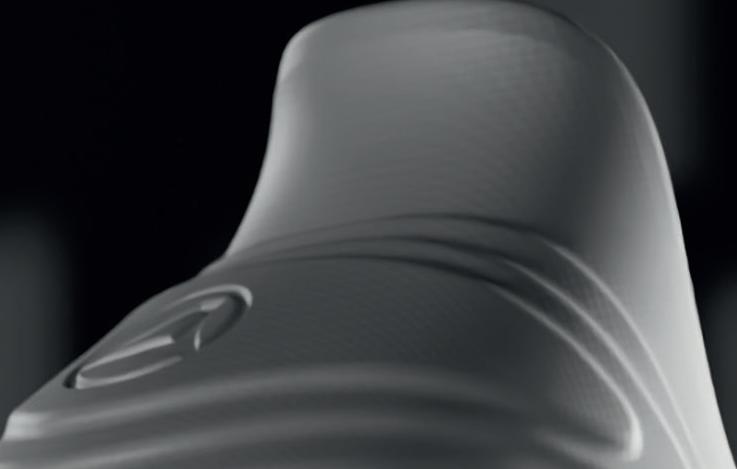



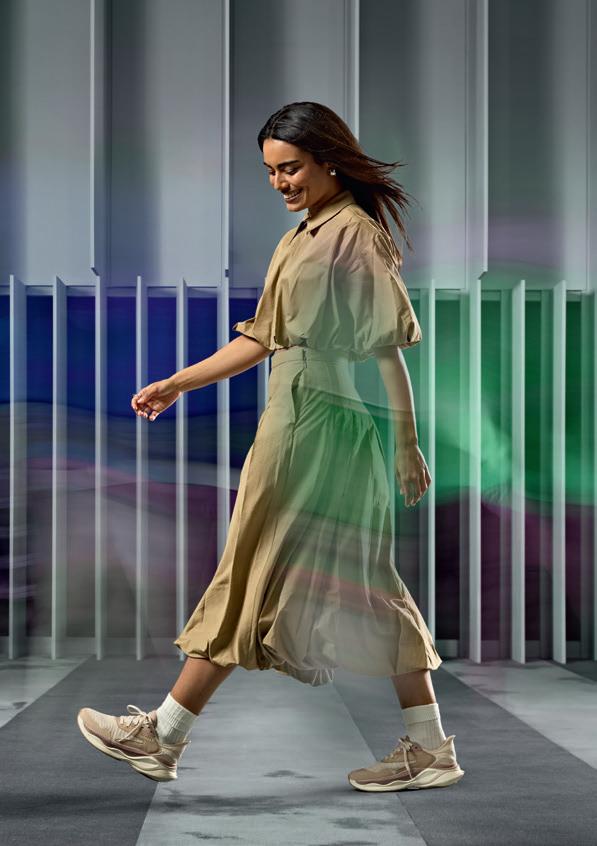
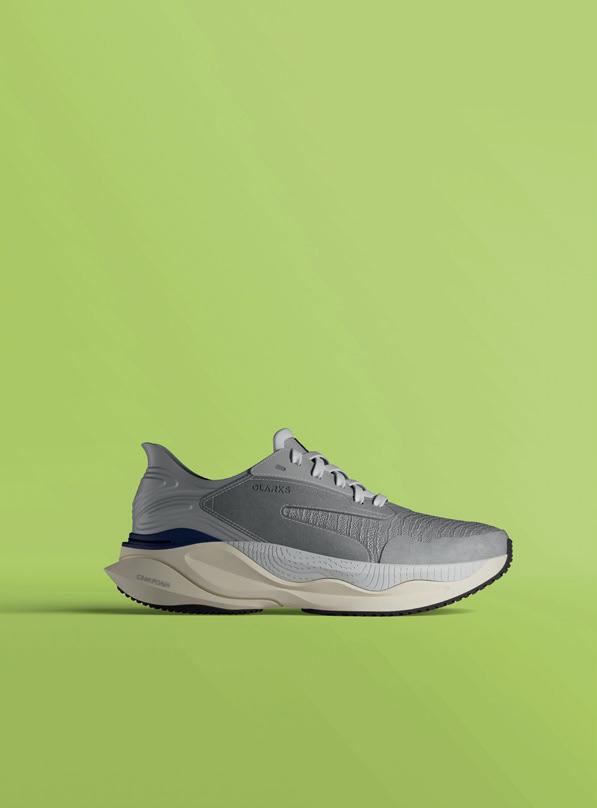




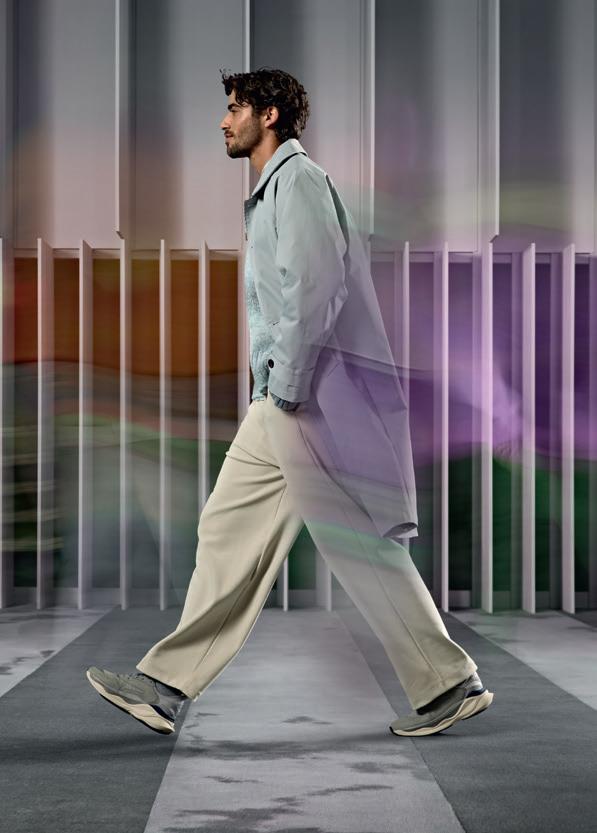
Because walking is different to running –your shoes should be too.

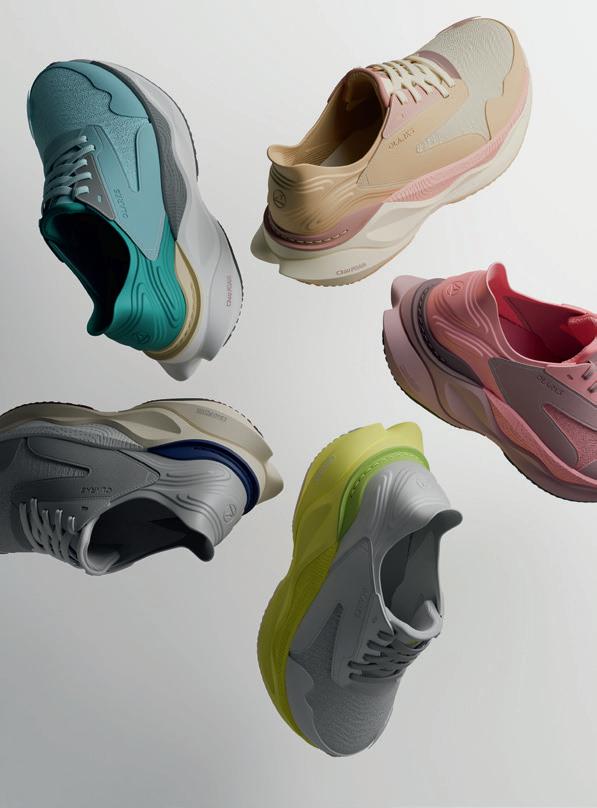

Because walking is different to running –your shoes should be too.
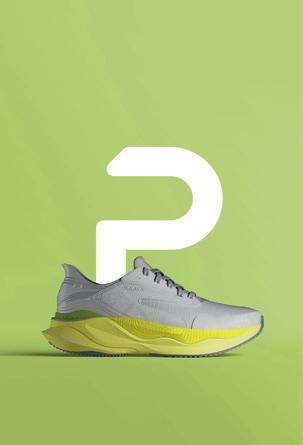

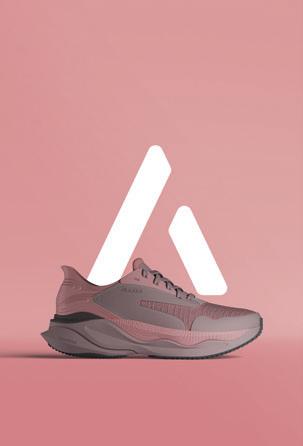


Because walking is different to running –your shoes should
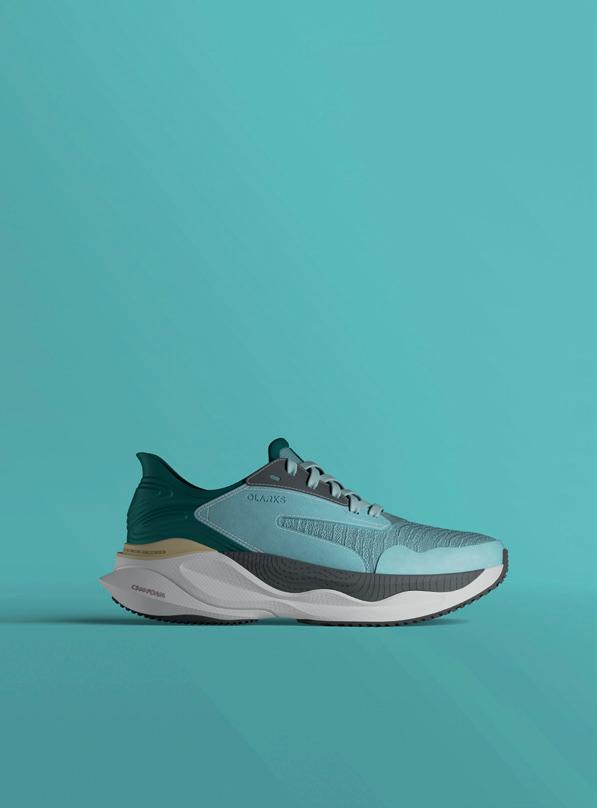
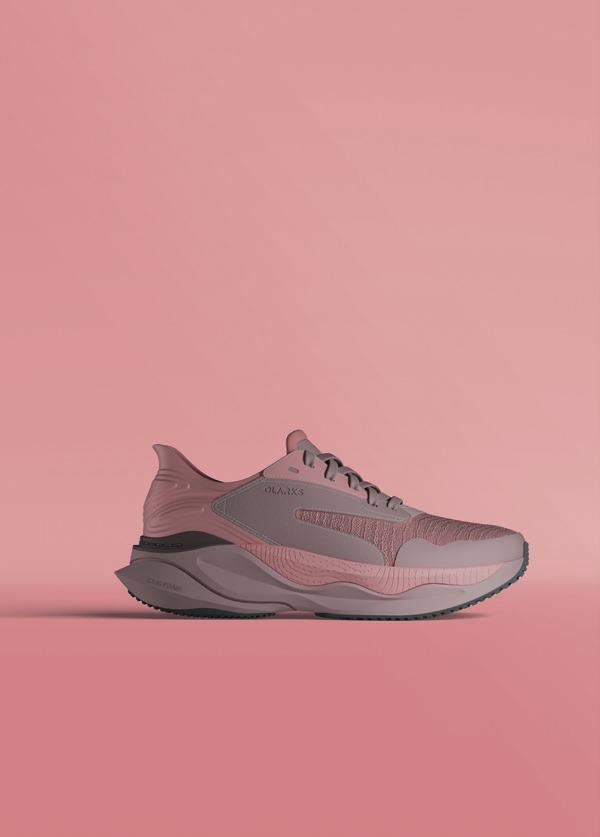
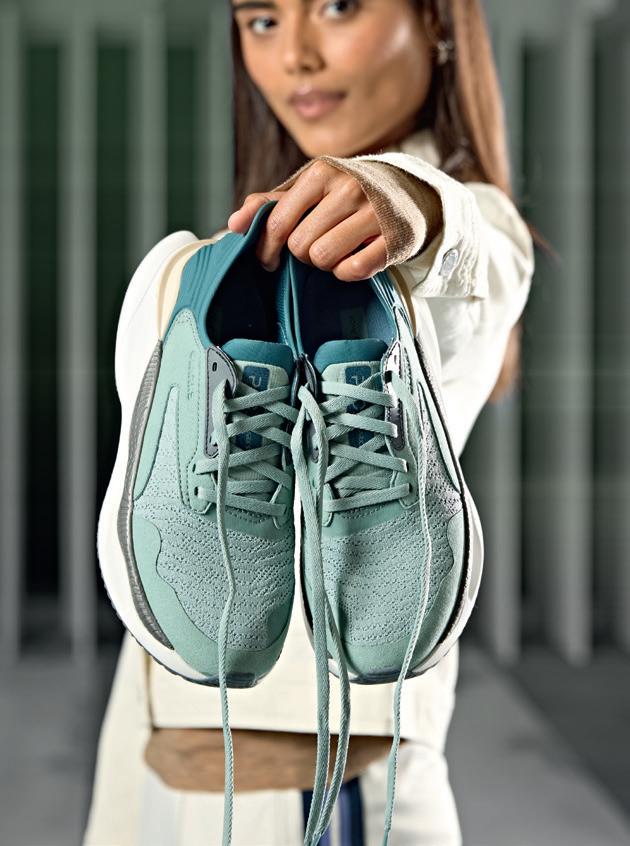
Because walking is different to running –your shoes should be too.
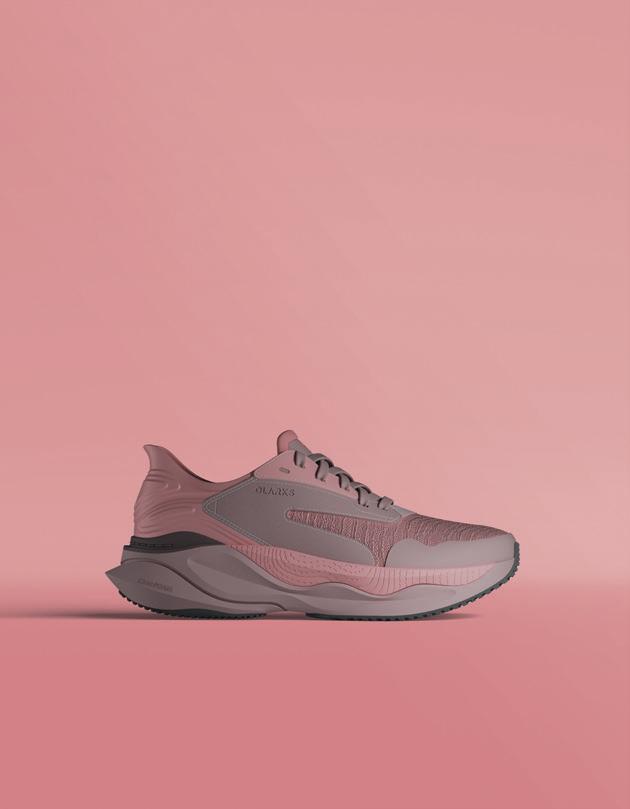

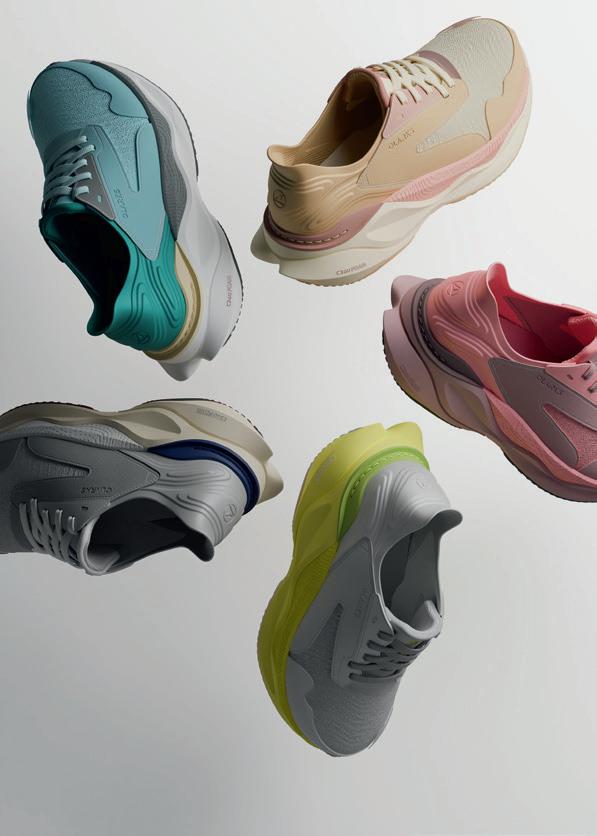
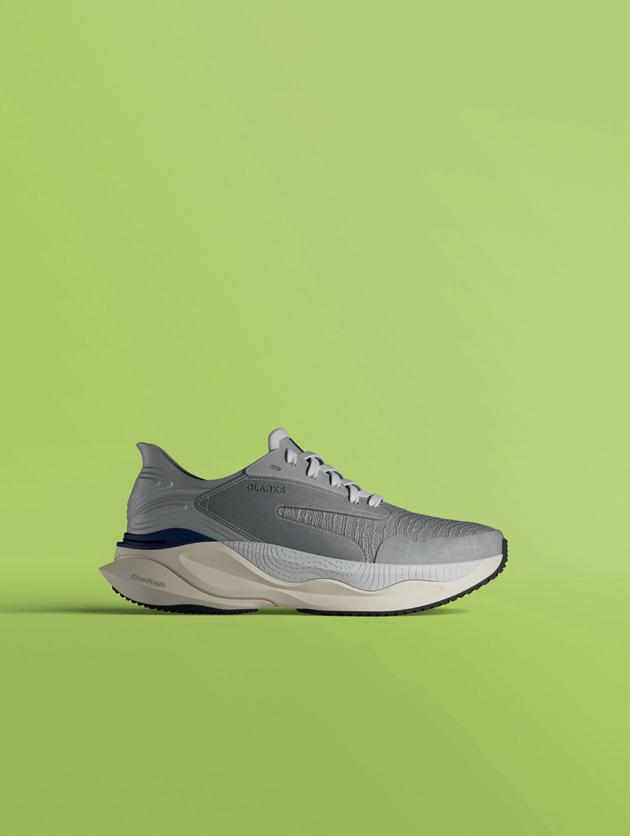

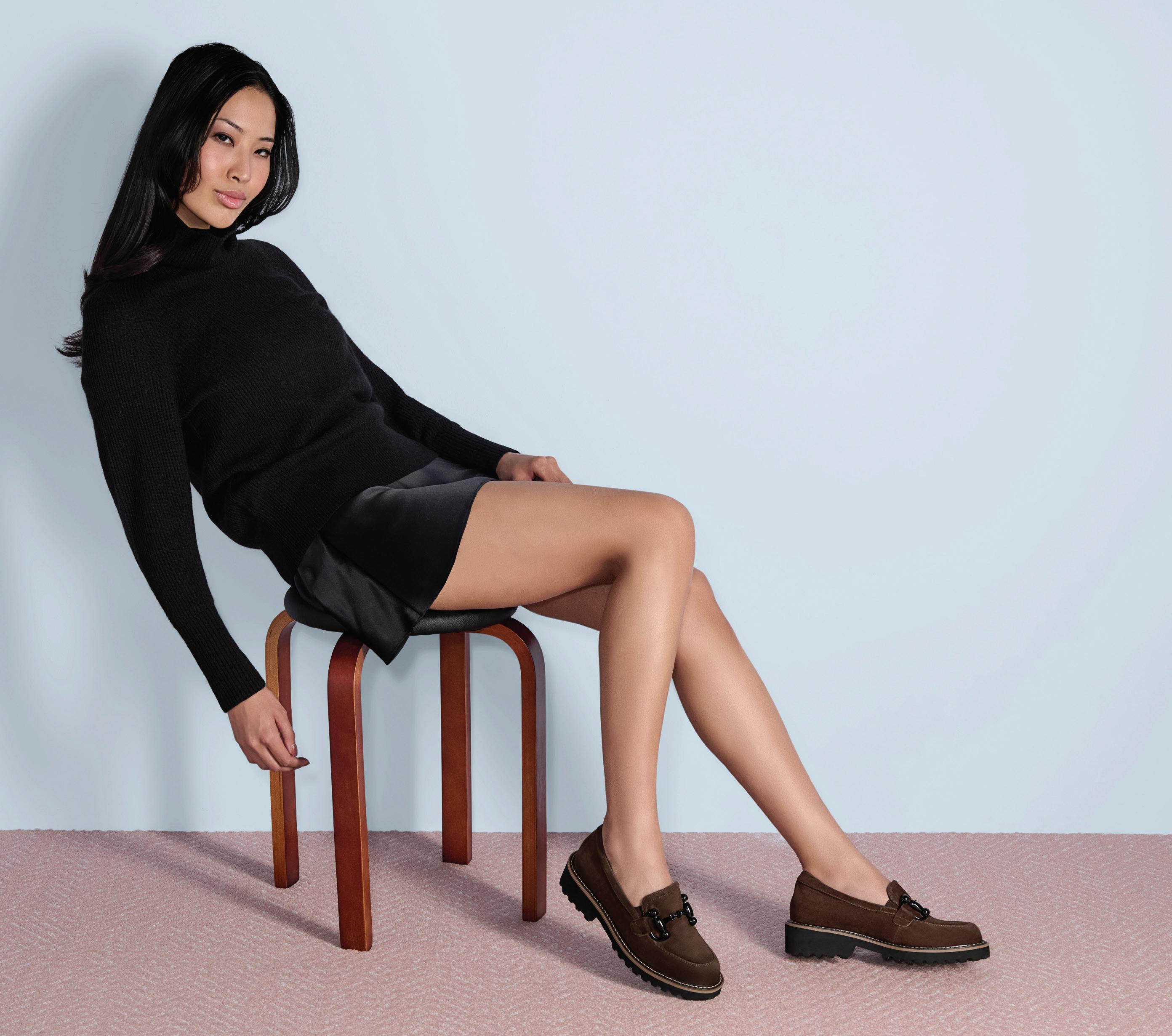


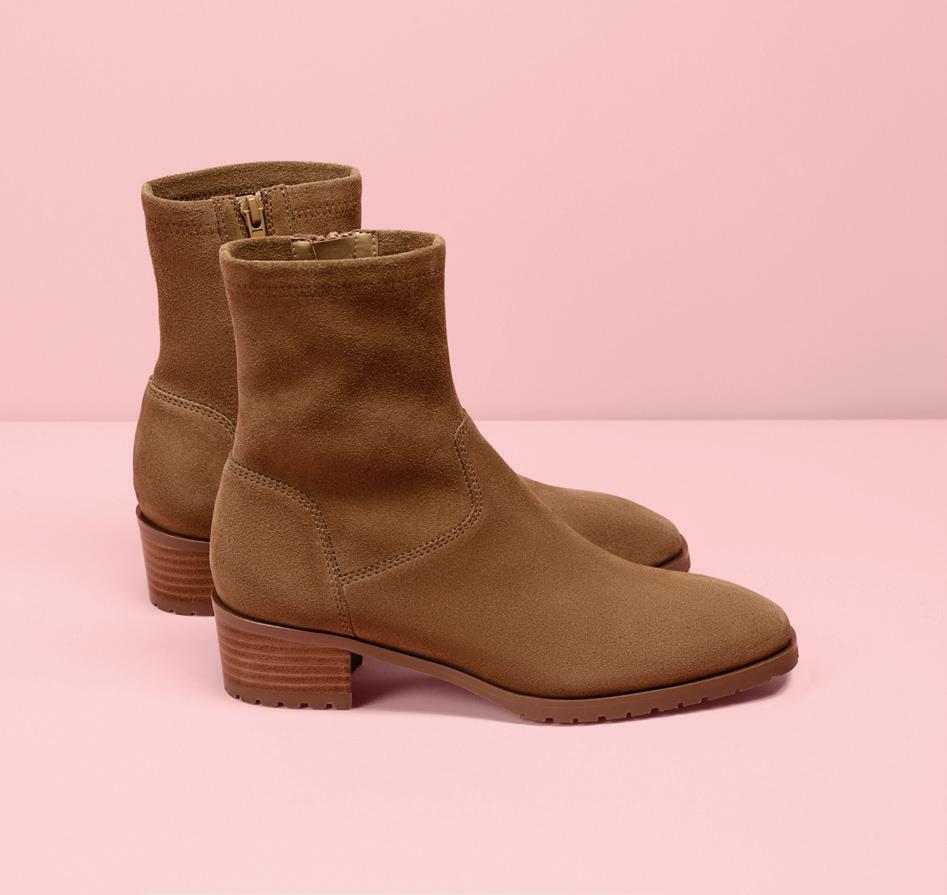

CONGRATULATIONS HAWLEY LANE
on 50 remarkable years
1o Passion Play
The Hawley Lane Shoes way: 50 years of family, fittings, and pain relief in Connecticut.
By Greg Dutter
16 Style Oasis
The Clarks Desert Boot shines as a beacon of utilitarian fashion for 75 years and counting. By Greg Dutter
20 Dream Weaver’s
At 100 years over four generations, Weaver’s Leather Store is an Iowa sitand-fit and shoe repair institution.
By Kathy Passero
24 Party Boat
Xtratuf, the 75-year-old performance fishing brand, is reeling in fashionistas and tailgaters.
By Kiernan McCormick
28 Nautical by Nature
Elements of fishermancore, coastal chic, and preppy cast a fresh spin on the classic boat shoe silhouette. By Kiernan
McCormick
4 Editor’s Note
6 This Just In: Nantucket
8 Scene & Heard
13 Trend Spotting: Boho Sandals
14 Trend Spotting: Max Joggers
15 Trend Spotting: Strappy Sandals
19 Trend Spotting: Fresh Loafers
27 A Note to My Younger Self
40 Last Shot

EDITORIAL
From left: NeroGiardini suede boat shoe with Memory foam insole; oblique toe suede boat shoe/moc hybrid by Ash
On the cover: Toms canvas deck sneakers with dual-density cupsoles and TRVL Lite outsoles; nubuck boat-inspired loafer sneakers with anti-microbial linings and removable footbeds by Dansko
Photography: Trevett McCandliss; styling: Mariah Walker/Art Department; fashion editor: Kiernan McCormick; models: Ashley Strohlein/Fenton Model Mgmt., Dennis Oehl; hair and makeup: Nevio Ragazzini/ Next Artists; photo and styling assistant: Jamie Wtorkowski.
Greg Dutter
Editorial Director
Nancy Campbell
Trevett McCandliss Creative Directors
Kiernan McCormick
Fashion Editor
Rosemary O’Connell Art Director
Kathy Passero Editor at Large
Mariah Walker Style Director
Darby Dutter Contributing Editor
Melodie Jeng
Marcy Swingle
Contributing Photographers
ADVERTISING
Noelle Heffernan Publisher Laurie Guptill Production Manager
Kathy Wenzler Circulation Director
Maria Martucci Office Manager
Mike Hoff Digital Director
WAINSCOT MEDIA
Carroll Dowden Chairman
Mark Dowden President & CEO
Steven J. Resnick Vice President & CFO
Lizette Chin SVP/Group Publisher
OFFICES
ADVERTISING/EDITORIAL
One Maynard Drive Park Ridge, NJ 07656
Tel: (201) 571-2244
Ads: Noelle.Heffernan@ Wainscotmedia.com
Editorial: Greg.Dutter@ Wainscotmedia.com
CIRCULATION
One Maynard Drive Park Ridge, NJ 07656 Tel: (201) 571-2244 Circ@Wainscotmedia.com

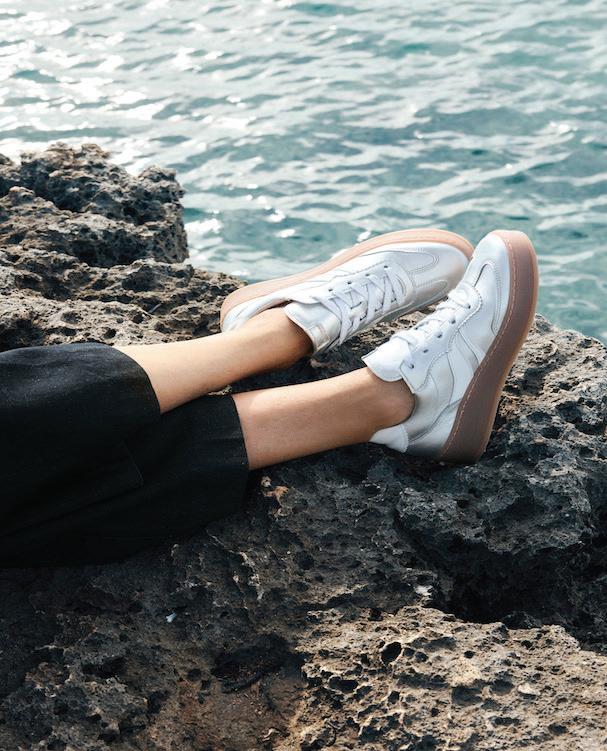
Congratulations Dave Levy & Hawley Lane! Thank you for a successful 30 year partnership.
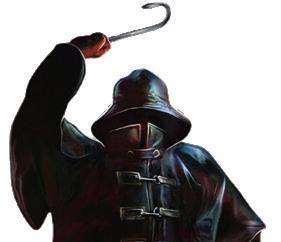

AS WE HEAD deeper into the witching season (also known by the more benign term “pumpkin spice season”), the scary question haunting many in our industry is just how spooked consumers will be over price increases largely attributed to recent tariff hikes. Will they run screaming from stores like teenage counselors at Camp Crystal Lake with a machete-wielding Jason at their heels? Or will they get a more standard horror movie jump scare, then live to keep on shopping?
The script, of course, is still being written. We’re at that middle point in the classic horror movie format when the monster (higher prices) has revealed itself and we’re all waiting to see who the next victims might be. Consumers aren’t the only ones in danger, by the way. There was no shortage of fear and dread among wholesalers and retailers at The Atlanta Shoe Market last month. They, too, could become part of this killer’s body count. Many brands are already skating on paper thin margins and can’t weather more cost increases and/or sales decreases. Plenty of retailers are in a similarly perilous limbo, especially coming off what many report as a soft spring and summer sales season. Some suggest that consumers have already tipped their shoe shopping hand, frightened off by frequent Casandra-like news reports of higher priced consumer goods and general economic dread. Whatever the factors, the margin for error is now sharper than Michael Myers’ knife.
So how does one attain the coveted “final girl” status in this movie? (For non-horror movie aficionados, the final girl is the protagonist who survives against the odds.) As Scream revealed, there are certain rules to making it through a slasher film alive. I believe there are similar rules for surviving this real-life scary movie. They involve authenticity, perseverance, passion, loyalty, originality, consistency, and hard work. These qualities are plentiful among this issue’s Milestone profiles of Hawley Lane Shoes/50 years; Clarks Desert Boot/75 years; Weaver’s Leather Store/100 years; and Xtratuf/75 years.
take the sting out of the long hours and many frightful trials and tribulations. And no matter what might be lurking around the corner, the chain’s ability to put smiles on customers’ faces through expert pain-relief fittings is a smart survival strategy.
Originality and authenticity define the Clarks Desert Boot (p. 16). Considered the first casual dress shoe, the iconic chukka boot with its signature crepe sole has been adopted by legions of trendsetters over the decades. To borrow a concept from the horror movie format, the cooler and more likeable the character, the more likely they are to survive. (A then-unknown Johnny Depp in A Nightmare on Elm Street is a notable exception.) The fact is the Clarks Desert Boot works on many levels, from the utilitarian design that made it the preferred choice of British soldiers serving in Africa during WWII to the lightweight comfort that has made it de rigueur for anti-establishment crusaders the world over. Indeed, chameleon-like versatility is its best survivor trait.

Take (p. 10) the passion exhibited by Hawley Lane Shoes co-owners Dave Levy and Joe Gradia, for example. Keeping the five-store, Connecticut-based, sit-and-fit chain thriving is a 24-7 endeavor. But that’s perfectly ok since this is a family business in every sense of the word. From the merchandise to the third-generation ownership to the 70-person staff to the many firstname-basis customers, Hawley Lane Shoes’ family first philosophy helps
Similar attributes apply to Xtratuf (p. 24), the performance fishing brand that has successfully expanded its product line and is reeling in a rapidly growing audience of tailgaters and fishermancore fashionistas. Whether the wearer is on a boat in the Bering Strait in below zero conditions with icy waves splashing topside or stomping in puddles in a neighborhood park, their feet will stay dry, warm, and protected. That’s consistency. What’s more, the brand refuses to turn its back on its core retailers. Matters like distribution, deliveries, and inventory management are top of mind with that base despite the company’s newfound popularity. That’s loyalty. Both are final girl-worthy attributes.
Last but surely not least, there’s Weaver’s Leather Store (p. 20) in Buffalo Center, Iowa, population 839. The fourth-generation, family-owned sit-and-fit retailer and shoe repair operation personifies the qualities of loyalty, consistency, passion, authenticity, perseverance, originality, and hard work. In fact, Weaver’s has earned Jamie Lee Curtis–level final girl status. Nothing scares this family, and its steadfast determination to adapt and thrive while holding on to its core values and traditions is the stuff hit movies are made of.
On that note, I can’t help but hope at times that this past year will turn out to be a really bad dream, and that we’ll all wake up soon. I hope the cruel fallout from unproven macro political policies will disappear. Alas, it feels like horror movie monsters are running amok right now. It’s a scary, scary world. So, here’s to you all achieving final girl status in the ongoing frightfest. Stay strong and whatever you do, don’t say, “I’ll be right back.”
Greg Dutter Editorial Director

Congratulations on these remarkable milestones:
Years
Wishing you continued success!
Years









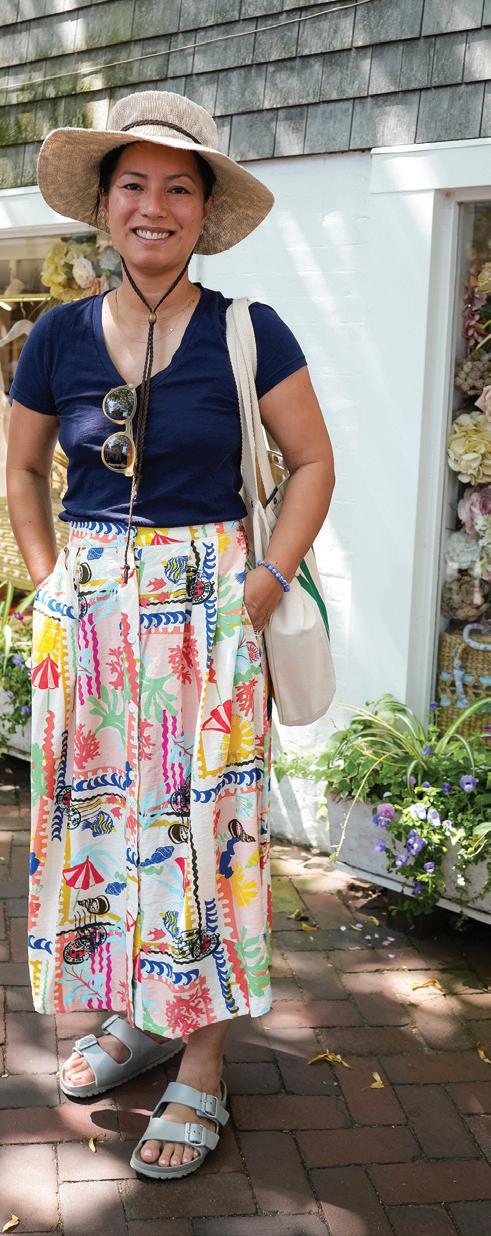


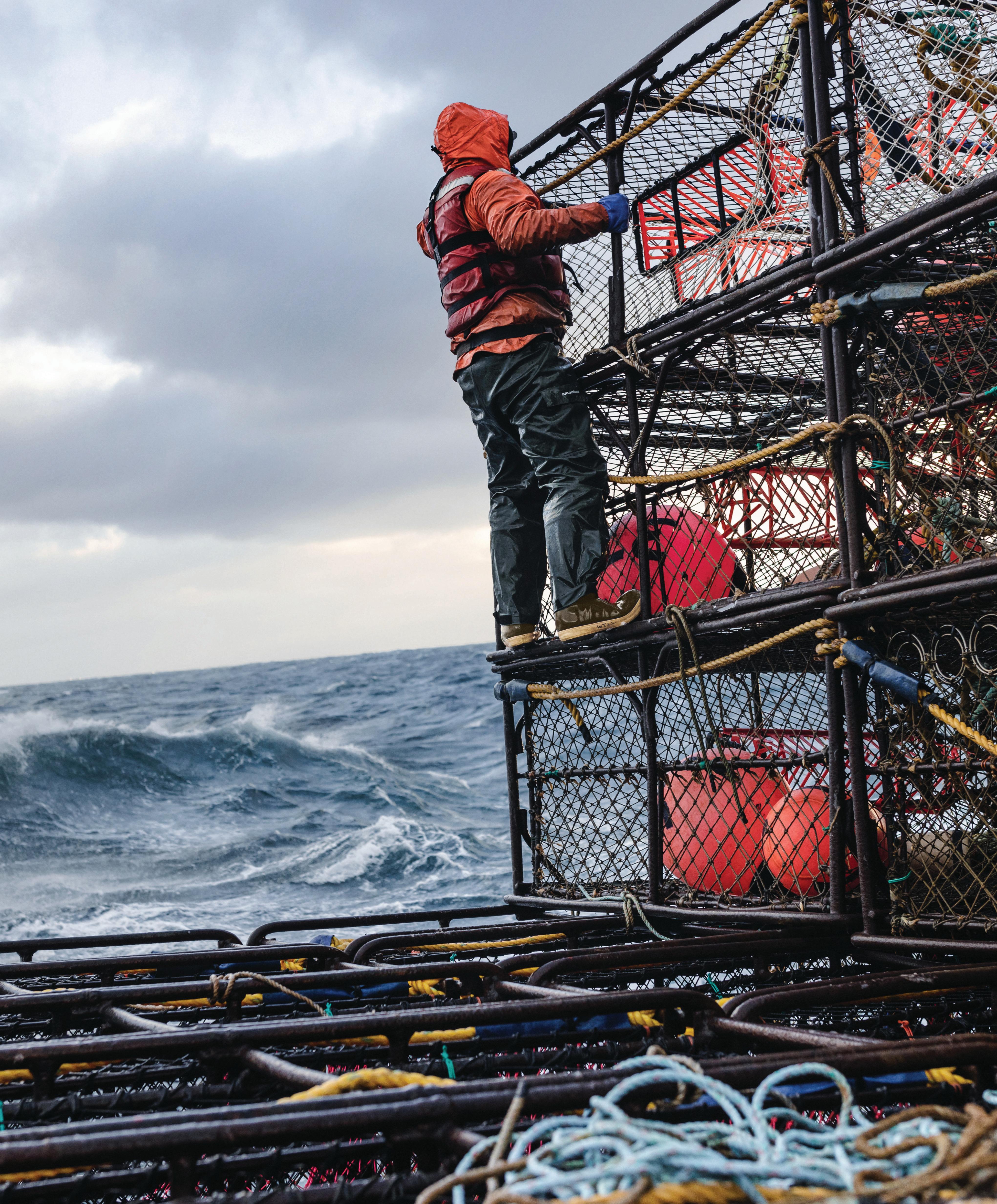

XTRATUF has been making rugged and reliable footwear for 75 years. From fishing in the Bering Sea to surfing in Nazaré or camping in Moab, XTRATUF footwear is Built For All. Featured Product: Legacy Boot, 22272G
The Atlanta Shoe Market served as the setting for writing orders and tariffs-infused tension.
THE ATLANTA SHOE MARKET (TASM) once again drew the largest array of exhibitors (1,800 brands, give or take a few) and buyers (from all tiers and nationwide) under one roof last month at the Cobb Galleria Centre. Plenty of orders were written, but the proverbial elephant bounding up and down the aisles had to do with tariffs. Specifically, what the rates might be and how consumers will react to the higher prices of many fall goods. Coming off what has been largely considered a soft spring and summer season at retail, the concern is another down season could have dire consequences.
“Most of the independent retailers I work with say their business is down 20 to 40 percent,” says Tony Adams, president of Hälsa Footwear. “I call it the ‘Lipstick Recession.’ During the Great Depression, women couldn’t afford shoes or clothing, so the cheapest thing they could buy was lipstick. That’s what’s happening now.”
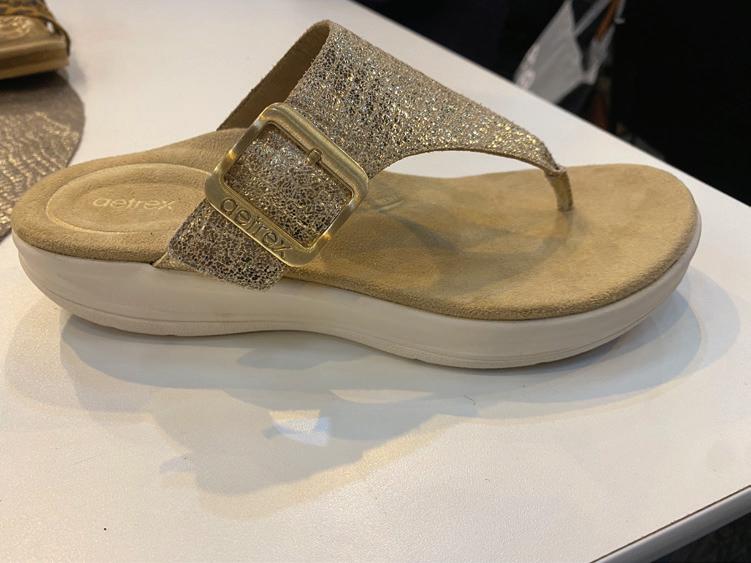
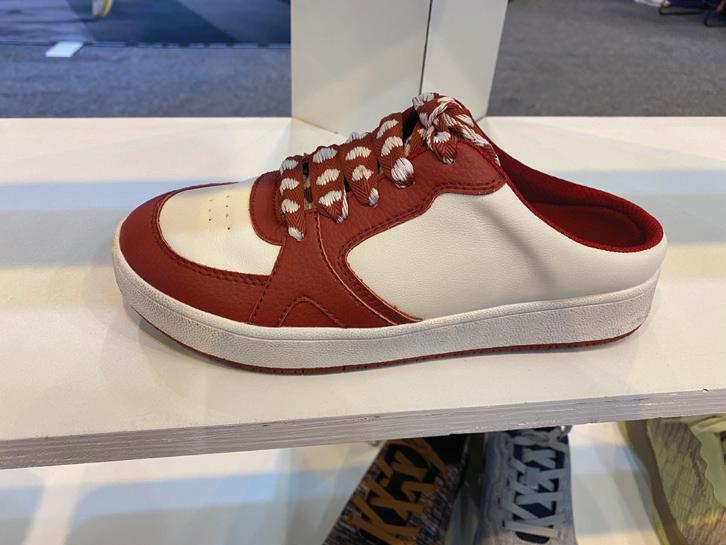
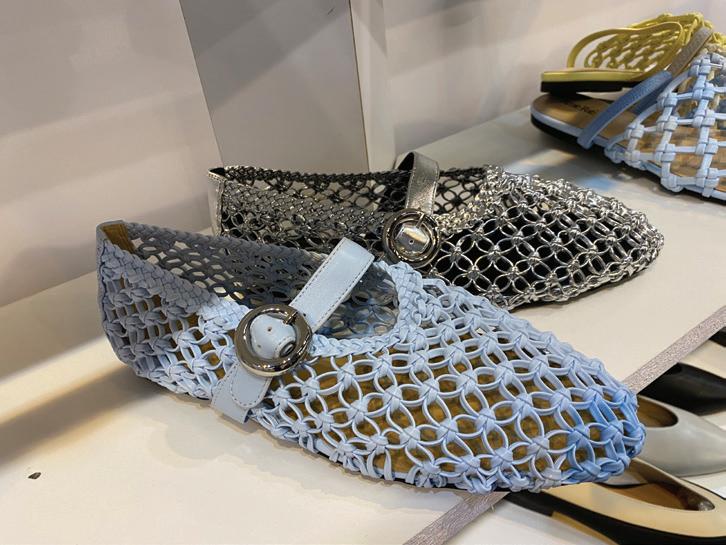
Bill Langrell, president/ COO of Taos Footwear, says the jury is still out on how consumers will react to paying more for all sorts of goods beginning this fall. “Prices will be higher in shoes generally, and then we’ll find out what the consumer really thinks,” he says. “We project a softer fall until she absorbs it and gets back to her normal shopping habits later next year.” Making matters even more challenging, Langrell says the general uncertainty is making a lot of brands and retailers play it safe. That leads to less innovation and plenty of sameness on store shelves. “There’s a herd mentality in this industry, and every now and then the herd catches up and everything looks the same. We’re in the phase now,” he says. “Retailers are starting to complain that everything looks the same.”
Despite those headwinds, Langrell reports that Taos is coming off its best Spring/Summer season in its 20-year history. “We’ve been staying ahead of the herd and not getting trampled,” he says, citing a record sandal season and fresh colors on best sellers as top sellers. To that end, he says Taos will keep being Taos, tariffs be damned. “Unless retailers are going to close their doors, they need to buy quality footwear, make good margins, and offer styles their shoppers are seeking. That’s what Taos offers.”

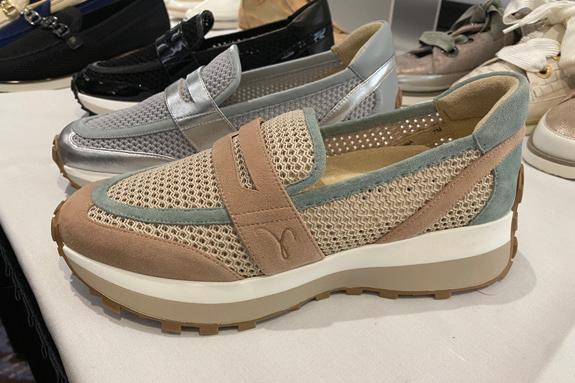
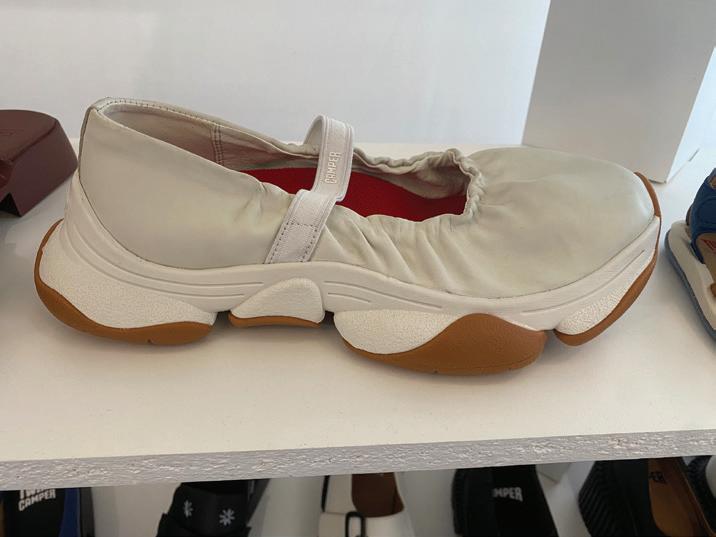
James Rowley, CEO of Woolloomooloo, says the good news at TASM was the retailers came to write orders. The bad news is many focused on brands they already do business with and on “straightforward” styles. “Many are risk-adverse amid all this uncertainty,” he says. “They don’t know what the pricing will be, nor do they know how the consumer will react to higher prices in general beginning this fall. So many are playing it safe.” That aside, Rowley says the show was a success for the wool-based athleisure brand with 52 appointments booked and a handful of walk-ins. “It was a good show,” he says, adding that accounts that take a chance on the brand discover the product sells.
“We’re a relatable, natural material story that has comfort and eco-friendly aspectss. Plus, our shoes can be tossed into the washing machine and come out like new. That has added value for customers, which is even more important aspect these days.”
One way to assuage the fears of higher prices is to hold them as best possible. That’s the approach taken by Michael Abrams, senior vice president of sales for Lady Couture, Ninety Union, and Ashley Kahen brands. “We’re trying to keep prices as close to last year as possible,”
he says, noting the company is primarily a reorder business. “If retailers are buying a shoe for $10 and there’s a 30 percent tariff on it, that’s $3 more and works out to about $7.75 more at retail now for basically the same shoe. That’s why we’re trying to keep the prices down as much as we can.” While his expectations going into TASM were “very low,” his booth received a lot of traffic and retailer appointments all showed up.
Amelia Noorani Apoj, cofounder and chief of creative for Amie Rafa, also went into the show hedging her bets. “Retailers aren’t buying as much because they’re cautious about how customers will react to the prices,” she says, noting many brands have increased prices. “We’re lucky to have long relationships with our factories, and we’ve been able to absorb passing on significant increases.”
With lots of buyers playing it safe, Kevin Bosco, president of Bos. & Co., says a key strategy behind its Spring/ Summer ’26 collections (Bos. & Co., Asportuguesas, Fly London, Softinos, and Ambitious) was fresh updates on established collections. “Heritage styles are likely more impacted by price increases—as in, why does the same shoe cost $20 more,” he says. “That’s a harder sale, so we reengineered some collections so it’s not the ‘same’ shoe.” For example, Fly London introduced rubber soles in its dress collection for improved comfort and practicality. Freshness was also added. A brand known for wedges, Fly London introduced a platform sandals collection in eye-catching patterns, colors, and materials. “It’s about simplified, fresh, and new,” Bosco says of its latest collections.
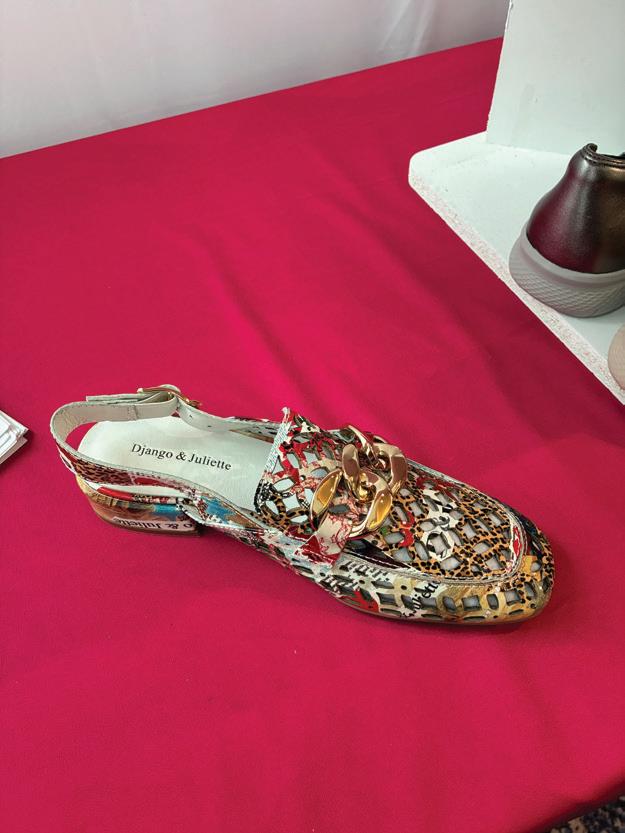
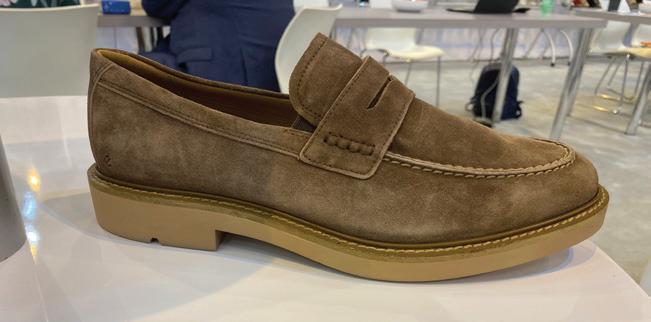

It pays to be a heritage brand amid such times of uncertainty, says Ron Owens, brand manager of Dingo. The western lifestyle brand is coming off the heels of its best July in its 56-year history. “Eight out of 10 consumers buy a heritage brand over a new one,” he says, noting the spike in sales was fueled largely by its Vintage collection of ’70-era leather platform boots that debuted in June. “It just exploded.” Owens adds, “Leading up to the launch, lots of young women had been shopping vintage sites and stores for these type boots that Dingo made back then. We were confident the collection would be received well, but it’s been beyond our expectations.” Another factor contributing to Dingo’s momentum is the growing popularity of country music and western lifestyle in general. “Beyonce’s recent Cowboy Carter tour took it to a whole other level,” he says.
Contrary to playing it safe, Josh Habre, CEO of ERHCo, distributors of Django & Juliette and Ziera, reported a strong show as buyers gravitated to its unique styles. “The show was incredible; we opened seven accounts on the first day,” he says, giving credit also to a high-traffic location outside the main floor.
“Retailers gravitated toward items that they didn’t see everywhere else—unique uppers, embellishments, colors, materials, and constructions. Also, versatile, comfortable styles that aren’t necessarily sneakers and pair well with wide-leg jeans and casual tank tops that a lot of women are now wearing.” Habre adds,
“The creative focus is on the shoes and bags—that’s what’s adding spice to outfits.”
PJ Popes, sales director for Vaneli, concurs that unique looks outweigh marginal price increases.


The booth was booked with appointments on set-up day straight through the last day. “Pricing doesn’t seem to be too much of a concern, because pretty much the whole industry has increased pricing and we still come in at an attractive price,” she reports. “But what really helps is our upgrade in style over the last few seasons. Great product means there’s less price concern, and customers have been reacting very strongly to our recent collections.”
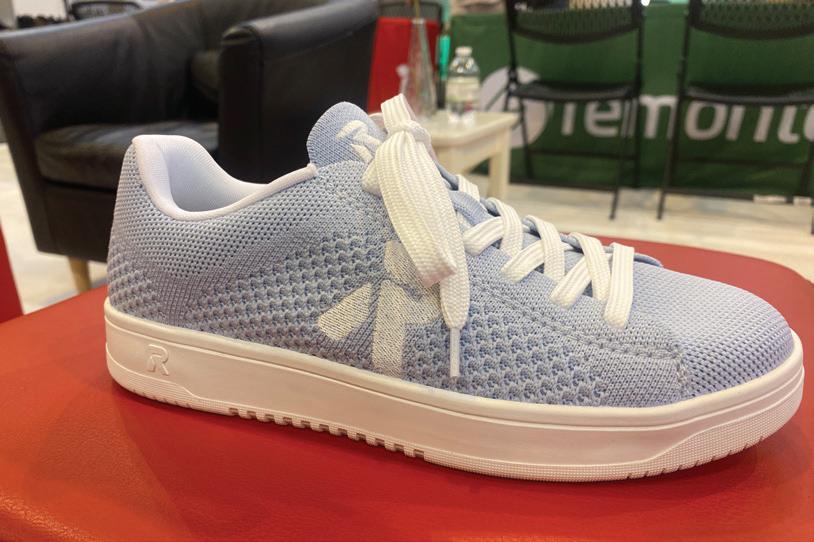
Come February when the industry reconvenes in Atlanta a lot may have changed. One change for sure: the show’s floorplan as the Cobb Galleria Centre will be in the midst of a $210 million renovation. The registration desk will be in the rotunda at the entrance to the Cobb Galleria Centre and the 40 or so brands housed in store spaces, meeting rooms, and booths will move to the second floor of the adjacent Renaissance Waverly Hotel. TASM’s lunch venue will also move to the hotel.
Show Director Laura Conwell O’Brien says the layout will have a silver lining for brands exhibiting in the Grand Ballroom and Garden Court as attendees will pass by on their way to and from the lunch venue. “We serve about a 1,000 people a day, and the only way to get there is the escalator through the Garden Court near where those brands will be exhibiting,” she says. “Those will be very viable areas.”
And when February 2027 show dates roll around, TASM will be housed in an updated space, including a new junior ballroom, two outdoor garden areas, and 13,000 square feet of additional meeting space. “It’ll still be under one roof and also the most affordable shoe trade show,” Conwell O’Brien says.
The Hawley Lane Shoes way: a half century of family, fittings, and pain relief.
By Greg Dutter
AWLEY LANE SHOES, a five-store, Connecticut-based sit-and-fit family chain, isn’t just a job for owners Dave Levy and Joe Gradia. It runs much deeper than that. The two, who became best friends at age nine and business partners in 2005, are on a dual mission. One: to keep the shoe retailing legacy that Levy’s grandfather (Jack Smolensky), mother (Sandy Levy), and uncle (Bob Smolensky) built alive and thriving. Two: to alleviate shoe-related pain for as many people as possible—whenever and wherever they come across it. The two missions combined are a way of life, 24-7, for Levy and Gradia.
“What we do goes above and beyond the 60-hour work weeks that we regularly put in,” Gradia says. “It’s just part of our daily lives. We see something and we address it. It’s not monetary-driven, really. It’s something that we were gifted by the people who built this business, to take away pain, that we share. We never get tired of doing that.”
Case in point: “I embarrass the hell out of my kids all the time when I walk up to someone on the street because I can see that there’s something wrong with their knee or foot,” Levy says, noting he’ll introduce himself, ask if they’re in pain, and then say he can help eliminate it. “It’s almost a daily event. You wind up helping a lot of people just by meeting them in the Starbucks line.”
As for the conversion rate, Levy gives each person his cell number and “I’d say one out of 20 contact me, but that adds up.”
Gradia performs similar on-the-street outreach efforts, but it’s the mission of keeping the family legacy alive that he remembers first each morning. “I made a promise to Sandy that I’d do everything in my power to help keep this family business legacy going,” he says, describing her as a second mom. “Each morning, I look in the mirror and say I’m going to give it my best.”
That’s the passion fueling Hawley Lane Shoes, and it trickles down to its 70-plus employees. This is a family business, first and foremost, Levy says. It starts with treating employees like they’re family.
Case in point: A new employee recently suffered the loss of her father. Levy and Gradia, who recently lost their mothers, understood all too well what that feels like. They sent her an edible arrangement from the entire Hawley
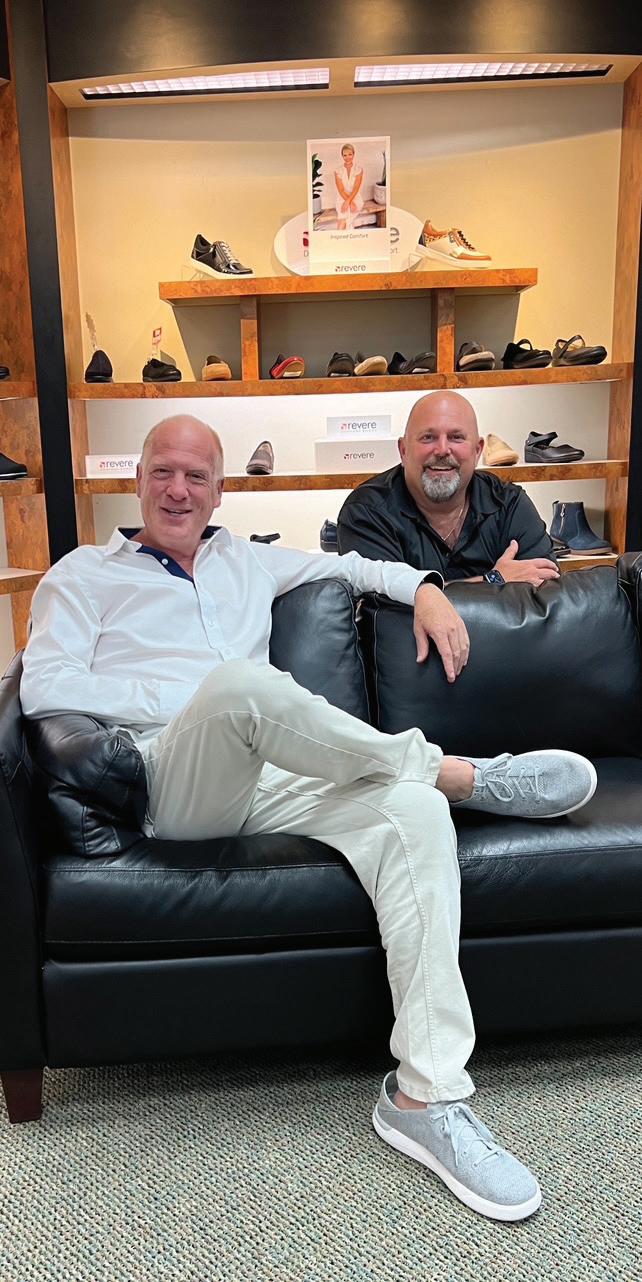
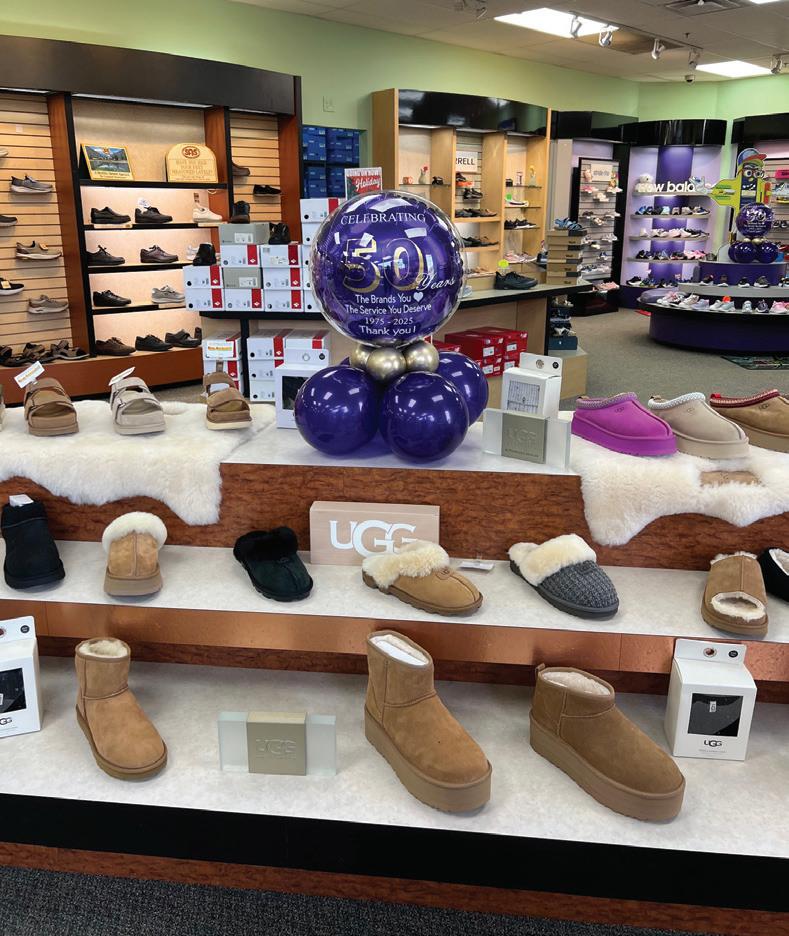
Lane Shoes family. It meant a lot. “She thanked us for caring, and then said this is such a different place,” Levy recalls, which meant a lot to him. “We pay employees as fairly as we can but, more importantly, we treat them as well as we can. That’s who we are and what we offer. We’re not a corporate place. We’re a family.”
Sam Spears, president of Ara North America, says family is the first word that comes to mind whenever he thinks of Hawley Lane Shoes. “They are community family stores, offering shoes for customers nine days old to 90 years old, plus accessories and orthopedic devices that allow people to be pain-free and independent,” he says. “They have knowledgeable staff that can confidently and accurately assist with the right shoe for prom or plantar fasciitis. They also support community charities, hospitals, and schools. They see everyone that comes through their doors as family.”
Hawley Lane Shoes employees are trained to go above and beyond to make everyone who enters feel like a guest in their home. It starts with a warm greet-
ing, offering a complimentary cold drink or coffee, and an expert fitting. Levy says it’s really the only way to stand out these days. “We have to put aside the fact that we sell commodities, because pretty much everyone carries Hoka, On, Birkenstock, Ugg, etc.,” he says. “So we have to make sure we’re consistent in offering everyone who enters those extra niceties on top of our expert fittings. It’s hard to do, but we have to elevate ourselves constantly to be different and exceptional.”
Exceptional customer service even extends to the occasional house call. Like the customer who recently suffered a stroke. Gradia brought Hawley Lane Shoes as best he could to the man’s house. “We fitted him properly, and then he started walking without his walker,” he says. “It was amazing. That’s what keeps us going.”
The reward of helping people makes combatting the daily grind of running a retail business worth it. Challenges include finding and retaining good employees, dealing with rising fixed costs, and competing with brands selling DTC, not to mention outside forces like the economy, a pandemic, a trade war, you name it. “It’s a constant uphill battle, but what brings a smile to our faces is being able to change people’s lives—and putting a smile on their faces—by giving them a custom fit and taking away their pain immediately,” Gradia says.
In fact, such success stories are how Hawley Lane Shoes kicks of its weekly Wednesday morning conference calls. Each store manager shares an interaction with a customer that was especially helpful. “It’s so rewarding and motivating to hear so many testimonials about how we helped alleviate their pain with proper fittings and shoe recommendations,” Levy says. “Someone has Parkinson’s, a kid who has a hard time ambulating, a bone spur…it’s awesome to hear how we changed and enhanced their lives.” Levy adds, “Every single testimonial represents that goal; it’s part of our DNA.”
One such testimonial, emailed recently, really pulled at the team’s heartstrings, but it wasn’t pain relief related. The email read: I’m a single mother of four and every dollar matters when it comes to taking care of my kids. Back-to-school season can be overwhelming, but this year it was different because of Hawley Lane Shoes. They are the only store during tax-free week in Connecticut that truly understands what saving means for families like mine. They go above and beyond with no limits, making sure that every child who walks into the store, walks out with confidence on their feet. I will never forget the smiles on my kids’ faces when they each got a brand-new pair of shoes. It wasn’t just a purchase; it was a blessing. From the bottom of my heart, thank you.
“This is the stuff that makes you rise above tariffs, increasing overhead expenses, stress, and on and on that we face every day,” Levy says. “It’s

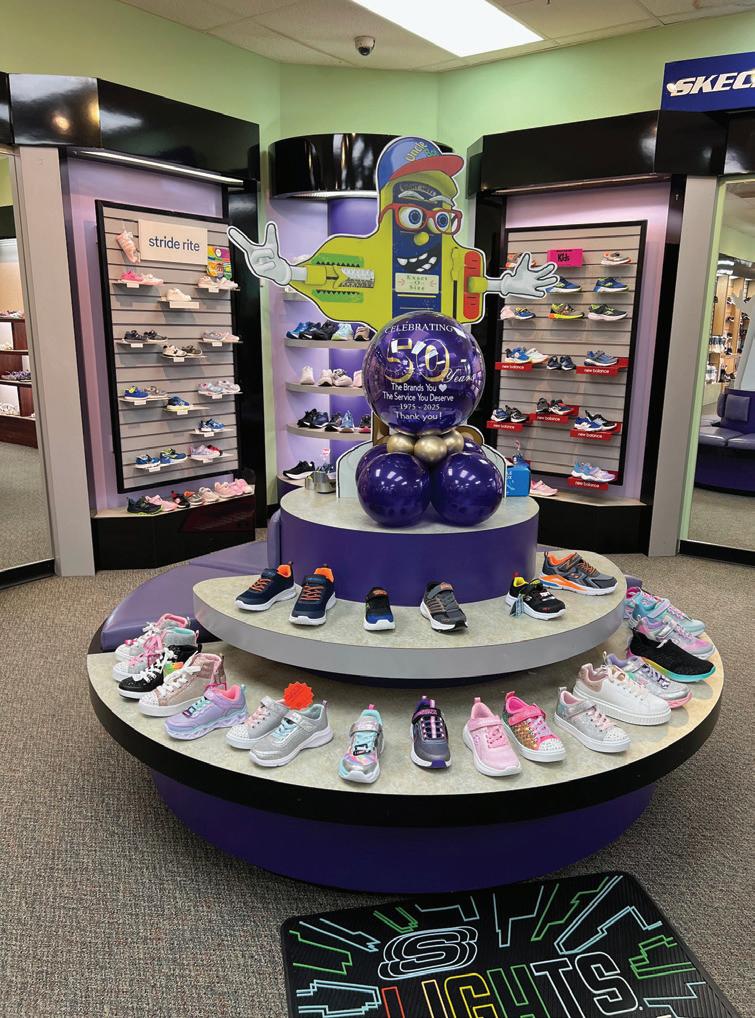
amazing to see that we made that difference in her family’s life.”
Levy and Gradia didn’t always intend to take over Hawley Lane Shoes. In fact, that wasn’t the plan at all. Out of college, Levy had dreams of becoming a power broker on Wall Street. But his footwear roots then drew him to the corporate side, working in marketing, product development, and sales at Stride Rite and Tommy Hilfiger for several years. Meanwhile, Gradia went to work for Cablevision, eventually overseeing a team of 100 employees doing installations. They remained good friends. While Levy loved the creativity and brand building aspects of that corporate world, he grew tired of the
politics. “Burned out,” he joined the family business in 2000. He wanted to get back to his family roots of helping people. Plus, the entrepreneur at heart had some growth ideas. The first step, though, was taking Robert Schwartz’s pedorthist class. “My mother and grandfather were pedorthists, so it just made a lot of sense because our family has a passion for helping people,” he says, noting that he was attending the class while negotiating the lease for the second store in Norwalk. “A year after, we doubled the size of that store and then, a year later, we opened our Stamford location.”
Levy hit the ground running. But it wasn’t until his old friend became a satisfied Hawley Lane Shoes customer that he found his business partner. It was 2005 and Gradia, on his feet all day in heavy work boots, was complaining of various ailments. Levy switched him to Brooks running shoes and Gradia has been pretty much wearing the style pain-free ever since. You might say Gradia saw the light that day. “He fixed my problem and put me back on track,” Gradia says. “Just to know that is something that we can do is priceless, because 86 percent of Americans are wearing the wrong-sized shoes. They’re living this discomfort every day and they don’t have to.”
The two had often talked about potential business ventures together and realized the best one was staring them in the face. Having grown up together and working in Hawley Lane Shoes stockrooms, they knew the business and were deeply tied to it. So they sat down with Levy’s mother and uncle and mapped out a next generation ownership plan. “Joe has basically carried the business since,” Levy says, adding, “A lot of why he did this was to help carry on my mother’s legacy. That means the world to me.” Adds Gradia, “From the start, we envisioned growth and more stores to keep the family business going, even if we had no idea of the tremendous challenges and obstacles we’d face. But somehow, we’ve made it happen, because that’s what we do.”
A key to Hawley Lane Shoes’ half century of longevity is its ability to make strong connections with customers and the communities (Danbury, Stamford, Norwalk, Shelton, and Orange) where the stores reside. The chain is a regular supporter of public-school music and sports programs. Another community outreach highlight, which Levy plans to reintroduce, was the program his mother spearheaded in 2019 to send disadvantaged kids to summer camp. Rather than just cut a check, Hawley Lane Shoes reached out to brands for product donations while encouraging Norwalk High School students to fundraise through bake sales, a raffle, a walk-a-thon, and a kids’ concert. “My mom wanted to give kids a purpose in their lives by helping raise money so they could help fund
Fifty years of Hawley Lane Shoes history comes complete with many interesting tidbits, facts, and figures.
NEW YORK ROOTS: The first family store was located in Port Chester, NY. The move to Connecticut began with the opening of a store by Dave Levy’s uncle, Bob Smolensky, in 1975, in Trumbull.
WHAT’S IN A NAME: The Trumbull store was located in the Hawley Lane Mall. Hence, the name that stuck.
TOUGH TIMES: The Danbury store opened as the pandemic hit, the expanded Norwalk store opened on 9/11, and the Sandy Hook school shooting happened near the Shelton store. Many customers lost family members on 9/11 who worked on Wall Street, and one of their employees was related to a teacher killed in Sandy Hook.
HARD TIMES: The business is “totally harder” than 25 years ago. “The constant uncertainty creates uncertainty in customers, which is exhausting,” Levy says. “They spend less, or once they get their credit card bill, they make returns.” Worse, overhead costs are skyrocketing. It’s the biggest challenge currently facing the business. “They’re just out of control,” he says, citing a recent $8,600 electric bill for the Shelton store that most recently was $6,200.
GOOD TIMES: Hawley Lane Shoes is on a first name-basis with many of its customers. “It’s like Cheers ,” Levy says. “That connection and friendship has always been our goal.”
DELIGHTFUL DESTINATIONS: No employee sells a shoe until they complete three weeks of training by Levy, Gradia, and three trainers. The overriding goal is constant improvement. “We’re striving for next-level service where it’s, ‘Wow, that was a delightful experience. I don’t want to go anywhere else.’”
IRONMAN AWARD: Robbie Mannino has been with Hawley Lane Shoes since 1978. Next is Paul Curry, who clocks in at 28 years. “We have two others at 20 years and a bunch who’ve been with us for 15 years,” Levy says.
DTC DRAMA: Levy doesn’t dwell on what he can’t control. At the same time, the team is trimming its brand roster with the goal of “reasonable” partners. “We look for dating, marketing, and margins,” he says. “Relationships are key, because, God forbid, if we ever need help, or we have an opportunity we want to run by them…we can pick up the phone and, if it makes sense, we have a partner who says let’s go for it.”
BRIGHT IDEA: A pandemic silver lining for southwestern Connecticut retailers was the mass migration of New York City residents. Seeing them as potential new Hawley Lane Shoes customers, Levy bought new resident mailing lists near its stores. “Twenty percent of our business for two years during Covid were new customers,” he says. “It was a no brainer idea, but it really worked.”
other kids’ summer camp dreams,” Levy explains. “The kids raised enough funds to send 52 kids to camp that summer.”
Birkenstock Americas President David Kahan cites Hawley Lane Shoes’ community outreach, along with the “simple premise” of providing great product and great service, as keys to its long-running success. “Dave and Joe share a passion for the business, and they’re very engaged in their communities,” he says. “They know product and they’re a step ahead on anticipating shifts in the market.” Another key, Kahan says, is serving families across all ages and the ability to build and maintain long-term relationships. “They’ve shared our brand with thousands of people across Connecticut over many years and we appreciate the high level of service they provide. Our business together is exceptional,” he says.
Likewise for Edward Kanner, CEO of the Kanner Group, North American distributors of Gabor, Think!, and Emu. The partnership with Hawley Lane dates back to 1997. He singles out the chain’s ability to “adapt and thrive” under conditions that test anyone’s resolve. “It’s a testament to Dave’s resilience and smart leadership,” Kanner says, noting that Levy has become more than a business partner. “He’s been a friend, mentor, and a source of perspective in both good times and bad. He’s one of those rare people I consider a good human: humble, honest, and guided by the highest integrity and always committed to doing business the right way.” Adds Kanner, “Our Hawley Lane partnership is carefully managed and continues to show steady growth.”
Spears reports similar steady growth for Ara, noting Levy and Gradia have been instrumental in the brand’s product development, collection curation, and merchandising process. “Dave has an amazing eye for product. His trend forecasting is vital to our business,” he says, adding, “He and Joe see where a brand is and where it’s going, and build the business around that.” Hawley Lane Shoes’ customer service, inventory management, and “Swiss watch-like” invoice payments are also notable, Spears says. Last but not least, he cites Levy and Gradia’s rare business attribute of humility. “They are big fish in their area and could be real jerks to brands and customers if they wanted, but they’re respectful,” he says. “At the risk of using an overused word that has lost a lot of its meaning, Dave and Joe are partners.”
Hawley Lane Shoes has been solid partners with Taos Footwear for 15 years, reports President/COO Bill Langrell. “Lasting 50 years in this business doesn’t just happen by accident,” he says. “It takes a ton of hard work, smart decisions, and really knowing your customers. Hawley Lane has always put the customer experience first, and that’s why people keep coming back generation after generation. Their loyal customers are the reason they’ve been able to thrive for so long.”
Levy and Gradia remain as committed to Hawley Lane Shoes as the day each started. Five locations are enough, because they believe there is enormous growth potential within that reach. For starters, pain is a universal issue, and thousands of Connecticut consumers are wearing ill-fitting shoes. Levy and Gradia strive to relieve them one pair at a time.
That’s the secret ingredient to Hawley Lane Shoes’ longevity, Levy says. Namely, his family’s guiding retail principle: “We don’t sell shoes. We fit feet.” “I heard that since I was a kid—even if it meant walking a customer,” he says. “They’d rather lose the sale if it meant a customer would be buying a tight-fitting shoe.” Levy says his forebearers also did fittings for free and advised whether customers needed new shoes or not. “With that came a lot of trust,” he says. “My grandfather, mother, and uncle built the foundation of our business, and it remains 100 percent our retail philosophy.”
Gradia says the family built unbelievable relationships. “We continue to carry that baton,” he says. And while every day has its challenges, Levy and Gradia believe the ends justify the means. “Sometimes it can feel overwhelming but then, like recently, I went into one of our stores at 7:30 a.m. and saw a few employees already there,” Levy says. “That really energized me. It always goes back to the passion we have for this business.”
Levy knows his mother, for one, would be proud seeing Hawley Lane Shoes at 50. In fact, that’s what he’s most proud of. “Toward the end of her life and battling Alzheimer’s, she’d visit our stores on occasion and just smile,” he says. “It was priceless. I knew she was very proud.” •
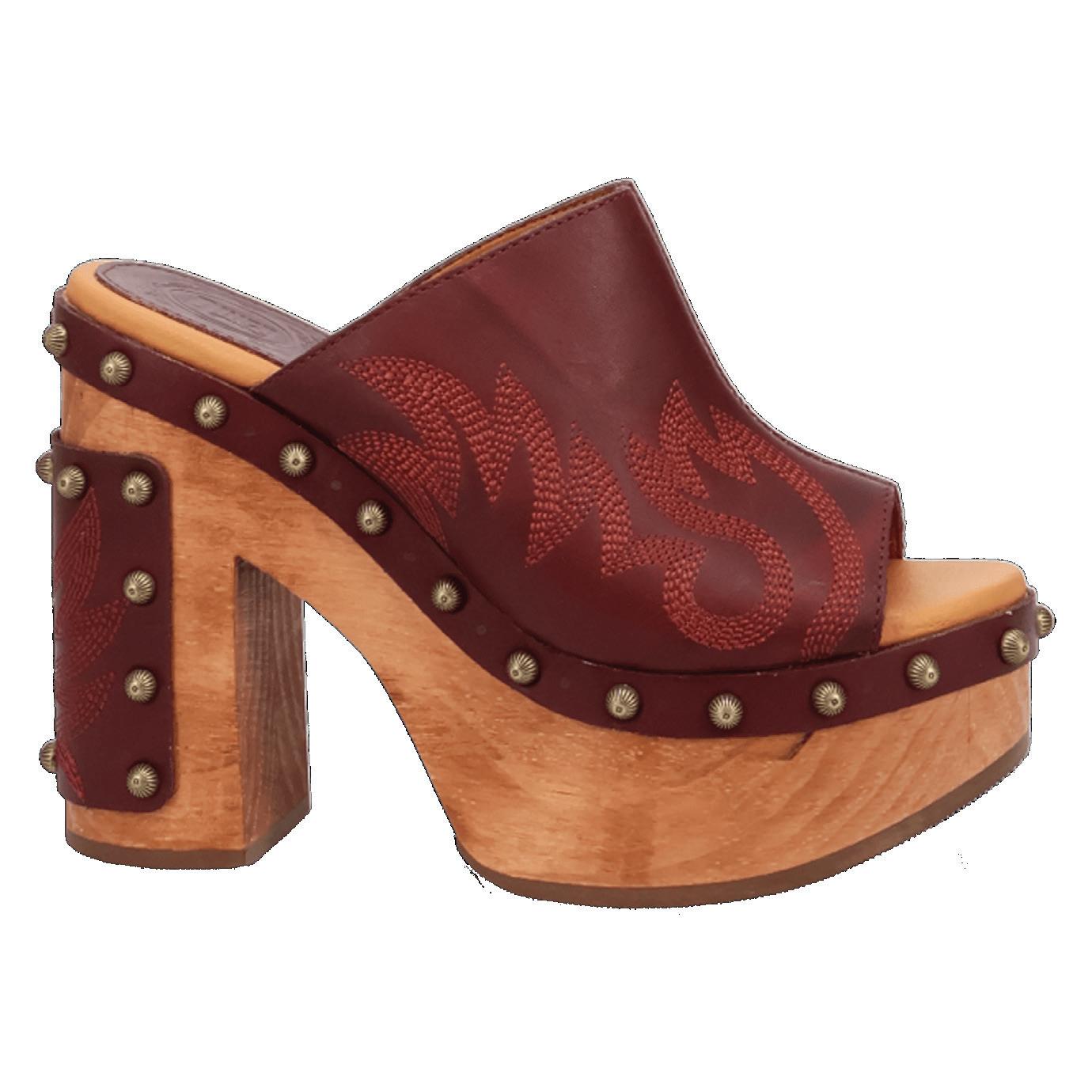
Styles that make Stevie Nicks croon with delight.
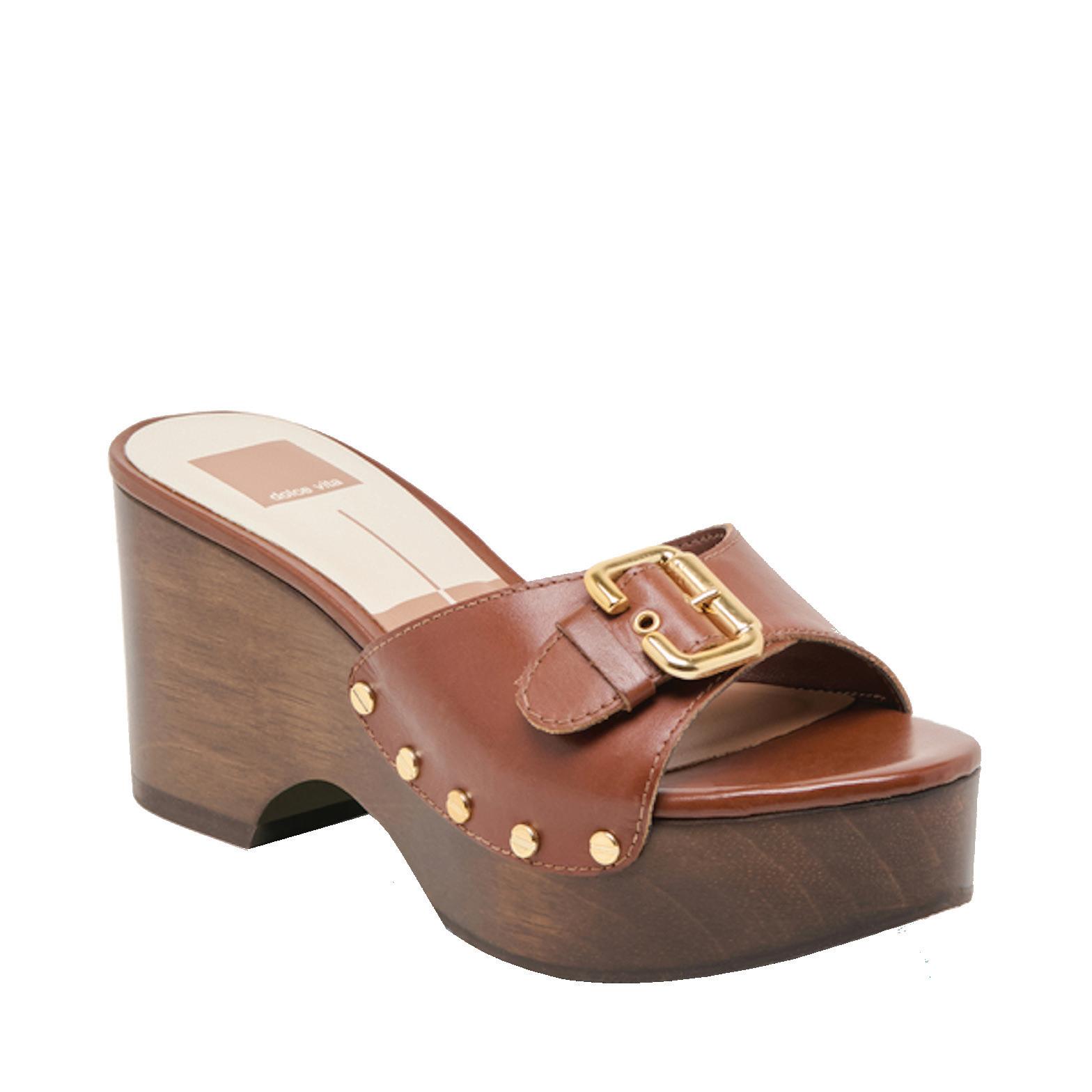
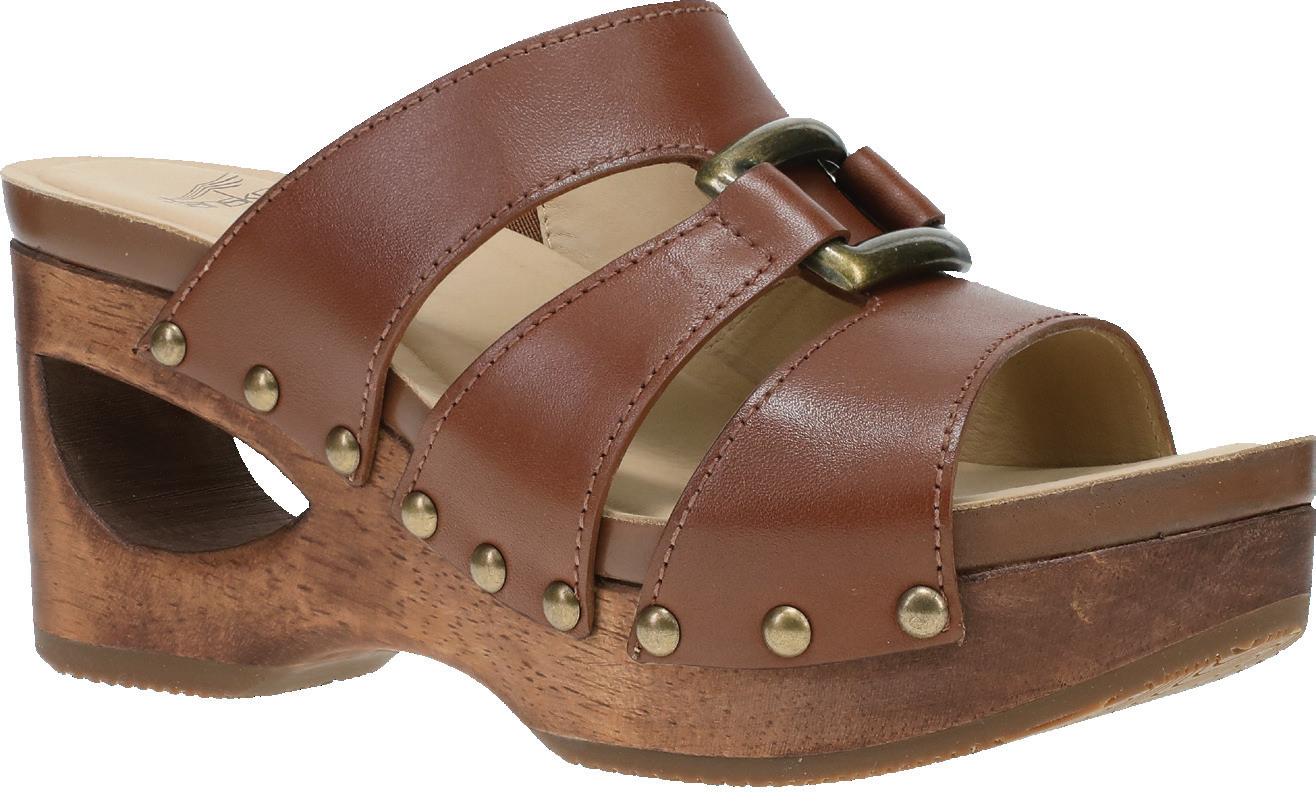
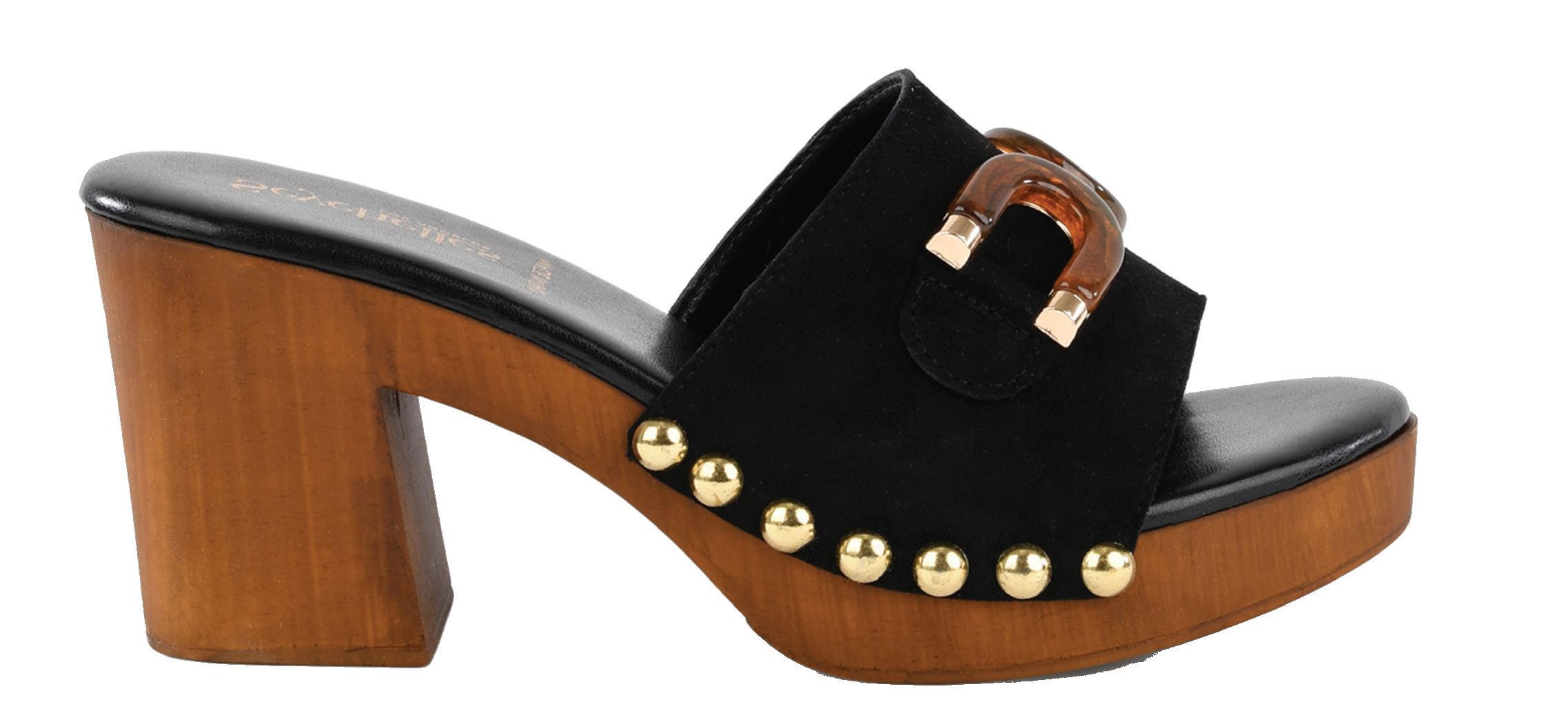

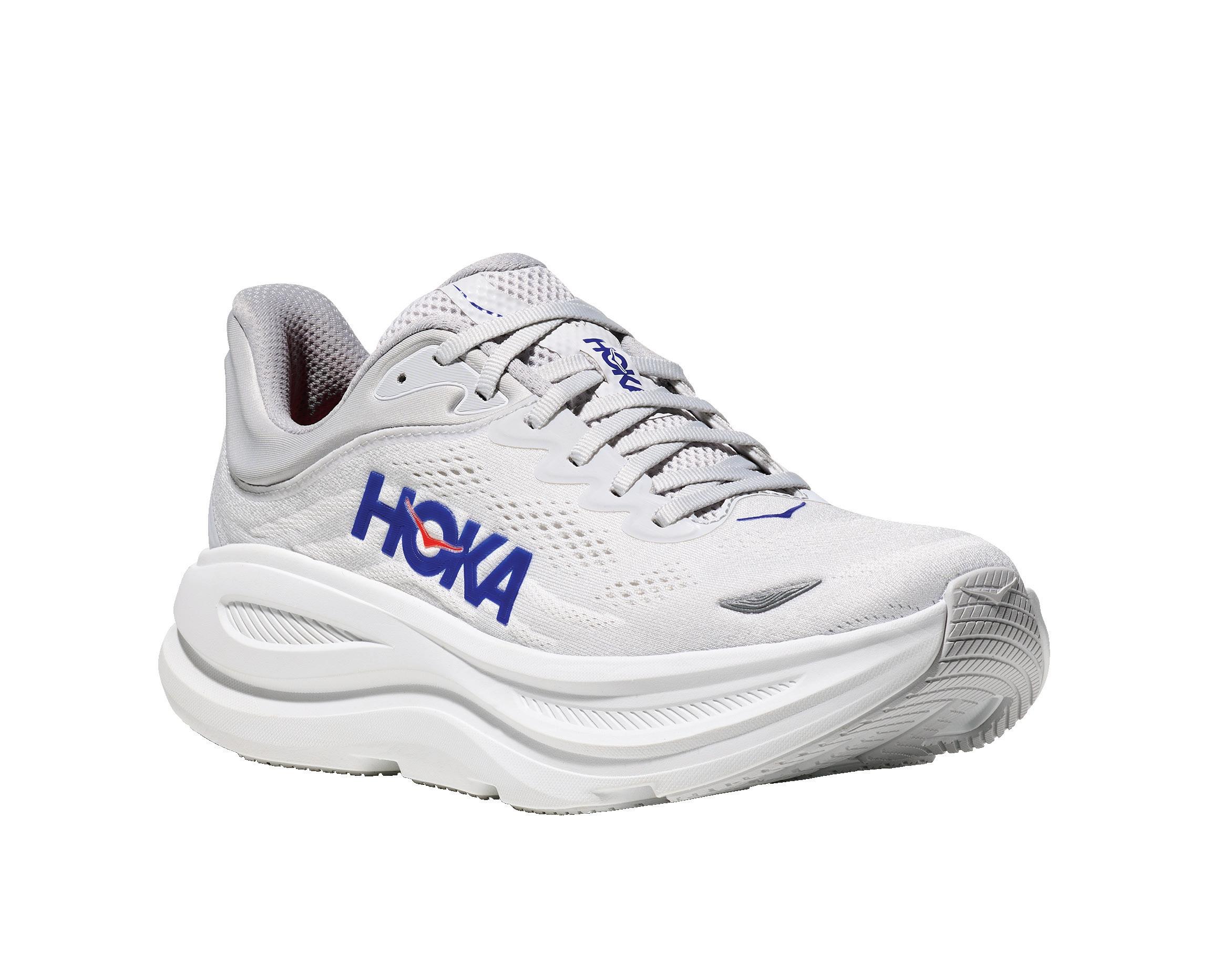


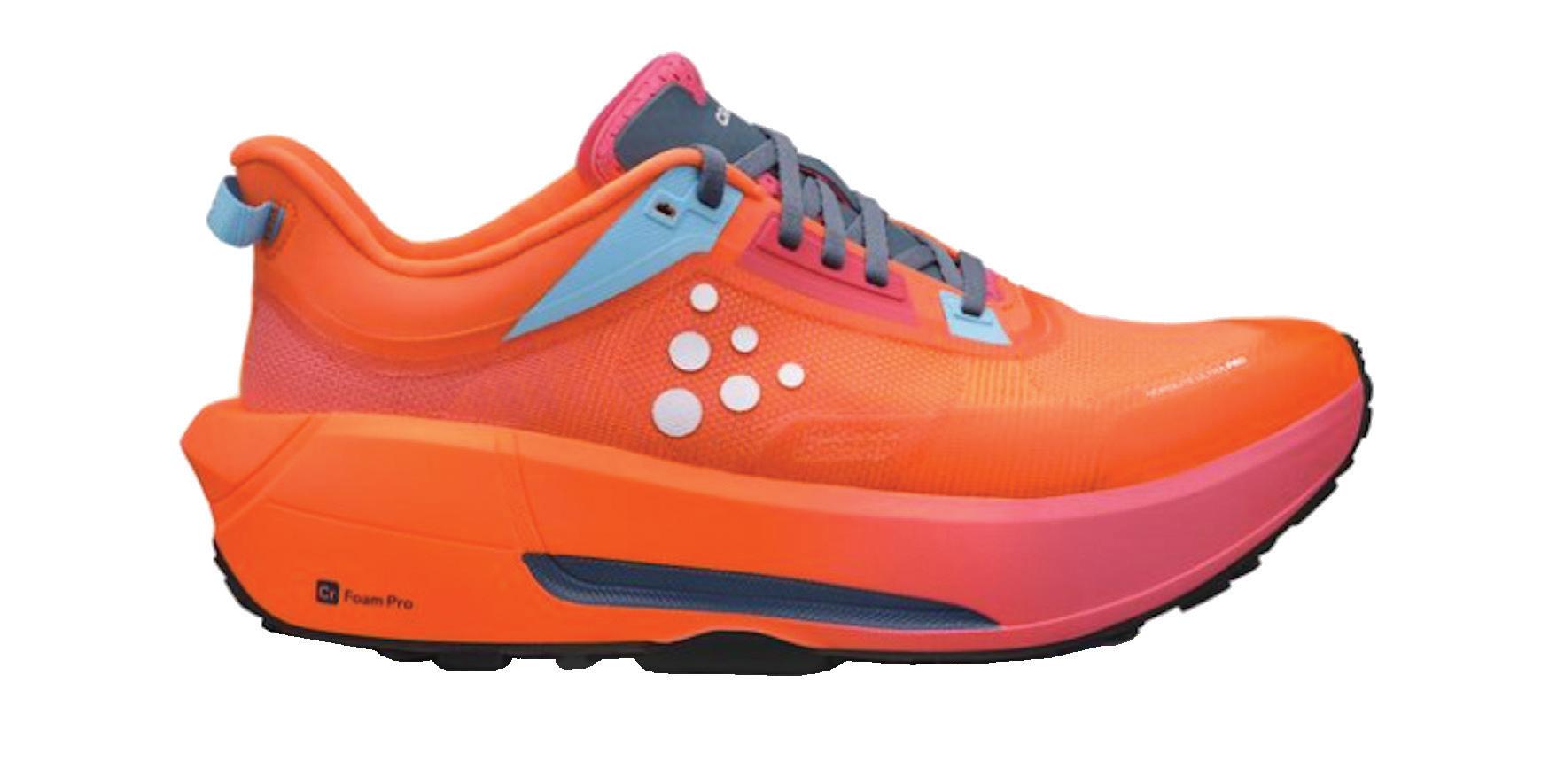
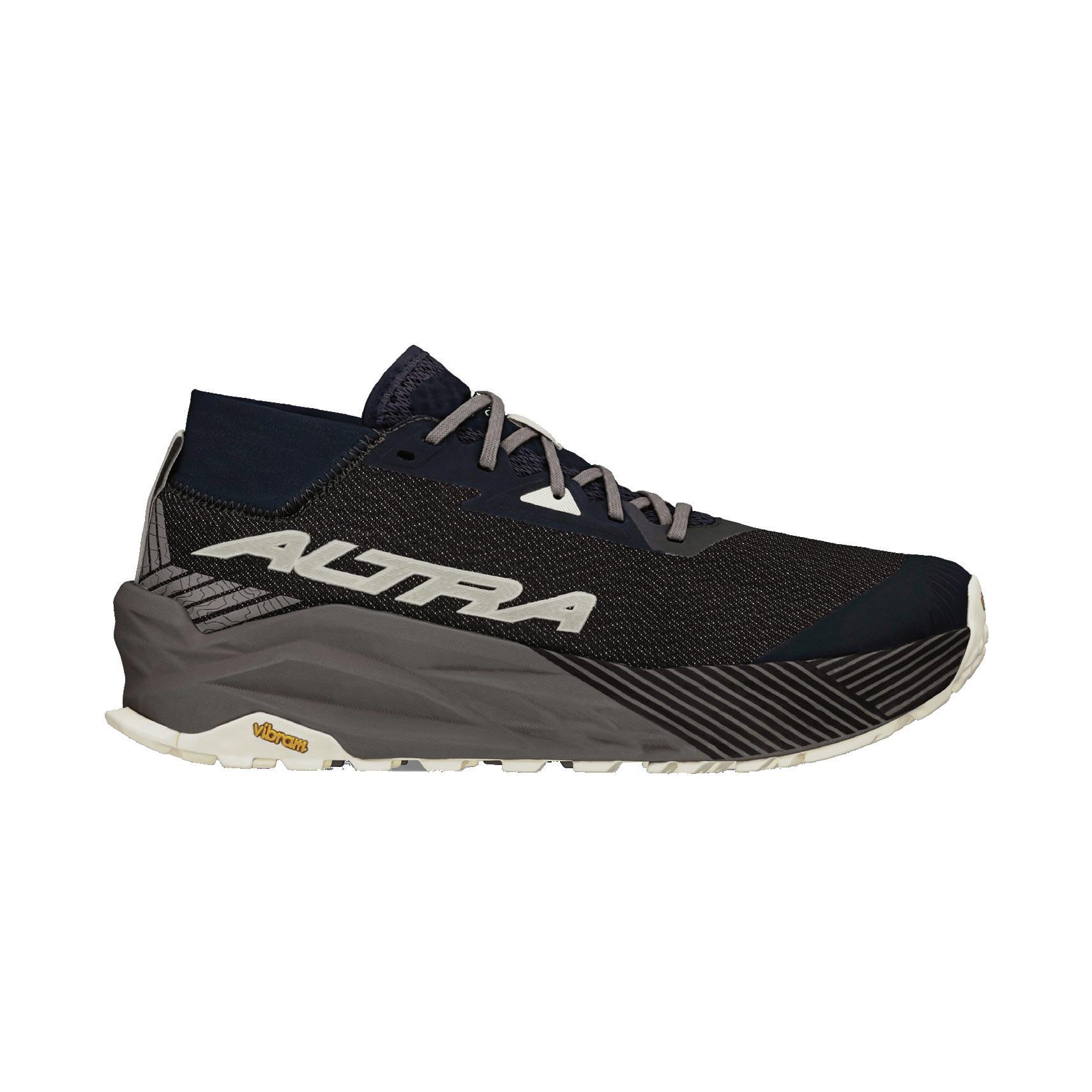
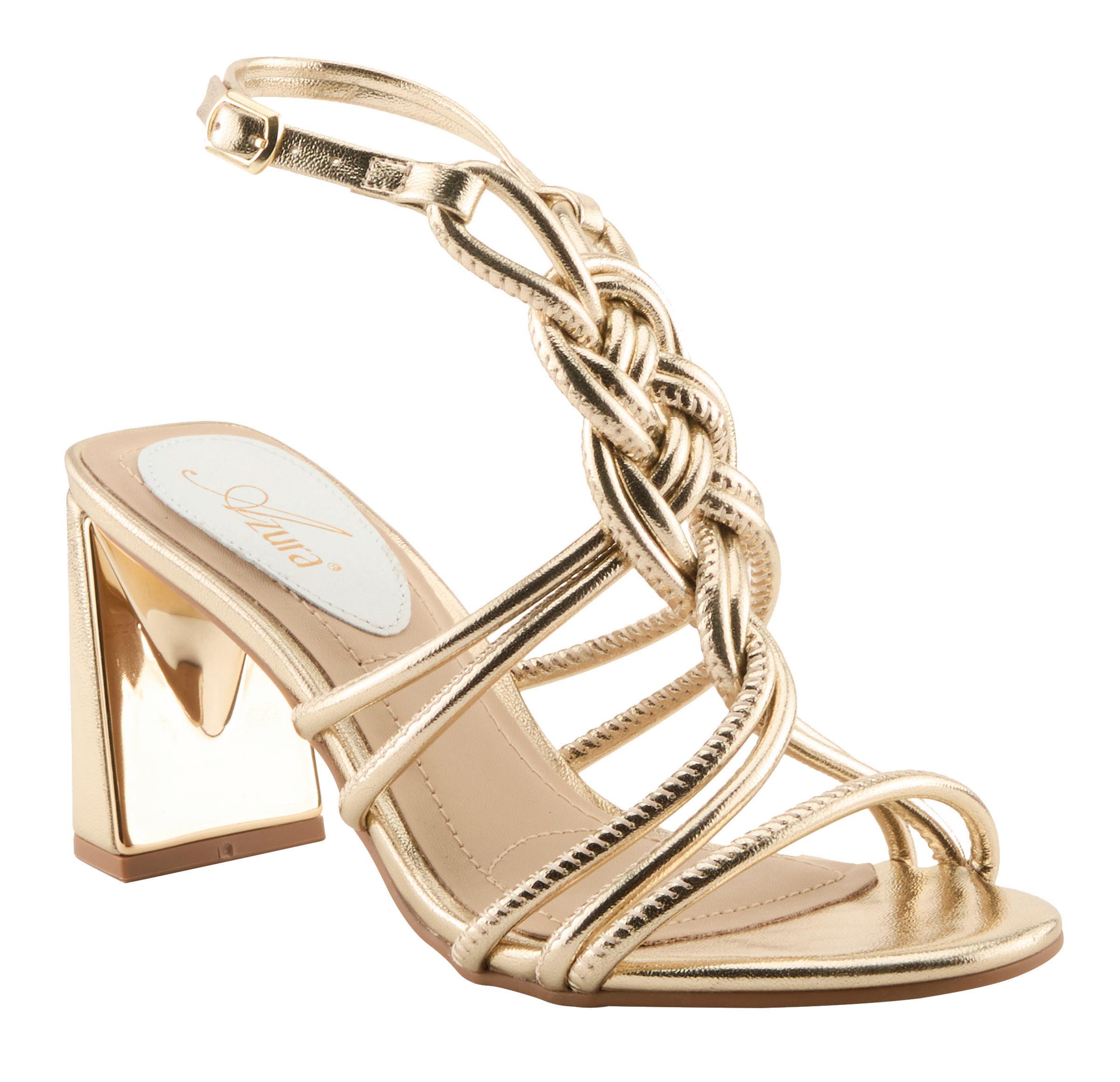
Barely-there dress sandals put pedicures in the spotlight.
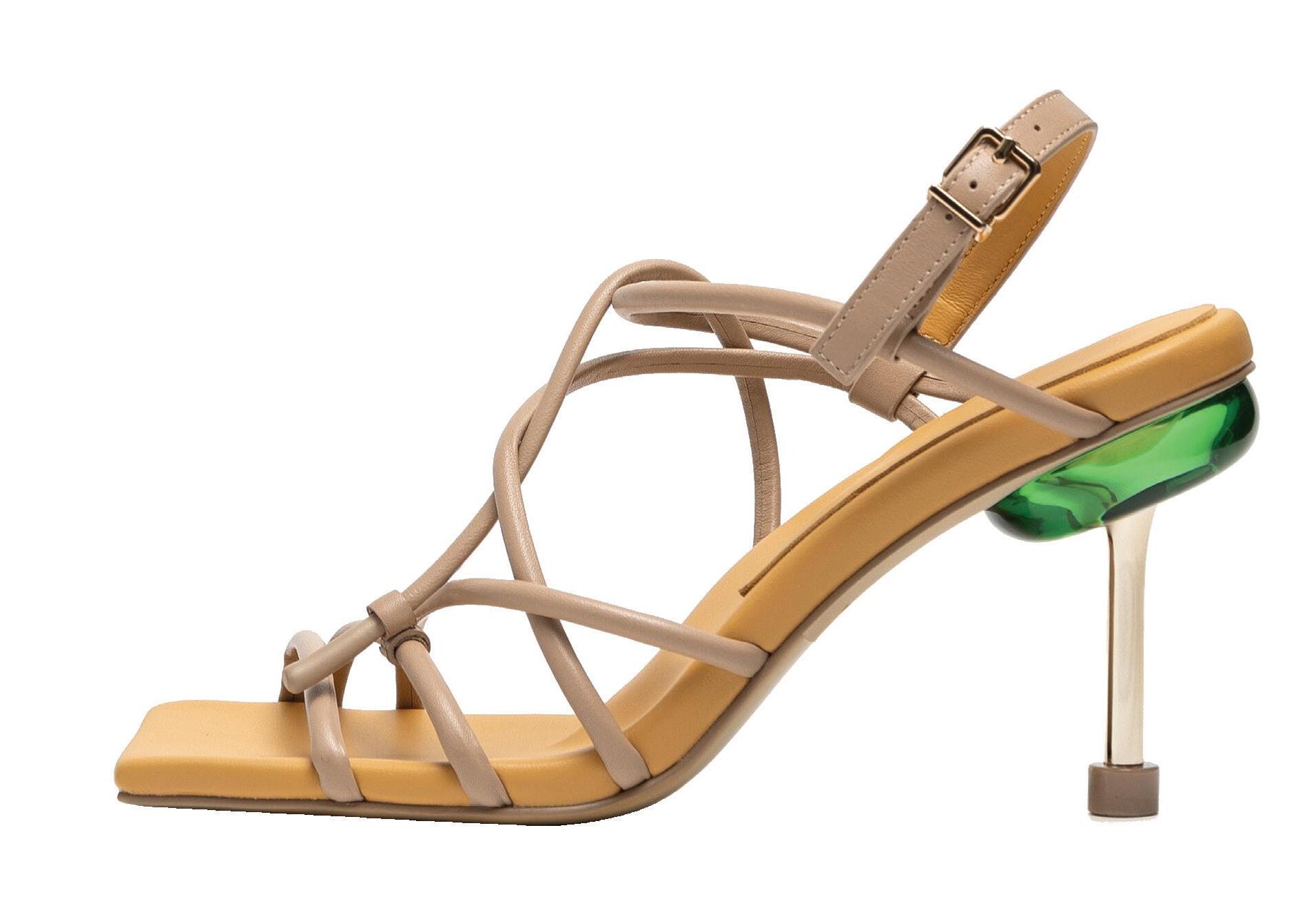

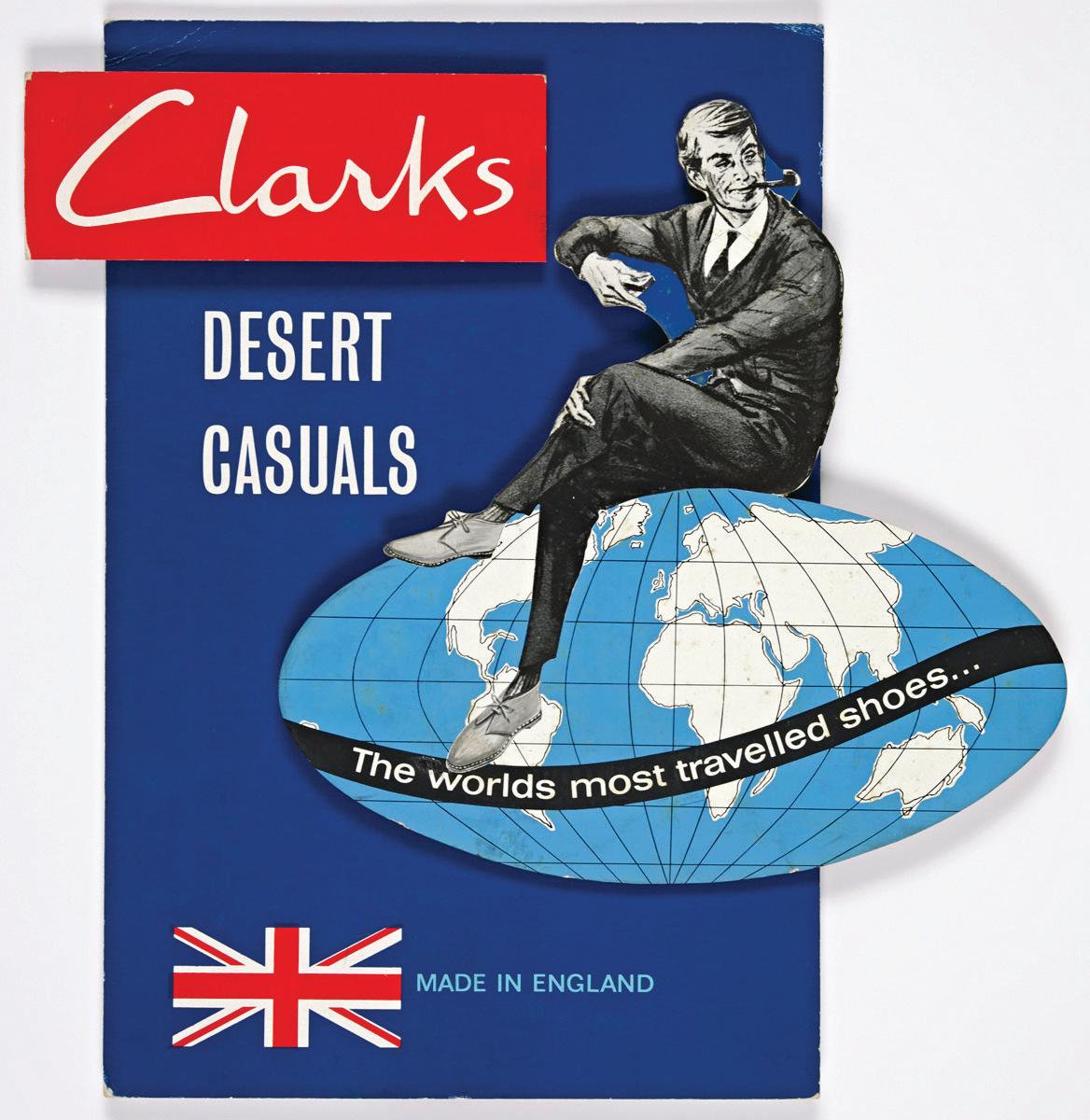
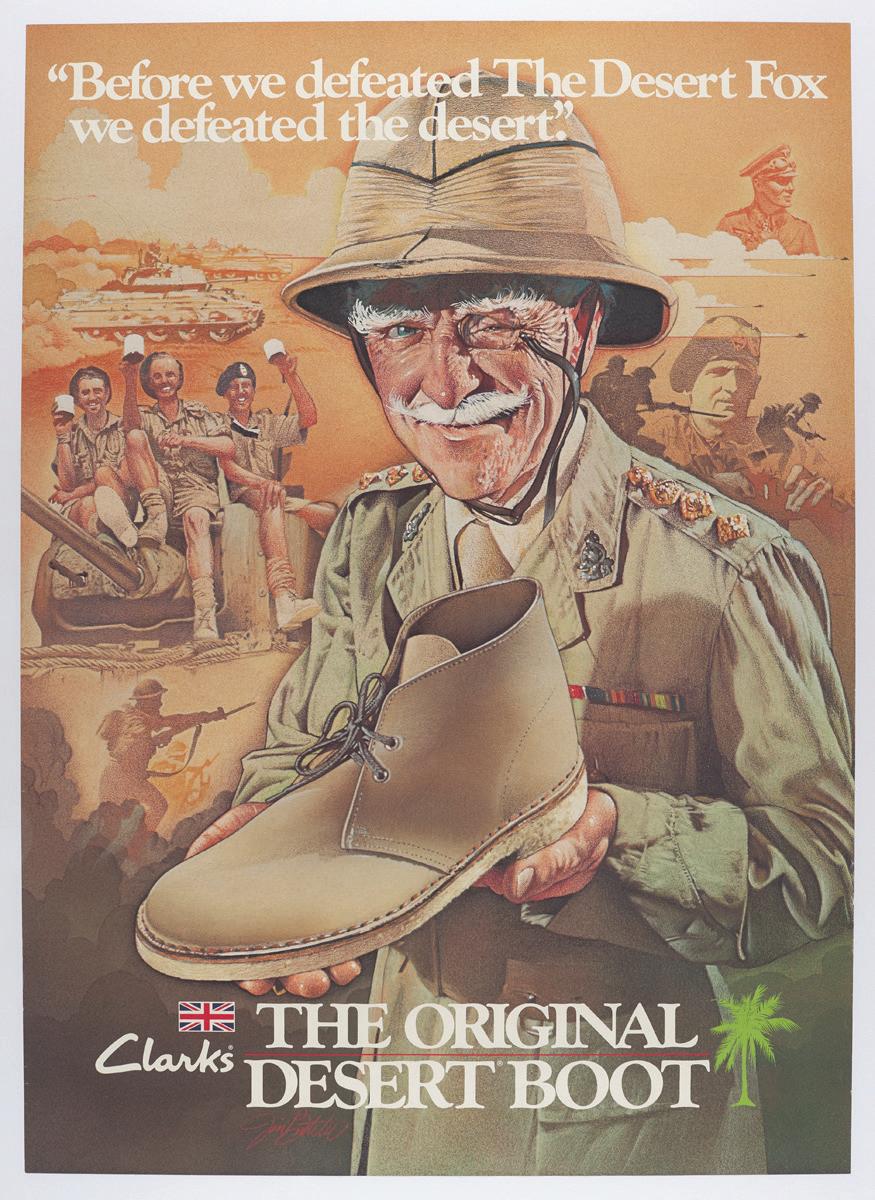
Considered the world’s first casual dress shoe, the Clarks Desert Boot has been a beacon of utilitarian fashion for 75 years and counting.
By Greg Dutter
LITTLE DID NATHAN CLARK, the great-grandson of James Clark, founder of C&J Clark, a.k.a. Clarks shoe company, realize that the shoe he began sketching in the mid-1940s would go on to attain forever-cool status, becoming a closet staple in both men’s and women’s wardrobes worldwide. A style that trendsetters like Steve McQueen, Bob Dylan, Liam Gallagher, Anthony Bourdain (who was quoted in Men’s Journal describing them as the “most comfortable shoes on Earth”), and Sarah Jessica Parker have worn. Even Manolo Blahnik is reportedly a fan. Macro speaking, the Clarks Desert Boot has been adopted by Mods, Beatniks, Rude Boys, Hip Hoppers, and Coders over the years. Estimates, made in 2011, put sales north of 10 million pairs, sold in more than 100 countries. What’s more, London’s Design Museum, in 2009, named it one of the “Fifty Shoes that Changed the World.”
unforgiving conditions of the Egyptian desert. The officers saw the advantages of the boot’s lightweight, breathable, flexible, and unstructured construction, which were ideal for fighting in the Sahara as opposed to the heavy, stiff, and hot leather military boots of the time.
Nathan tweaked the basic design and sent his sketches back to Bancroft in Somerset, England. Thus, a style icon was born, right? Well, as Clarks lore goes, the prototype wasn’t deemed a home run. In fact, the Clarks Stock Committee turned up its nose at the neutral beige-grey suede sample and dismissed the idea, stating “it would never sell.”

Back then, though, Clark was stationed in Burma when his brother, Bancroft, who was recently appointed CEO, wrote him a letter asking if he had any inspiration for footwear designs while on his travels. Nathan was particularly taken with the footwear favored by the off-duty officers of Britain’s Eighth Army, who were having shoes made for them in Cairo’s fabled Old Bazaar before travelling to Burma. These simple ankle boots featured an upper constructed of rough suede atop a crepe sole designed especially to weather the
Nathan disagreed. In 1949, he introduced the style at the Chicago Shoe Fair, transforming the booth into a desert oasis complete with tons of sand, belly dancers, and the Desert Boot presented on a silk pillow like a priceless artifact. Think Indiana Jones level intrigue and fanfare. Nathan was equal showman and designer, helping layout the framework for countless new brand and shoe introductions in the decades that followed.
The elaborate staging along with the Desert Boot’s clean silhouette and heeled crepe sole caught the eyes of buyers and fashion editors. Crepe was mainly used on sandals back then, so this was a different look, as most soles were made of leather and, during the war, some wood was even used. One editor in particular, Oskar Schoeffler of Esquire, featured the style prominently, complete with color photographs, in an early 1950 issue. He saw the boot’s potential international appeal and, more importantly, a void the style could
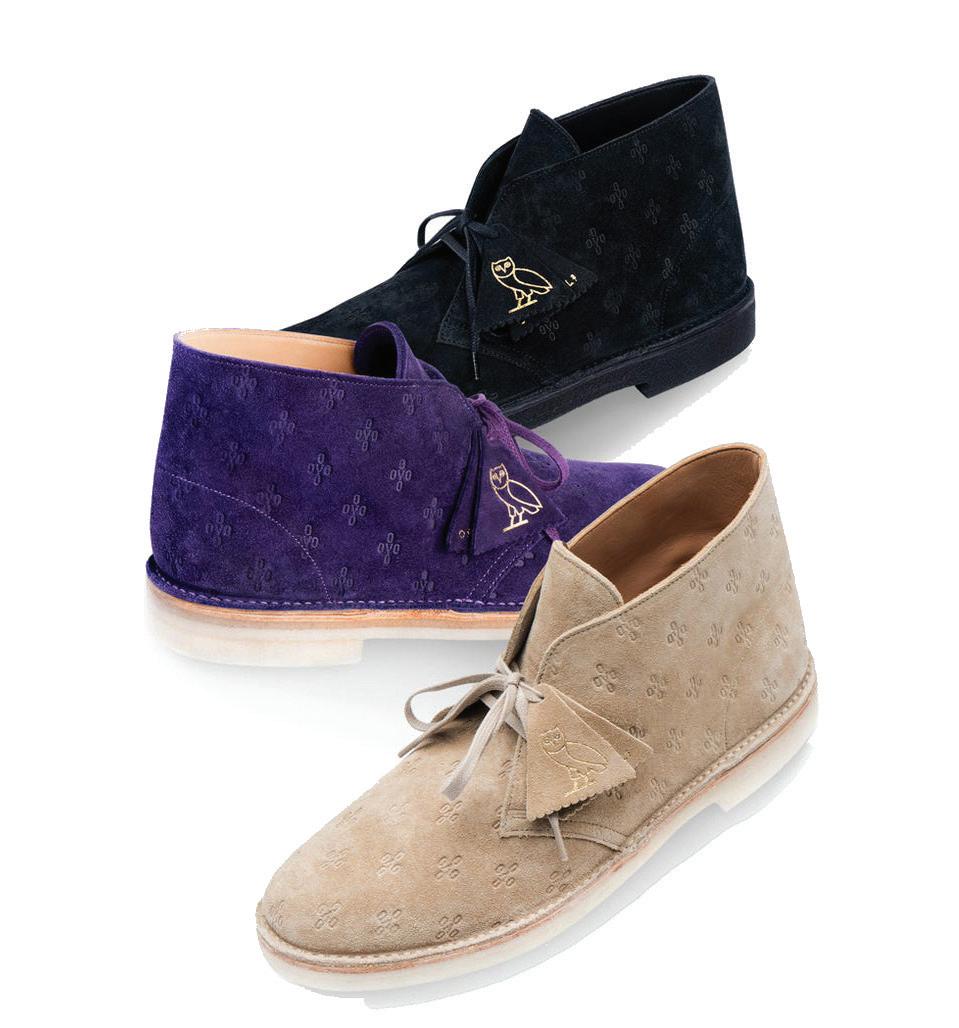
fill in a burgeoning casual fashion landscape.
The Desert Boot became an instant hit in the U.S., long before the style was even available in the UK. Tim Crumplin, business archivist at the recently opened Shoemakers Museum that celebrates 200 years of Clarks shoes in its home base of Somerset, England, says the appeal among Americans coincided with postWWII’s emerging social, economic, and cultural trends. “Wartime experiences prompted military personnel to adopt attire they’d worn in service and off duty,” he says. “Returning to civilian life, they retained items that offered superior comfort and practicality. Desert Boots became part of that tendency for less restrictive dress attire, like chinos, jackets, and T-shirts, which replaced formal wear in social circles.” Crumplin adds that the adoption in America was also facilitated by a postwar economic boom that supported consumerism, promoted by music/teenage culture and distributed globally by the dominance of American media. “Markets like the UK consequently followed, winning over consumers with the practicality, durability, and versatile nature of the boot. It was marketed to them as being ‘Inspired by the Army, it is both light and comfortable in its new role of civilian service,’” he says. Successive generations and various subsets within them adopted the Desert Boot over the ensuing decades. In the 1950s, it was the U.S. collegiate crowd, which lasted for many years. Crumplin says a fondness for the style in Jamaica also took root that decade, which underpinned the acceptance of it amongst Mod culture in the 1960s as the group had an affinity for the Jamaican Diaspora’s music and culture. Parisian youths manning the barricades

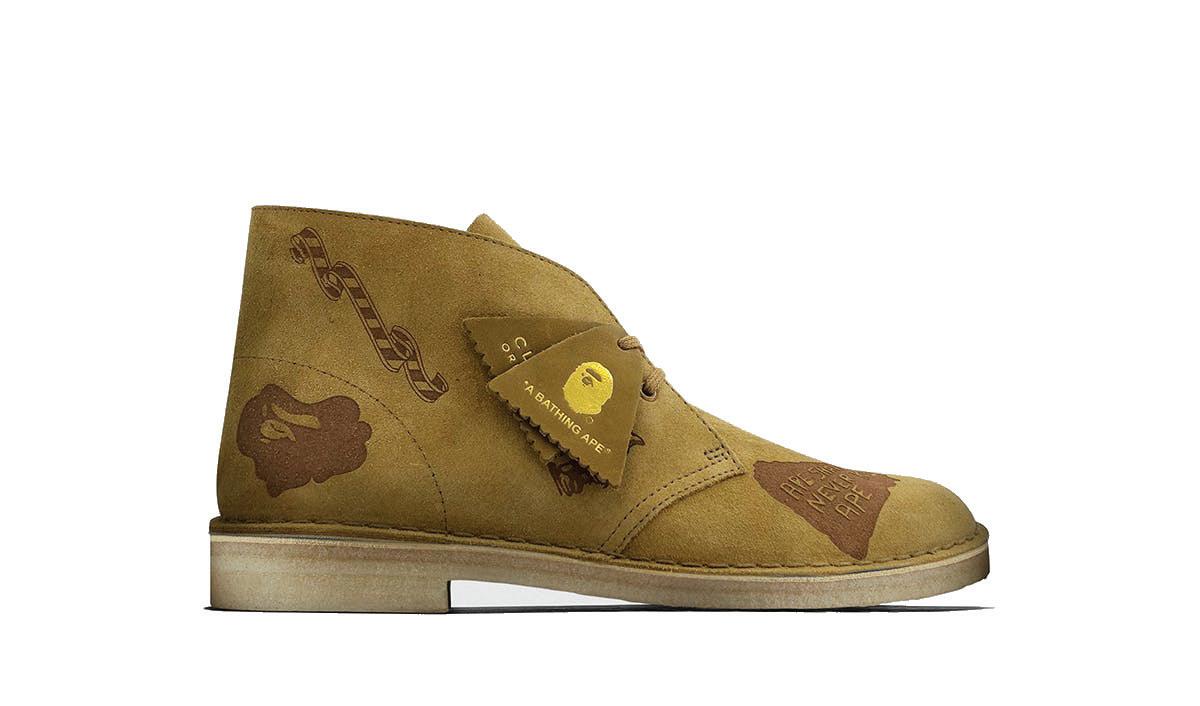
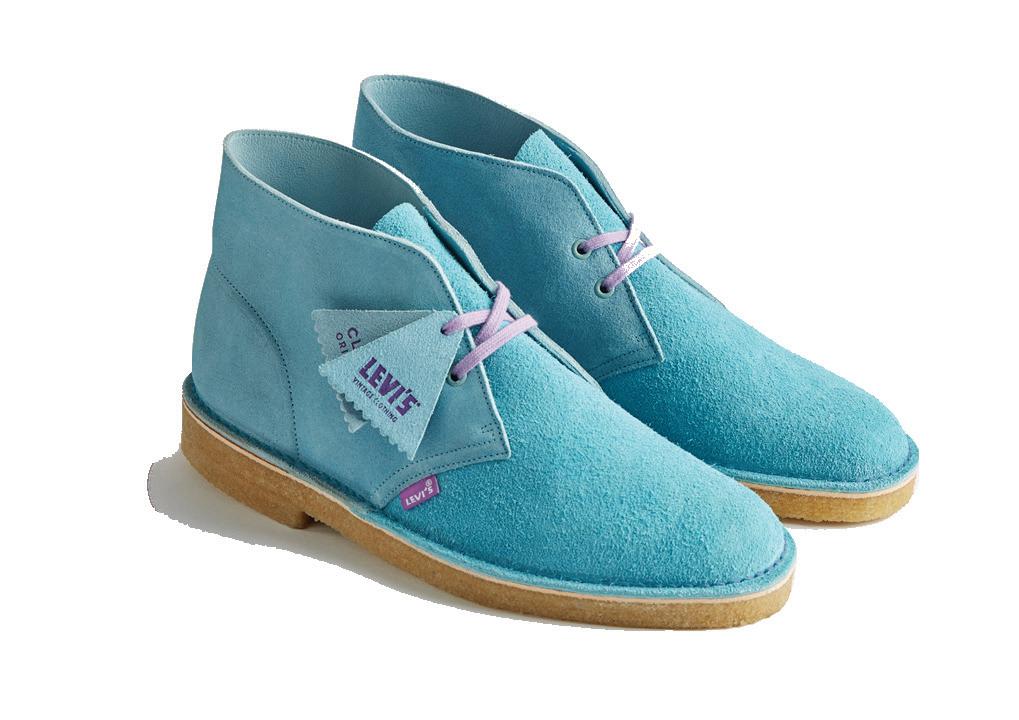
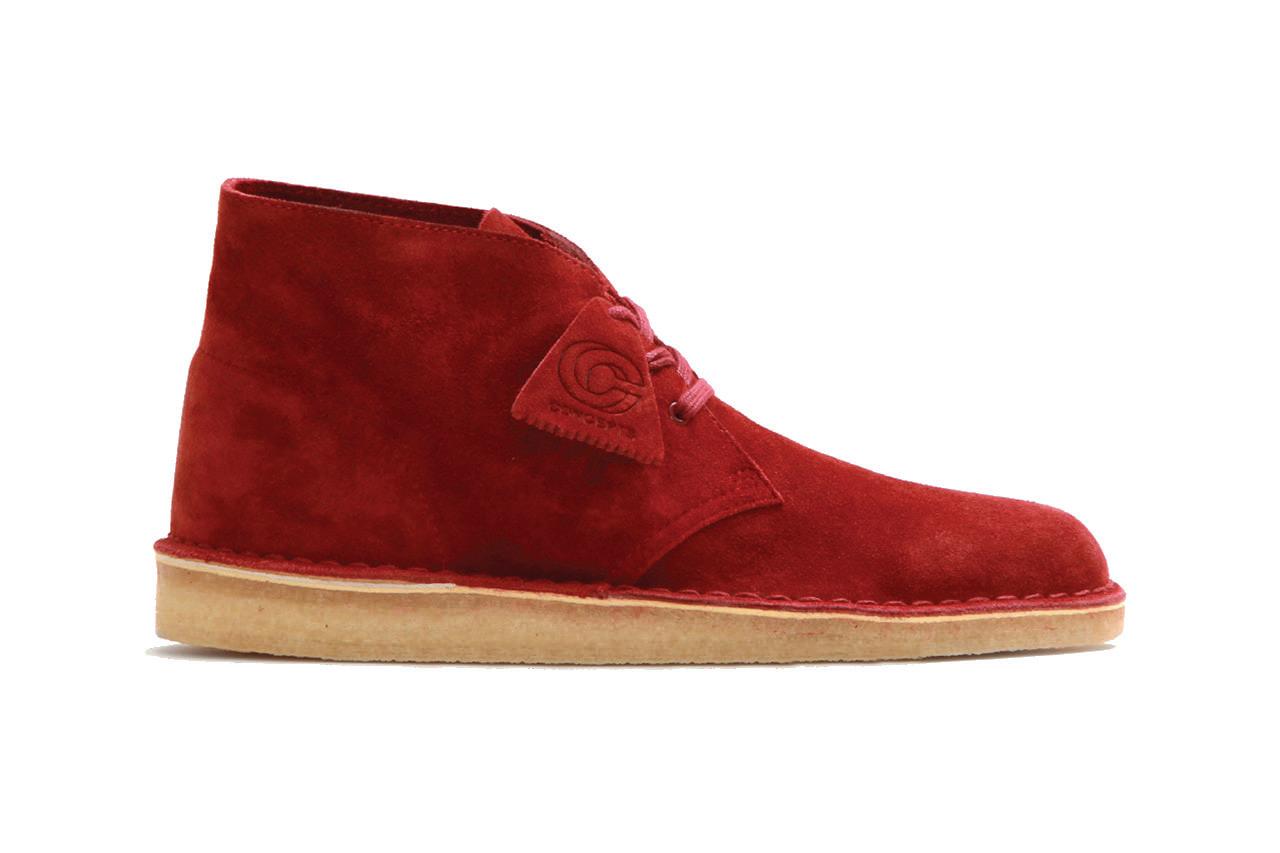
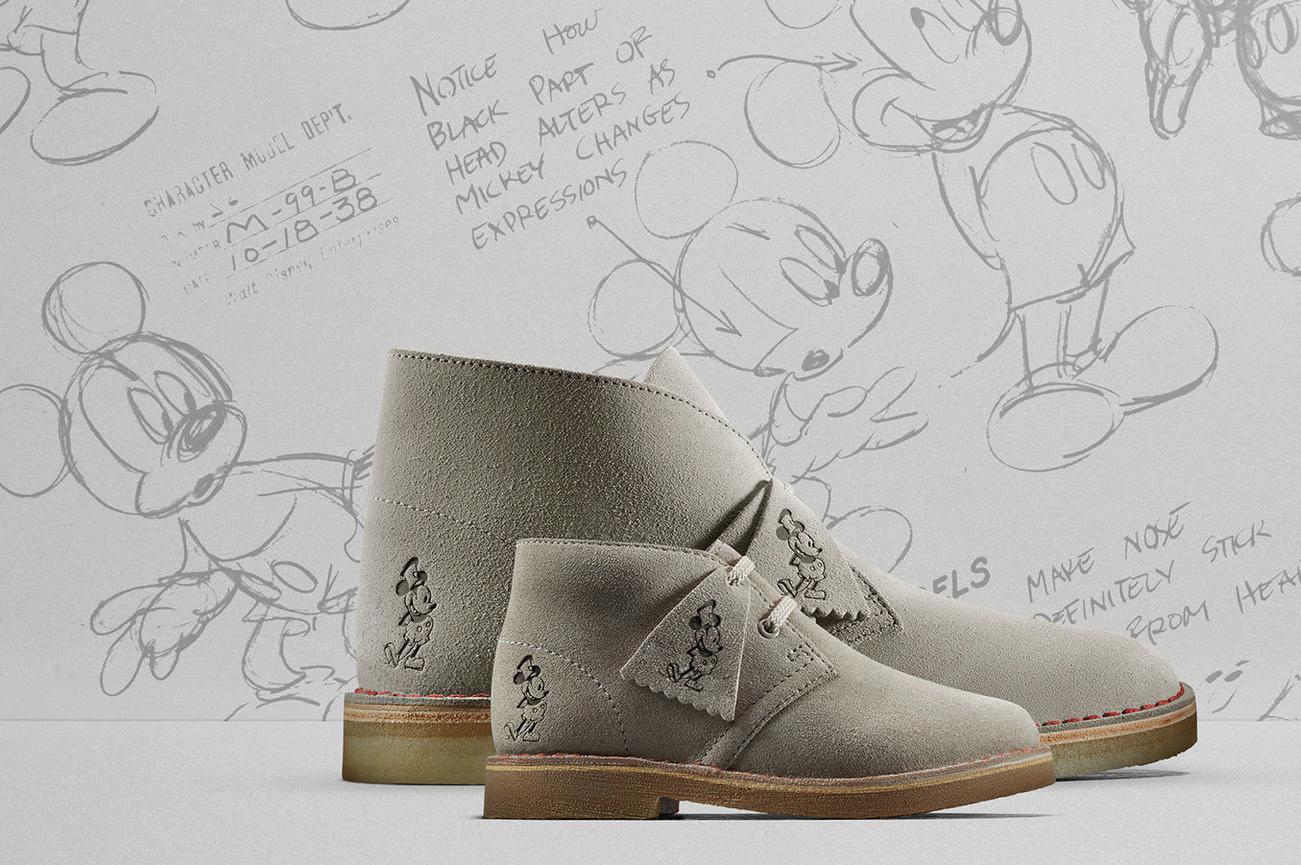
during the May Events uprising in 1968 also wore Desert Boots as part of their antiestablishment uniform. And while the Clarks Wallabee was credited with opening new markets for the brand in New York in the late 1970s and 1980s as a style choice of Hip Hop fans, a steadfast trade for the Desert Boot amongst the city’s many Caribbean Islanders continued as it reminded them of home, according to Crumplin. The 1990s saw another surge in popularity as the Desert Boot coincided with Brit Pop explosion led by Oasis. Soon after, the style was adopted by tastemakers in Japan who had a thirst for authentic products manufactured using original materials. In the 2010s, there was a push for menswear to modernize, which spanned Selvedge denim and heritage styles, that led to an increase in the style’s popularity.
Long, rich history short, Crumplin describes the Desert Boot as a “simple, timeless, clean silhouette that isn’t explicitly gendered, is free from embellishment, and is a heritage product that’s neither casual nor formal, with utilitarian qualities that mean it’s not overtly branded, is comfortable, and has historically offered a broad appeal.” Also, it’s just a really cool-looking shoe.
Longtime purveyor of all things cool, Tarek Hassan, owner/founder of the Boston-based CNCPTS streetwear boutique chain, describes the
Desert Boot as the kind of shoe that doesn’t chase trends, it sets the tone. “The Desert Boot’s longevity is a testament to thoughtful design, premium craftsmanship, and a style that adapts without ever compromising its roots,” he says. “It’s versatile, global, and personal all at once. That’s rare.”
CCNCPTS AND CLARKS have been longtime collab partners on several of the brand’s Originals styles. In 2013, the duo focused on the Desert Palmer style, which was released in two rich colorways of burgundy and teal. “It stood out thanks to the premium Italian suede uppers, metal eyelets, waxed cotton laces, and gold foilembossed insoles,” Hassan recalls, adding, “We also made a few subtle but intentional design updates, most notably replacing the traditional stacked heel with the flat crepe sole from the Desert Trek style and adding an extra lace eyelet to tweak both the look and the fit. Every detail was about elevating the classic while still respecting the original.”
Danny Waserstein, owner of Shoe Gallery in Miami, has been selling Clarks Desert Boots since the 1990s. He gives the style high praise. “Of all
the footwear designs from the past 75 years, only a handful can truly be called timeless icons,” he says. “The Desert Boot belongs in that rare group because it’s simple, versatile design crosses generations and trends. From the schoolyard to adulthood, it’s a shoe that signals heritage, quality, and an understated cool.”
Shoe Gallery’s strong Caribbean customer base reveals how the Desert Boot is deeply woven into that culture, especially among Jamaicans. “The Desert Boot became a true status symbol there,” Waserstein says. “Students were required to wear dark shoes, often black or brown, with their school uniforms, and the Desert Boot became the choice that stood out. For many, it was their first sense of style authority, and over time that look grew into a badge of authenticity that carried into adulthood.”
Nick English, founder of Stridewise.com, a blog devoted to men’s footwear, describes the Clarks Desert
Boot as a “gateway shoe” to adulthood. “Once you get a little older, you want to wear something that has a little more quality, lasts a little longer, and is generally more respected for an adult to wear,” he says. “That’s where the Clarks Desert Boot—or, as Reddit refers to it, CDB—comes in as a casual entry shoe for young adults.” English cites versatility as a key to the style’s long-running success. “The flexibility, lightness, and shock absorption of that crepe sole are a big part of the appeal,” he says. “Combine that with the unstructured, full-grain suede upper with only a couple of eyelets—it just comes together as a shoe that doesn’t grip the foot as aggressively as a lot of other shoes, even the average sneaker. It’s so light you can barely feel it on your feet.”
Whenever Hassan and Waserstein see someone sporting Desert Boots it projects a distinct style statement. Says Waserstein: “It tells me they value
REALLY OLD SOLES: The genesis of Desert Boot actually dates back 1,000 years! The Khoisan tribe, foragers in the Kalahari Desert region of Africa, are credited with the original unstructured suede upper/crepe sole concept. The design was ideal for traversing sandy, arid, hot terrain. Later on, in the 17th century, Dutch settlers came upon the boots (then called Veldschoen). They became a work boot fave of South African boar farmers.
Holy Crepe! One of nature’s great shock absorbers and water-repellents, crepe is made from latex tapped from the Pará rubber tree. Mixed, mashed and dried, it’s rolled into sheets before being trimmed to size, with any offcuts recycled. It’s entirely natural and sustainable, so it’s good for the planet as well as comfortable.
MADE IN THE SUEDE: Another constant since the launch of the Desert Boot is the premium suede, which has always been supplied by Charles F. Stead, a family-run tannery from Leeds, England, founded in 1893. The tannery first started working on the Desert Boot with a unique technique that rehydrates, sands, shaves (both the flesh and nap sides), dyes, buffs, and brushes the hide in order to create the ideal English suede for Clarks.
REAL SIMPLE: The Desert Boot’s simple construction is a master class in less is more design. The construction process consists of only 22 pieces. (An average sneaker is made up of 65 pieces.) Originally manufactured in Shepton Mallet, Somerset, the production soon moved to Clarks’ Bushacre factory in Weston-Super-Mare to meet growing demand. It was here the “Bushacre Old Boys Method” was coined: the 19 step Stitchdown construction process used to perfect the Desert Boot. Stitchdown is one of the oldest ways of making shoes, a technique that involves attaching the upper material flat on an outsole with a Stitchdown machine. The machine pulls the upper material to ensure correct lasting at the same time as stitching a strong thick thread through the upper, insole and outsole. The thread is then waxed to keep the
the timeless essentials, the foundational pieces that started it all. They understand that great style begins with the basics, and they appreciate designs that have proven themselves over decades.” Adds Hassan: “It tells me they know what they’re doing. There’s a quiet confidence to someone in Desert Boots. It’s classic with intention. Whether they’re dressing it up or down, they’re tapping into a heritage piece that’s always in the right place, whether it’s a street corner or a design studio. It says they value quality, but they’ve also got taste.”
Waserstein likens the Desert Boot to the Range Rover: “You know you’re investing in craftsmanship, heritage, and a product that has proven value. That’s why the Desert Boot has never just been about fashion. It’s about identity, respect, and knowing you have something that lasts. That’s what keeps it relevant 75 years later.” •
shoe together and avoid it unfolding during use. Stitchdown construction is also one of the most sustainable way to make shoes as it dramatically reduces adhesive components, lasting process reinforcements, glues, and operations.
IF IT AIN’T BROKE, DON’T CHANGE IT: The Desert Boot remains as instantly recognizable today as its debut in 1950 for one simple reason: every detail remains the same. From stiffening to lacing, tagging and packing, this process ensures each Desert Boot is crafted to the exact dimensions of the revolutionary original. From the length of the stitching to the 220 last, each piece plays a vital part in delivering the ideal shape, one that molds to the wearer’s foot and makes each pair unique. In doing so, the Desert Boot has joined that elite group of same-as-the original iconic styles like the Converse “Chuck Taylor All-Star,” Ugg “Classic Boot,” and Birkenstock “Arizona” sandal. That’s some good company.
A LITTLE SPICE IS NICE: Renowned for the sand and brown suede colorways, the Desert Boot has been spiced up in various colors, prints, and materials over the decades. It’s fun and fresh, but also proves how the style can take on such adaptations without losing its utilitarian essence. Even the popular wooly Dover Street Market Ginza collab still screams Clarks Desert Boot. Other notable colors and materials over the years include limited runs of metallic gold and silver to commemorate significant anniversaries and production milestones, patent and Horween leathers, canvas, horsehair, Liberty fabric, Harris tweed, denim, and felt. Purple with Swarovski crystals has also been produced in limited numbers as part of a Rock Royalty campaign that celebrated Queen Elizabeth II’s Diamond Jubilee in 2012. Last but not all, Desert Boots have been made out of alligator skin as well as recycled plastic bottles.
NO LOGOS NECESSARY: According to Clarks lore, its Italian agent wanted the brand’s popular styles, particularly the Desert Boot, branded on the outside. It was primarily owing to concerns about counterfeiting, but also to capitalize upon its growing cache. When the matter was referred to designer Nathan Clark, however, he decreed: “Branding is vulgar. The only person who needs to know it’s a Clarks Desert Boot is the wearer.” The Desert Boot remains unbranded to this day.
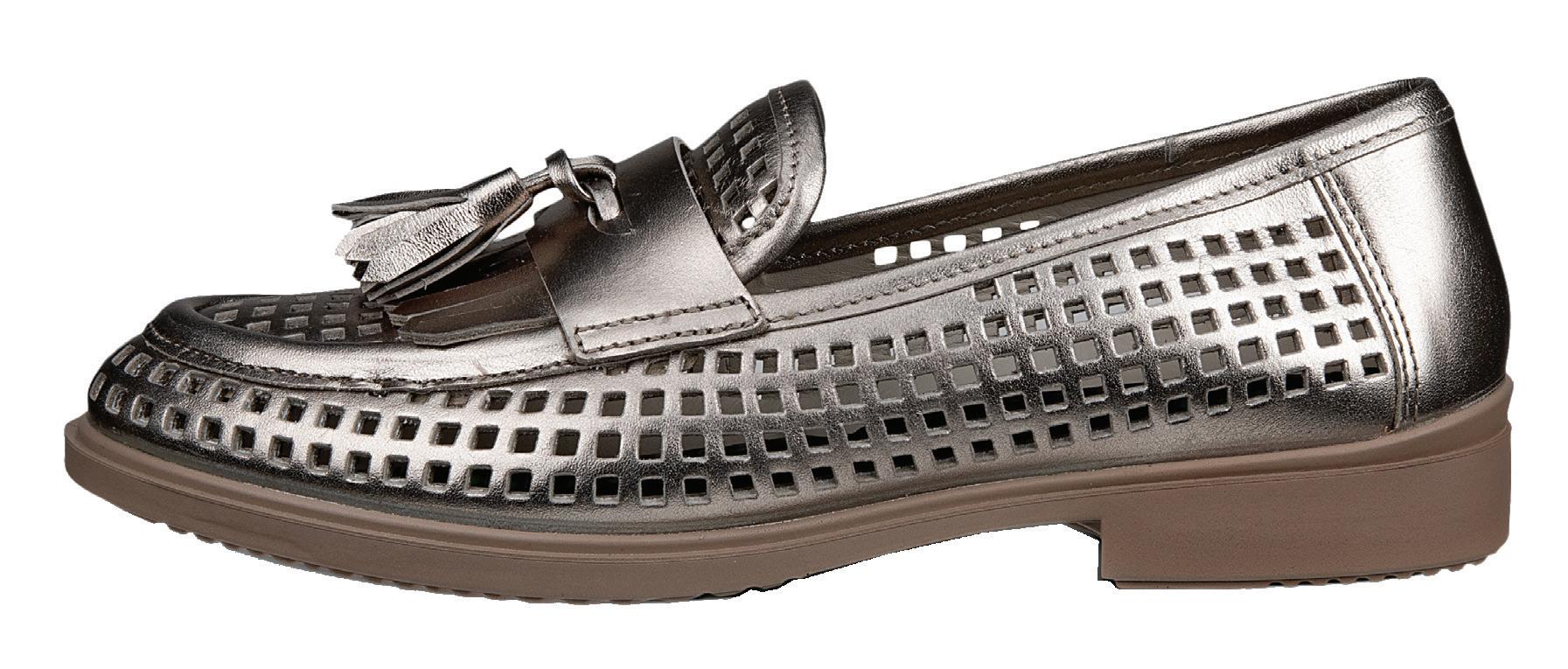
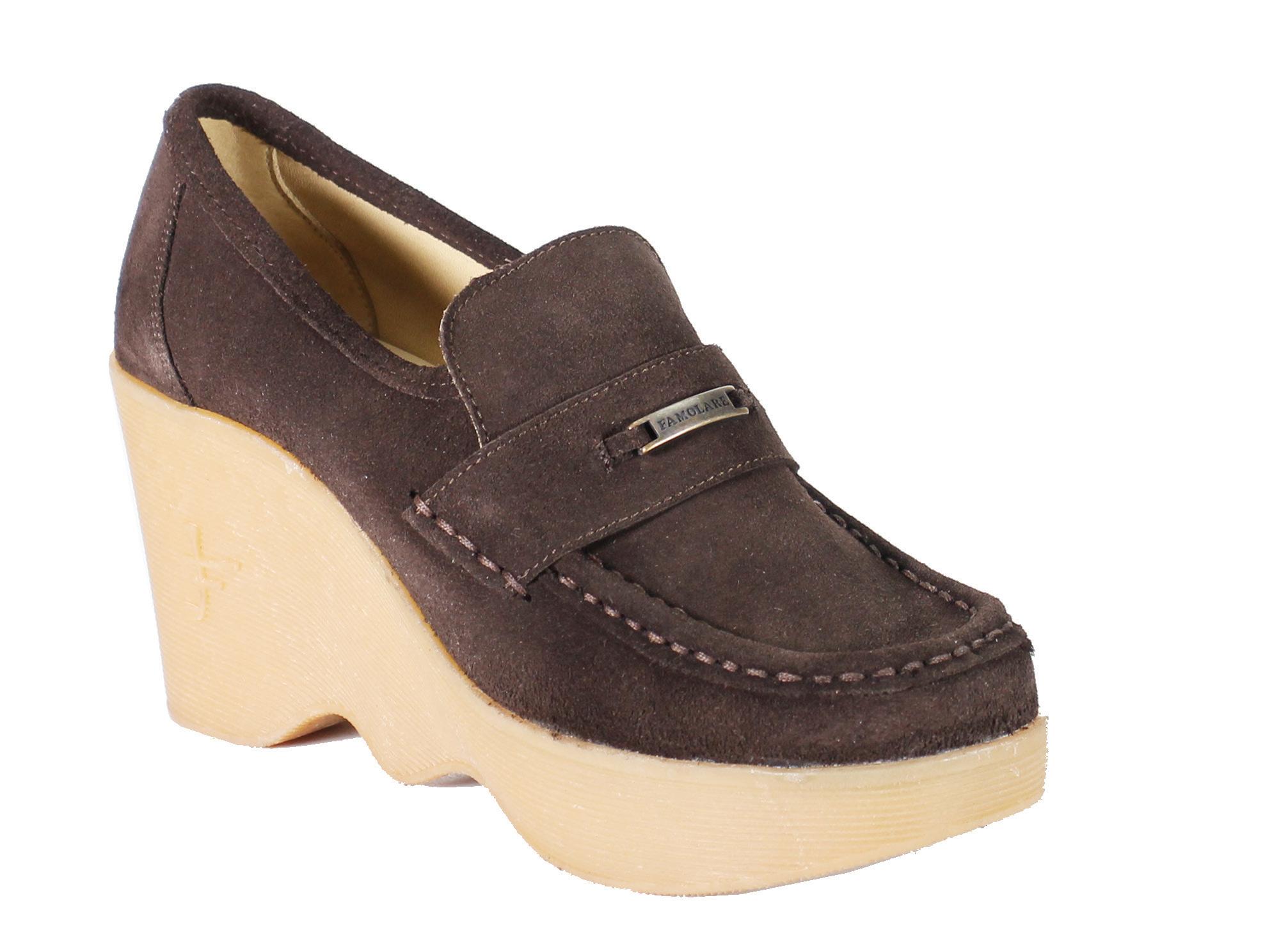
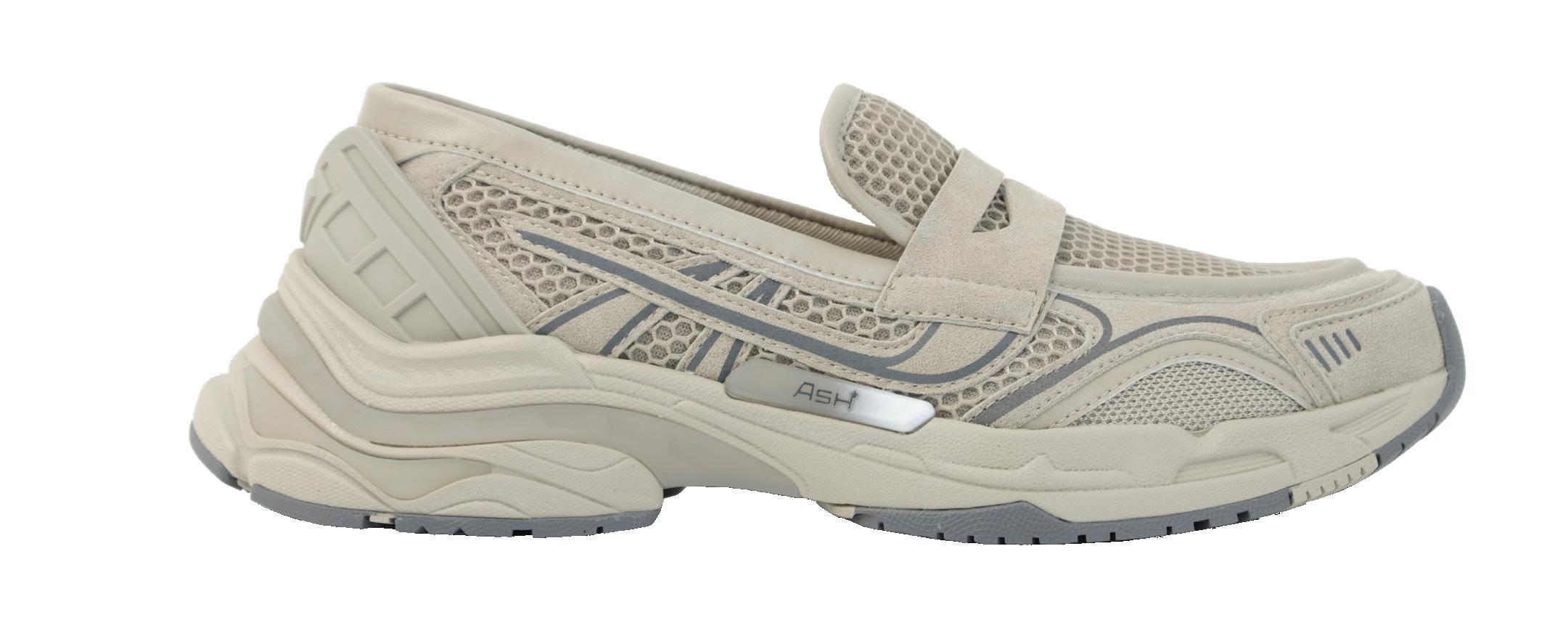

Fresh takes on the loafer breathe new life into
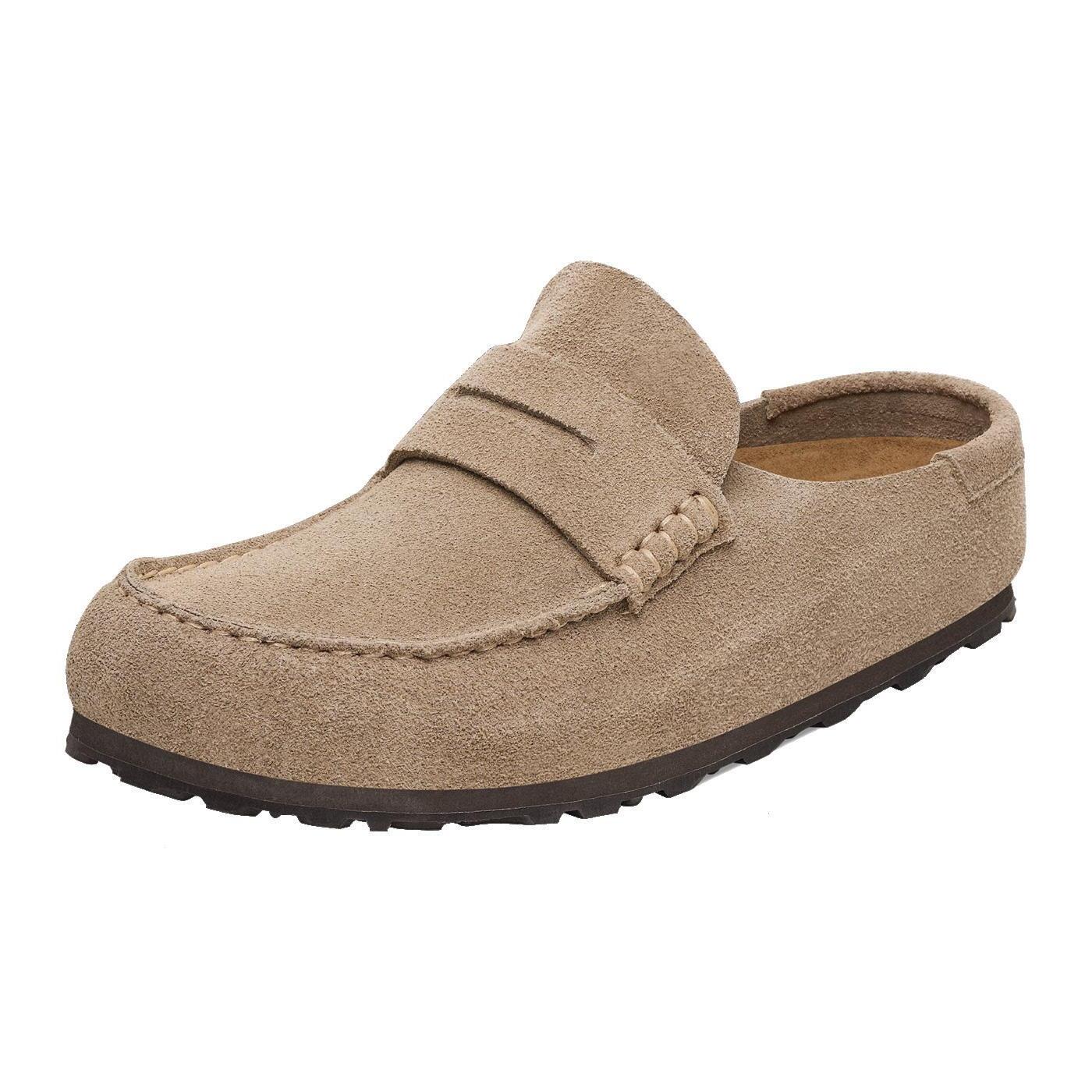
A four-generation, family-run footwear retailer and leather repair shop in Iowa turned 100 this spring. Talk about a small-town success story.
By Kathy Passero
BUFFALO CENTER, IOWA, is a town of about 839 residents—and there’s a good chance every one of them has bought shoes at Weaver’s Leather Store. But locals are hardly the only fans of this iconic, family-owned retailer, now celebrating its 100th anniversary.
Folks visit regularly from a 90-mile radius around Iowa and across the Minnesota border, seven miles away. Then there are those who learn about this unique slice of small-town America and a make a pilgrimage from farther-flung destinations. “Yesterday, some people from Maine who were traveling to Washington came in because we were on their bucket list,” says Tim Weaver, the third generation of his family to oversee the business. “They were heading to Mount Rushmore after visiting our store.”
The Weaver family might be surprised to find their humble shop among the country’s must-sees for road trippers, but centenarians in the world of sit-and-fit footwear retailers are arguably just as rare as natural wonders and national parks.
And this particular shop is truly one-of-a-kind, from the traditional treadle sewing machines the Weaver men use to complete 60 to 70 repairs weekly, to the amiable bulldog and golden retrievers often found lounging around the bench in front of the store. The pets are such a tradition that “lots of little kids are told they’re going to the dog store to get shoes,” says Tim.
Of course, it’s not just about atmosphere. Service and selection are cornerstones at the venerable shop, located quite literally on Main Street. Shoppers look forward to old-fashioned expert fittings and personalized attention from Tim; his wife, Julie; their adult sons, Colin and Tanner; and sometimes Tim’s 95-year-old father, LeRoy, son of founder Ted Weaver.
Customers also appreciate the treasure trove of product housed in the 4,000-square-foot space. “We’ve got around 15,000 pairs of shoes on the shelf,” says Julie. “We start at crib size 1 in shoes, and the biggest size we have is a men’s 17,” adds Tim. “We carry up to size 6E on some shoes because we have that customer base.”
The store’s core customers are farmers and factory workers, with men’s
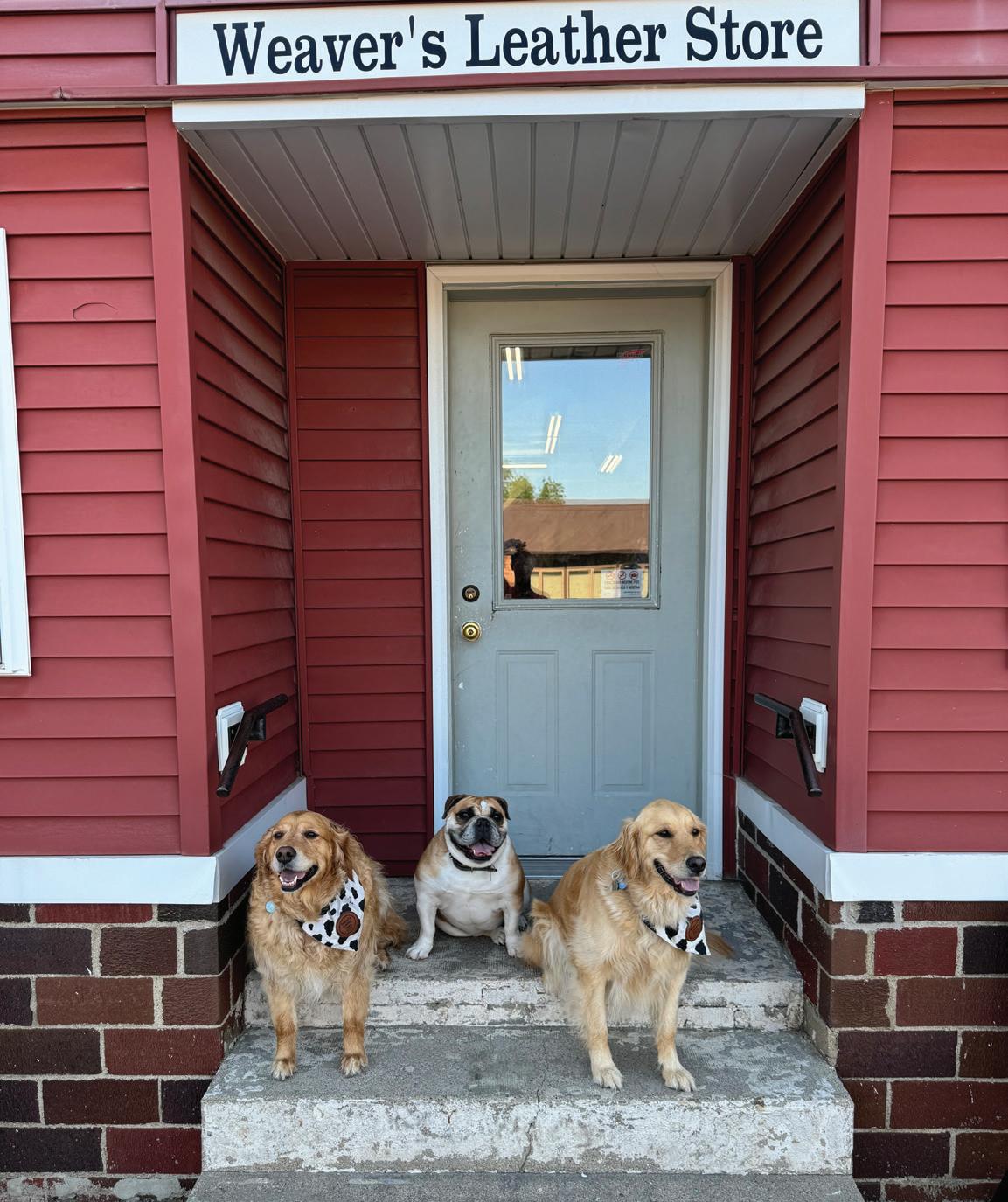
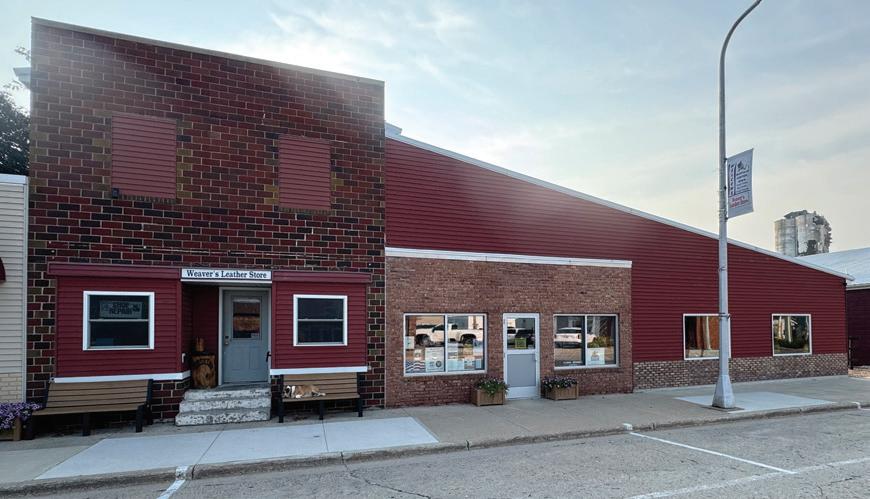
footwear accounting for about 60 percent of sales, but since Julie entered the picture in 1998, “our ladies’ business has tripled,” says Tim. Top-selling brands include Red Wing, Ariat, Double-H Boots, Carolina, Twisted X, and Keen. In the athletic/athleisure category, Hoka, New Balance, and Skechers Slip-Ins are hot of late.
Whether they’re in the market for workwear or back-to-school styles, shopping at Weaver’s is a local tradition for many families in Buffalo Center. “My parents and my grandparents shopped there, and they brought me to get my first pair of cowboy boots when I was little,” says longtime customer Julie Johnson. “I continued that tradition with my own children and my seven grandchildren, who live in Minnesota and South Dakota. Their first cowboy boots always come from Weaver’s. I’ve got pictures through the years of each child sitting on the counter with their new boots and Julie standing next to them.
“They’ve got such good quality and variety at Weaver’s,” Johnson adds. “And they do their best to help everybody, no matter what they need. We pulled up in front of the store once and saw Tim in the back of a pickup truck hand-sewing a torn leather couch for a customer.”
“The Weavers are simply legendary in the business,” says Katie Hoffman, a sales representative for Twisted X who has worked with the store for 23 years. “They’re all very kind people. They welcome each customer as if they’re a good friend, offering excellent customer service to everyone. Fitting people’s feet for
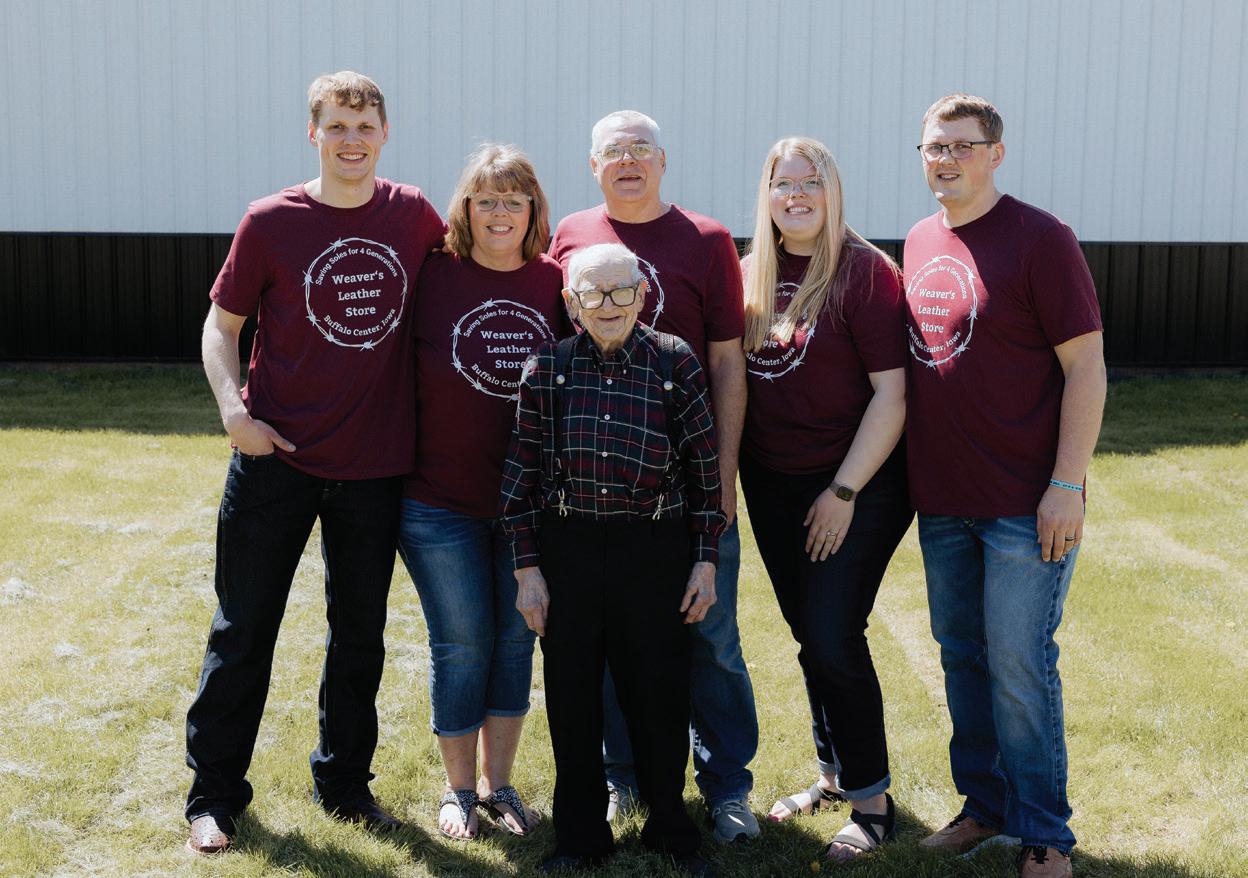
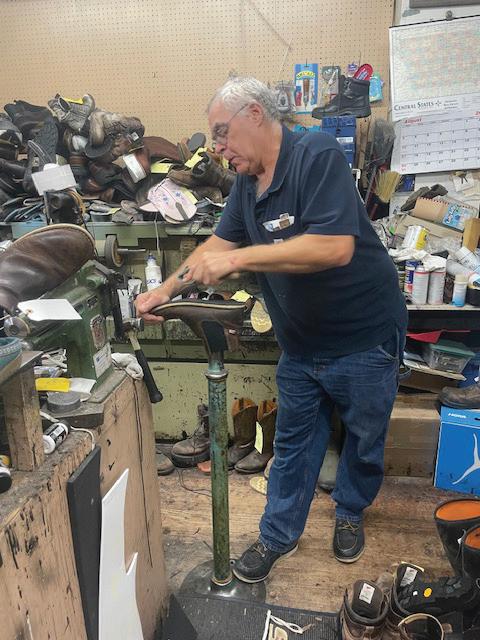
Clockwise from top: (from left) Colin, Julie, Tim, Tanner and his wife, Annie, and (front) LeRoy; a wide selection of products on display; Tim at work on a repair.
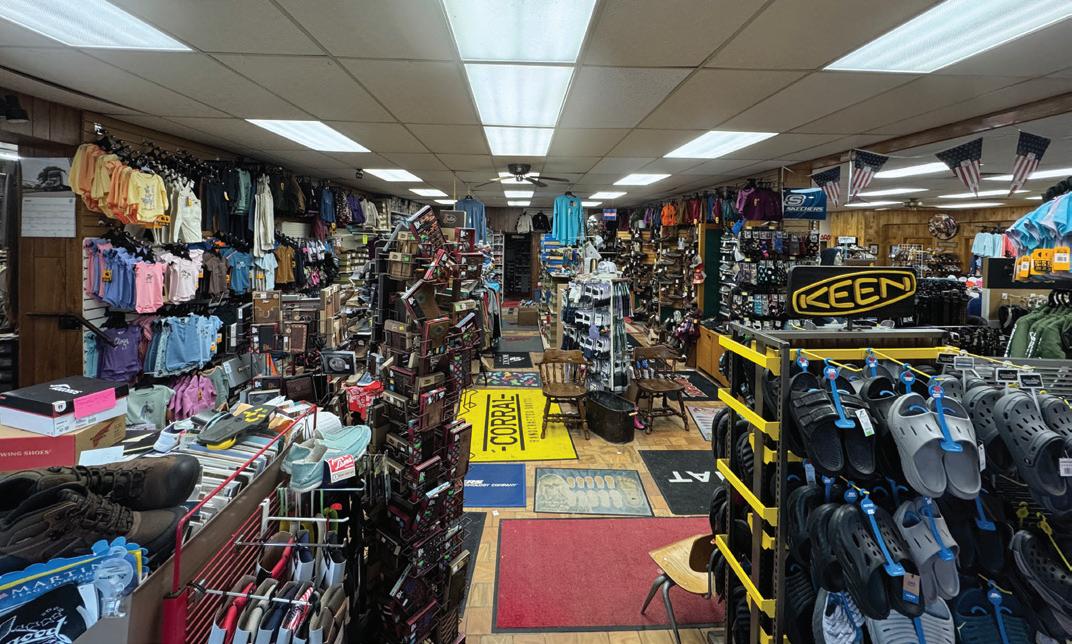
shoes and boots for this long guarantees expertise.”
The retailer’s wide variety of sizes and widths also sets it apart and earns it a special place in the hearts of shoppers.
“My son-in-law from South Dakota was like a little kid the first time we took him to Weaver’s because he was so excited to find fishing boots in size 16 in different colors and styles,” says Johnson. “He talked about it all day.”
“When we go to a market, we’ll say ‘We need this shoe in size 15 or a 4E because a certain customer will want it. We’ll mention the customers’ names,” says Julie. “Salespeople are often surprised by that, but we really know our customers, and we know what they like.”
“They expect to sell every customer who walks in that front door a pair of work boots, athletic shoes, western boots, or comfortable everyday shoes,” says Mike Langfeldt, territory account manager for Red Wing Shoes. “To have that confidence means you need the inventory to support the needs of every customer. They’re willing to buy the smallest and the largest sizes. If a size 16 walks in the door, they want to give that customer not just one or two options. The customer may walk in looking for a work boot and depart with that work boot, plus a new pair of athletics and something to wear to church just because they had them all in stock.
“Weaver’s is the kind of business that any brand can be proud to work with. They’re wonderful
partners,” Langfeldt adds, noting that Red Wing has worked with Weaver’s since the 1930s.
It all began when Ted Weaver returned from World War I after seriously injuring his back on an ammunition train. He made the most of a new government program that provided training to help veterans master new trades, learning harness making and shoe repair in Omaha, Nebraska, before opening a shop in the small town of Germania, now called Lakota. In the early 1920s Ted moved eight miles east to Buffalo Center and, in 1925, opened Weaver’s. In 1930, he built the structure that is still the center of the store, adding a second story apartment above it. That space is now used for storage, but LeRoy grew up in it—literally over the family store.
When Ted passed away in 1950, 19-year-old LeRoy stepped in. He added “Leather Store” to the official name and kept the business alive with help from his mom, Ann, who created what would become a longstanding tradition of bringing the family dogs to work.
Just two years later, LeRoy was drafted into the Korean War. With no siblings to take over for him, “he sold off all the shoes, went to Red Wing Shoe Company, and asked them to hold his account open until he got back,” Tim explains. “They were kind enough to put a halt on Dad’s account. There was another shoe store in town, but Red Wing wouldn’t
let them inventory any shoes. They had to special order. When Dad got back from the war in 1954, he went to Red Wing and bought 36 pair of shoes. That’s all he could afford.”
After LeRoy was in a car accident in the late 1970s, 14-year-old Tim stepped in with his mom, Helen. Like his dad, Tim lived in the apartment over the shop for a stint, simply walking downstairs to work. By the time Julie joined the family business after marrying Tim, the store already held a special place in her own family history. “When my grandpa came here from Norway, the first pair of shoes he ever bought in America was from Ted, Tim’s grandpa,” she says.
The couple’s sons, Colin and Tanner, showed an aptitude for the business from an early age. “Our boys started walking to the store after school when they were in kindergarten because we were both here and we’re only a few blocks from the school,” says Julie. “One day when they were in elementary school, I overheard them talking about widths. I found it comical, but it’s amazing how kids catch on when they hear people talking about something.”
Over the decades the Weaver family has repurposed existing space, including an adjacent liquor store they ran for almost two decades, and built new additions to the point that “now the boys are going to have to add floors because there’s no more land to go in any direction but up,” says Julie.
When the Weavers started stocking Carhartt clothing after another local apparel store closed in 2004, expansion was a no-brainer. “It was just too full,” says Julie. “We couldn’t display everything in the little space we had.”
Apparel was an instant hit with customers. “Before that, people had to commute a half hour just to get a pair of jeans or socks,” Tim recalls. The store stocks sizes from 3 months up to 5 XL—a wide range that resonates with shoppers, just as the range of shoe sizes does. “A 3 XL tall guy can’t go to just any store and find a shirt that’s going to fit him, but they know they can find clothes that will fit them here,” Julie points out. At the other end of the apparel size spectrum are what the Weavers call the “grandma and grandpa grabbers”—adorable onesies and pint-sized hoodies that tempt grandparents to make an impulse buy.
Grandma and grandpa grabbers aren’t the only innovations helping Weaver’s keep up with changing times. “We’re very fortunate to have both of our boys here to bring in younger ideas,” says Tim of his sons, both of whom returned to work in the family store after college.
Tanner is on a mission to boost the store’s social media presence. He recently posted a TikTok video of LeRoy at work on the sewing machine that went viral with 500,000 views. “I never expected that,” says Tanner. He’s also at work on Instagram and
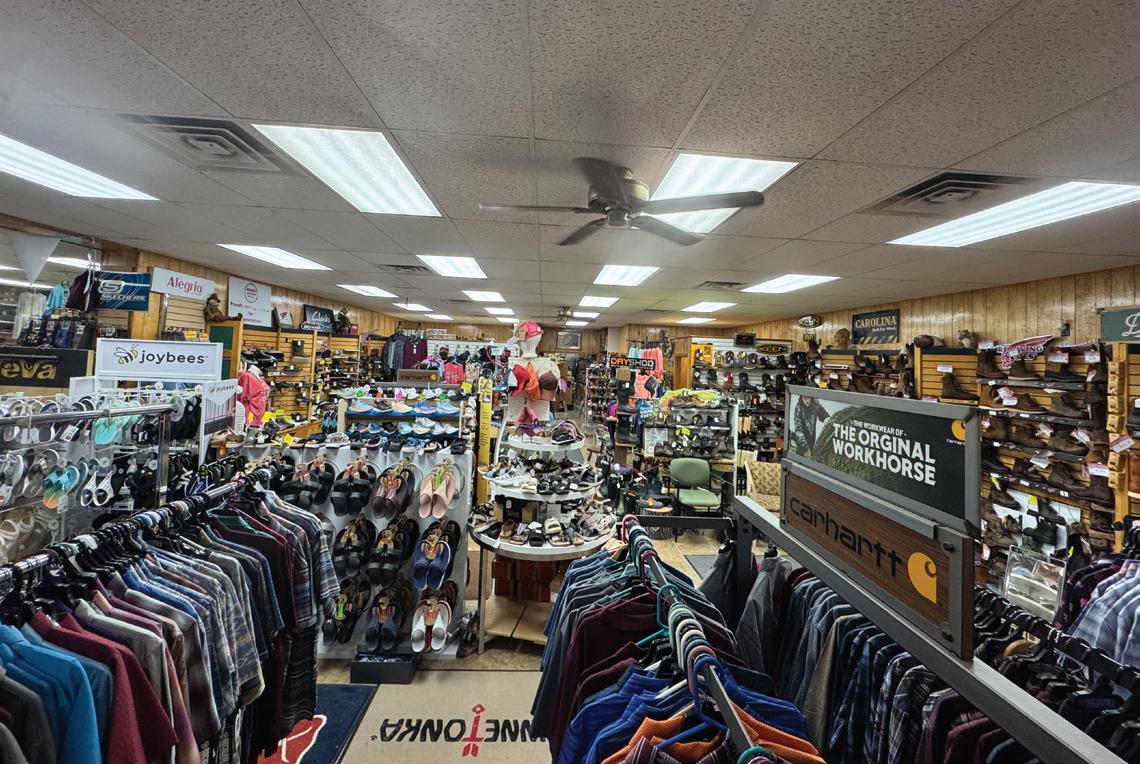
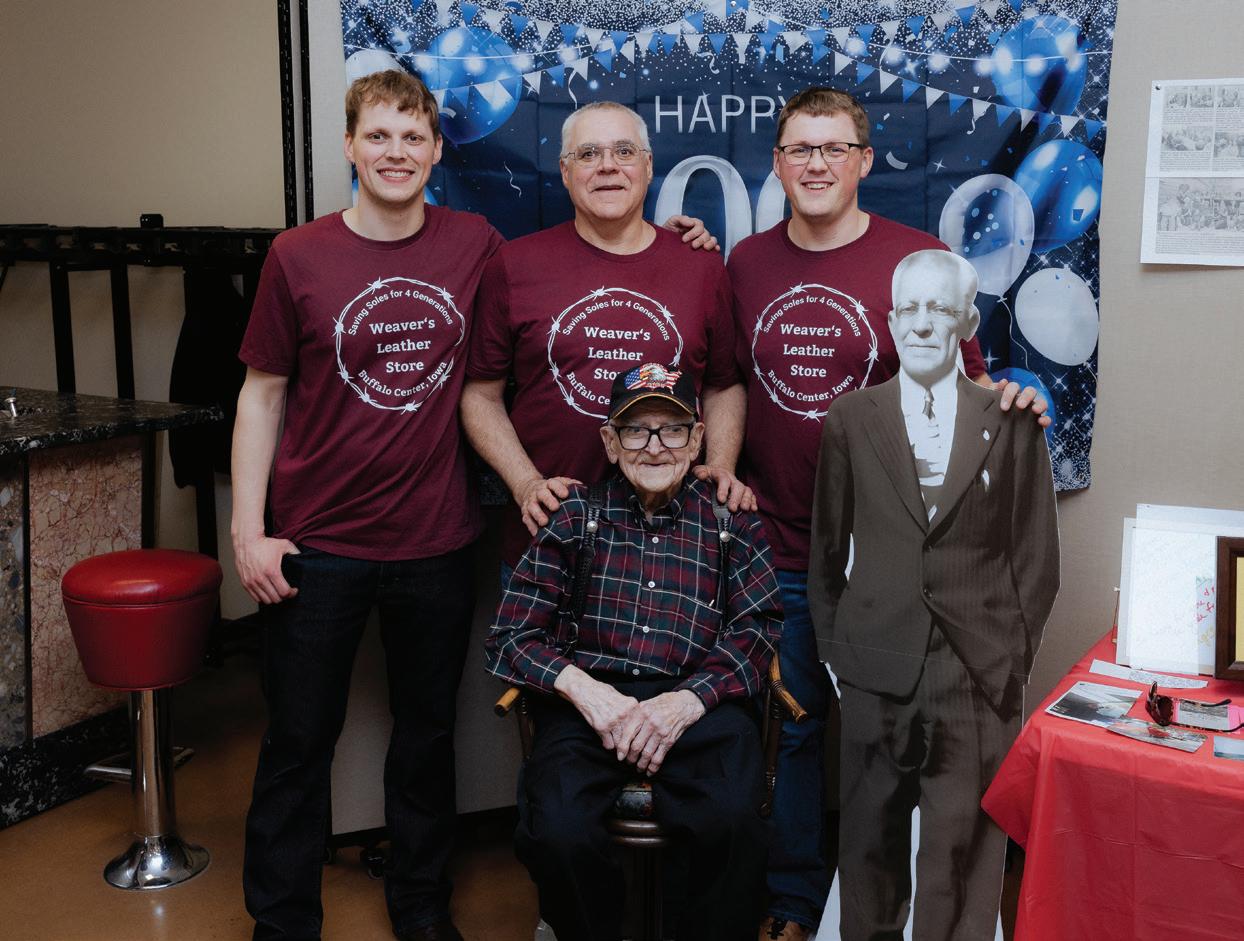
Facebook ads and is putting the finishing touches on a store website that’s set to launch by September. “We won’t sell online, but we’ll be able to promote new products,” he explains.
Colin was the driving force behind another practical update. “We put in a point-of-sale system to help keep track of our inventory and our inventory movements,” says Colin. “Now, if a customer calls and asks if we have a certain style, we don’t have to run to the back room to look. We can look it up on our POS system. We can also input all the orders. The system makes it a lot easier to ring up clothing, and it means we’re no longer writing out receipts.”
For years before automating, the Weavers handwrote prices on the tops of shoe boxes, calculating in the tax. When Buffalo Center residents took stacks of receipts to their tax accountants, they often included Weaver’s box tops, and some nostalgists still ask the family to write out the price + tax on shoe boxes as souvenirs, according to Julie.
Another old school feature that earns the Weaver family its loyal fanbase is their skill in repair work, from resoling work boots to reattaching purse straps to putting new zippers in coats. Fittingly, their motto is “saving soles for 4 generations.”
Colin and Tanner are perfecting their skills with instruction from Tim, who learned the art of leather repair from LeRoy, who learned it from Ted. Though nearly a centenarian himself, LeRoy still pitches in on smaller repair jobs and comes to the store regularly to chat with customers.
Lately there’s an uptick in repair requests because “People are investing so much money into shoes now. They want them to last longer,” says Tim. There’s also considerable demand for
orthotic build-ups. Tim estimates that he handles seven to eight such jobs every week.
“I love going in and seeing all the generations of their family in the store,” says Johnson. “It’s just so neat that the boys are carrying it on. I get asked all the time ‘Where did you get this or that?’, and I can tell everybody about Weaver’s because I know it will still be there.”
Though the family and their store have faced plenty of challenges over the years, from Ted’s untimely death and LeRoy’s auto accident to brands undercutting their retail partners by selling on Amazon (a trend the Weavers believe is fading), theirs is a story of determination, perseverance, sound judgment, grit, and plenty of heart.
“We’re very blessed,” says Tim. “What are the odds of having three generations getting along and working together to keep a business going?
“We deal with a lot of very loyal companies, and we appreciate every one of them,” he continues. “They know they’ve got to keep brick-and-mortar buildings going because people want to go in and look at the selections, try shoes on, feel how heavy they are, and buy in person.”
The Weaver clan is equally grateful to the community that has supported it through thick and thin. To show their appreciation, they celebrated their centennial this past May not with a blowout sale but with an open house at the local Heritage Town Center, where they served more than 800 people free pork loin sandwiches, potatoes, and beans—all accompanied by live music. Everyone who stopped by got a reusable shopping bag with a 10 percent coupon, but sales were the last thing on anyone’s mind that day. “It wasn’t about making a profit,” says Colin. “It was about saying thank you to our customers.” •
1925: Ted Weaver founds Weaver’s leather store as a harness and shoe repair shop.
1930: Ted begins construction on the current location on North Main Street.
1950: 19-year-old LeRoy takes over the store after his father, Ted, passes away.
1952 : LeRoy is drafted into the U.S. Army during the Korean War. He asks Red Wing to hold his account open.
1954: LeRoy returns from Korea. He buys 36 pairs of Red Wings and re-opens his store.
1958-1978: LeRoy gradually expands his inventory and the building housing his store.
1979: Tim steps in at age 14 to help LeRoy in the store after LeRoy is in a car accident.
2004: Tim and his wife, Julie, take over as owners of Weaver’s.
2012: The store expands again.
2017: Buffalo Center turns 125. LeRoy is named Grand Marshal of the parade during the town’s celebration.
2025: Weaver’s Leather Store celebrates its 100th birthday.



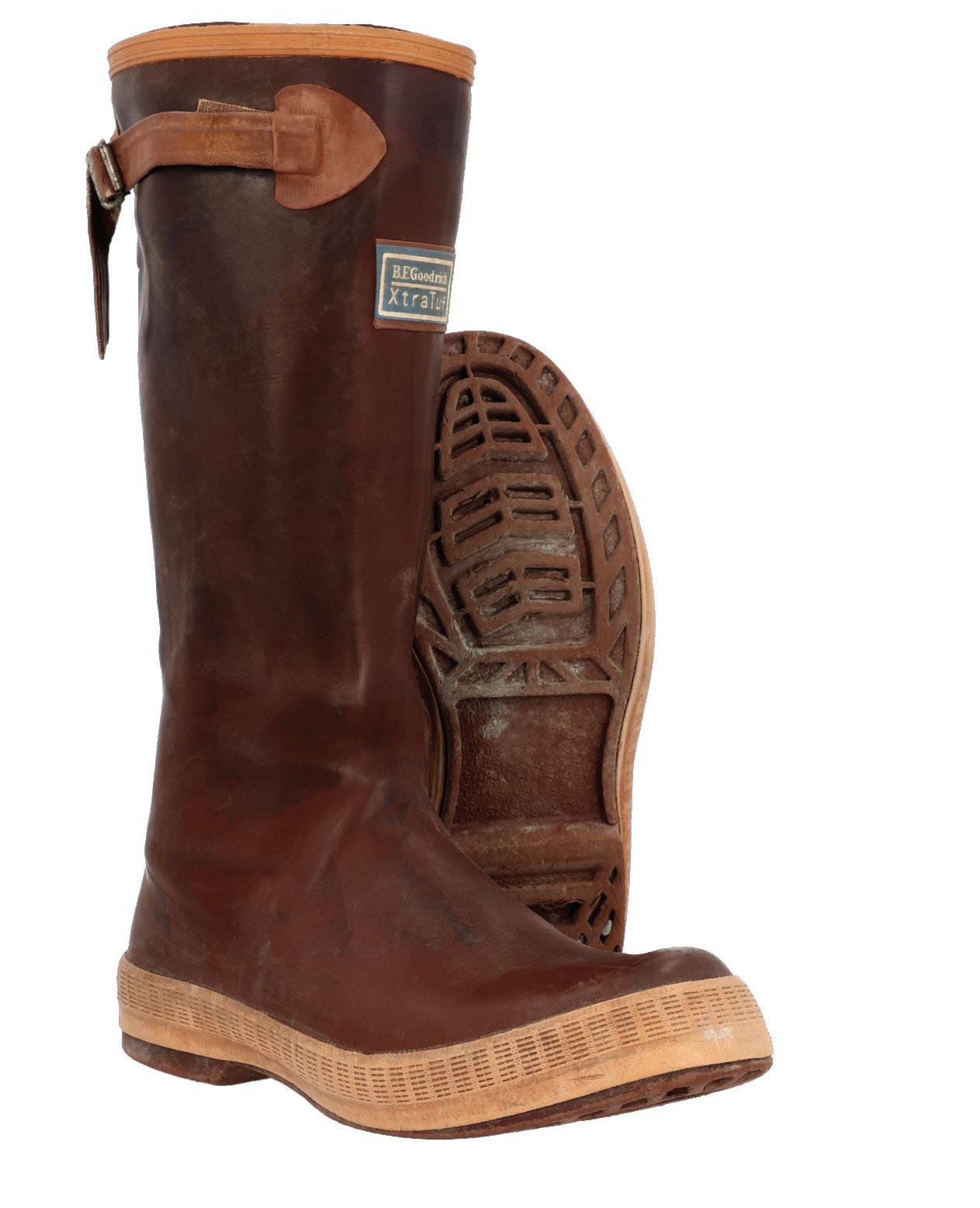
The 75-year-old performance fishing brand is having a moment, reeling in a wider audience of fishermancore fashionistas and tailgaters.
By Kiernan McCormick
“The Ankle Deck Boot has created its own unique market almost overnight,” says Mike Roundhouse, vice president and general manager of Xtratuf, a division of Rocky Brands. “It’s built to be functional and keep you comfortable, safe, and dry all day while fishing, but the style and colors also resonate with college kids who love its easy, laid back styling. And it’s spreading out from there.”
TRATUF BOOTS, an Alaskan style staple, can actually trace its roots back to Midwestern dairy farmers some 75 years ago. During summer fishing trips to the 49th state, these hardworking individuals introduced a boot so sturdy, waterproof, and warm that locals took notice. The boots’ soft, vulcanized bottoms allowed fishermen to feel the boat deck, including any rope or gear underfoot. Knowing that can be a lifesaver. Indeed, Alaskans saw how well the boots performed on and offshore, and were quickly hooked, pun intended.
Flash forward about 70 years and Xtratuf’s utilitarian attributes began being discovered by another audience. Namely, southern college kids seeking the perfect outdoor party shoes. That would be the brand’s Ankle Deck Boot style, specifically. Xtratuf quickly caught wind and has since expanded with the Ankle Deck Boot Sport style that matches up with 26 college and pro team colorways as part of its popular Tailgate collection. If you’re going to do a folding table body slam before a Buffalo Bills game, your feet might as well be warm, dry, able to launch with a firm grip, and represent the team’s blue and red uniforms, right?
The Ankle Deck Boot fan base is spreading rapidly, which now includes women’s and kids’ collections. Everyone is on board with its utilitarian properties that are spiced up with colors, prints, and collabs. In fact, the style now ranks as the brand’s best-selling silhouette, outpacing the original Legacy Boot.
“Ankle Deck Boots have become quite a staple,” affirms Caitlin Rokicki, senior designer/developer for Xtratuf. “We’ve focused on providing a range of colors and prints that work well with an everyday outfit or occasion. We have more trend-based colors but also combinations that are a bit more grounded that you can wear with mostly everything.”
Marisa Babbitt, DMM of Electronics/Apparel and Footwear at West Marine in Fort Lauderdale, FL, says the Ankle Deck Boot is the store’s best-selling Xtratuf style. “Everybody can’t have enough deck boots,” she says, noting the store recently partnered with the brand on a “beautiful flag-printed Ankle Deck Boot” exclusive to West Marine. The style blew out of the store.
Collabs are a way to keep Xtratuf’s classic silhouettes fresh across men’s women’s, and kids’. Partners to date include Alaskan lifestyle brand Salmon Sisters, Anchorage women’s fishing company FisheWear, marine wildlife artist and conservationist Guy Harvey, chef and YouTube personality Brad Leone (highlighted by a fleece-lined Ankle Deck
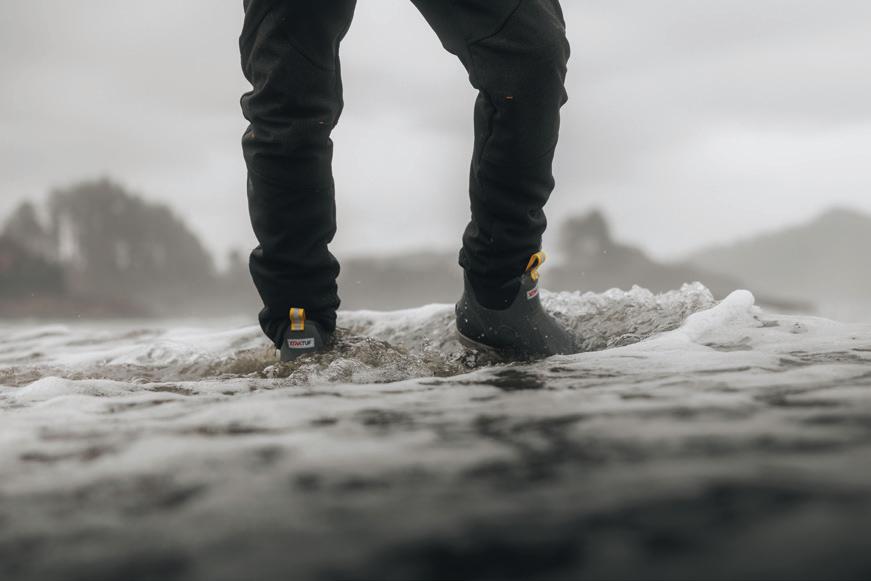
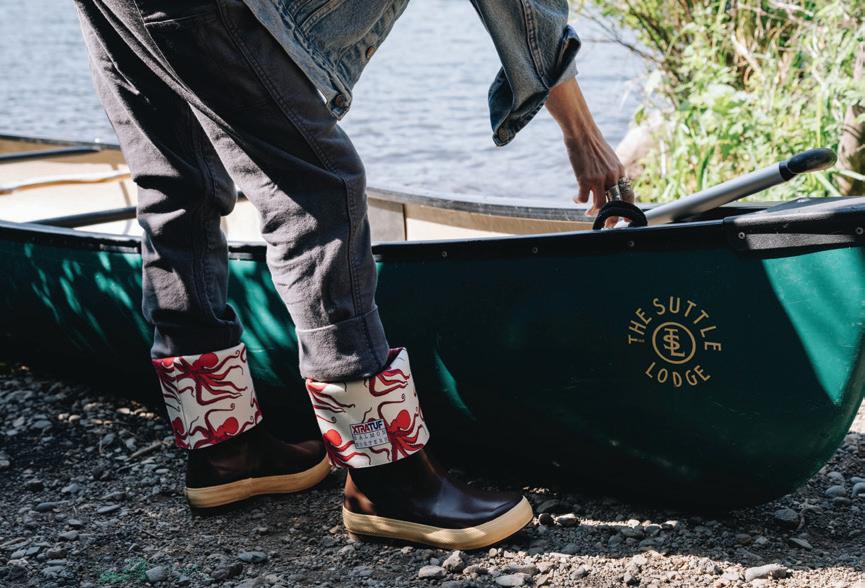

Boot Sport style), professional surfer Andrew “Cotty” Cotton, and golf and lifestyle brand Malbon.
Of course, Rocky Brands CEO Jason Brooks saw this huge growth spurt and product expansion coming when the company acquired Xtratuf, in early 2021, from Honeywell Safety Products. Not exactly. Brooks admits his initial expectations were relatively low, given its smaller size compared to the company’s other brands, which include Rocky, Durango, and Georgia Boot, among others. However, by the end of the first year, he began to suspect Xtratuf’s larger, long-term potential.
Perhaps there was something brewing in the water—and beer. Plus, the fact that, historically, Americans have had an ongoing love affair with utilitarian shoe brands, be it Crocs, Birkenstock, Dr. Martens, Hunter Boots, Red Wing, and Ugg, to cite a few. The beauty is seen through the lens of the performance features, comfort aspects, and versatility. Brooks’ intuition proved correct as the brand now ranks as the strongest in the company portfolio as of this year. “I’m very proud of how our team has embraced Xtratuf and been able to drive the business to new heights,” he says.
According to the Juneau Empire, in the 1950s, tire company BFGoodrich commissioned Norcross Safety Products to manufacture what would become known as the Legacy Boot. The boot’s slip-resistant, non-marking Chevron outsole was patented by William Gottlieb in 1972 for Chromalloy Corporation. This pattern provides a strong grip in wet and icy conditions to this day.
“The brand was built on the loyalty of the Legacy Boot’s early adopters, taking the vulcanized, triple-dipped, 15-inch footwear from the dairy barns to Bristol Bay,” says Roundhouse. “That’s the collection that made Xtratuf what it is today, and it continues to be the cornerstone that has let us expand our reach to other parts of the fishing and water communities at large.”
Carl Johnson, outdoor sales and marketing
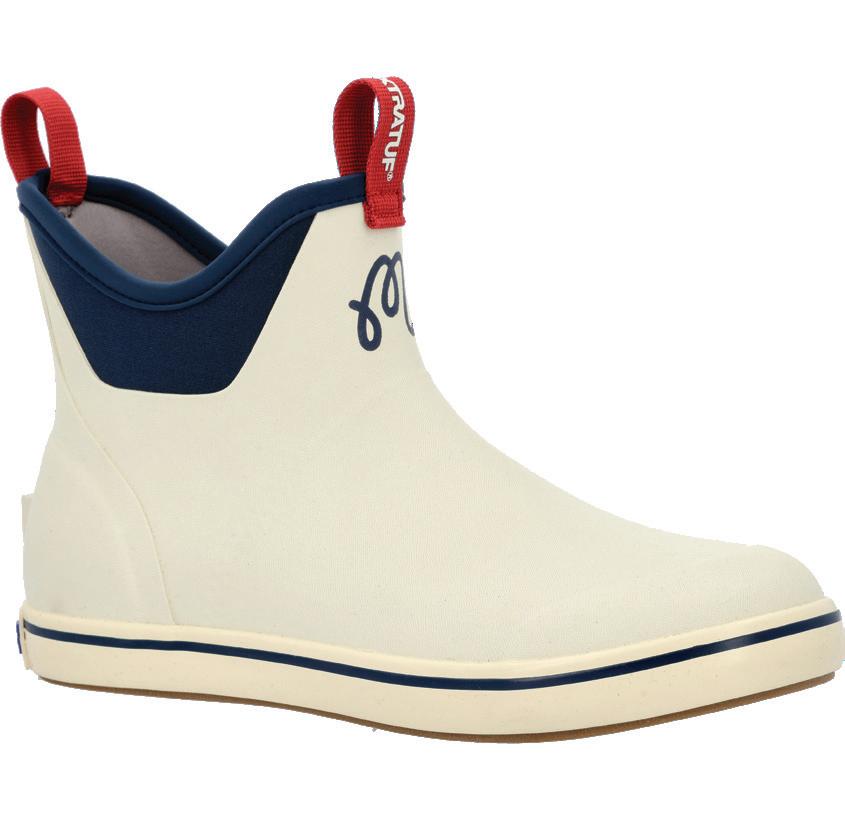

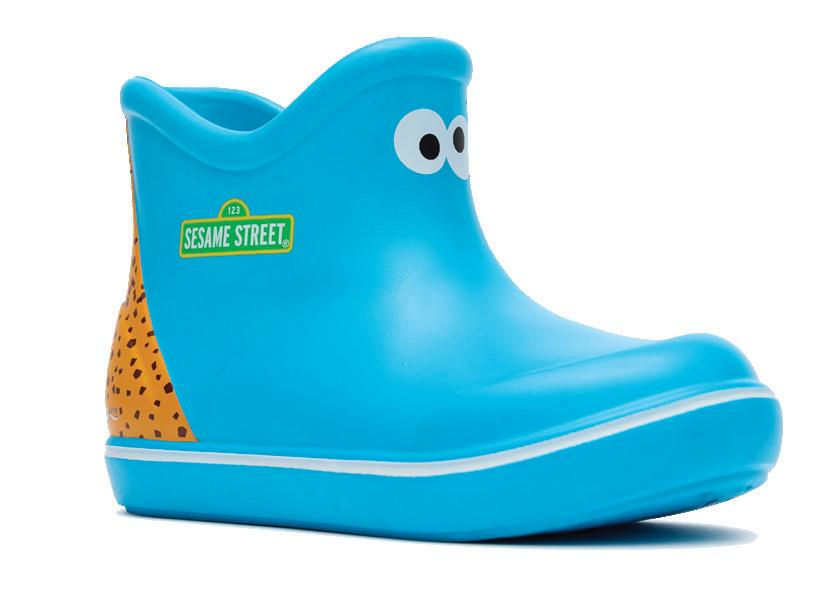
LFS Marine in Bellingham, WA, says the men’s 15-inch Legacy Boot is a top performer. “If you’re a commercial fisherman, that’s the boot you need if you want to be safe,” he says.
Doug Kern, owner and general manager of Fisherman’s Landing Tackle Shop in San Diego, has been selling Xtratuf boots for 30 years. The store carries the brand’s two most popular styles. The Legacy Boot is the preferred choice to withstand the rigors of long fishing trips. “The product quality has remained consistently high,” he says. “They’re great for commercial fishing.” Kern adds, “Xtratuf came early in the game, so several companies have tried to knock off their styles. But once something is established as the mainstay, it’s hard for people to want to replace it with something else.”
Xtratuf refuses to rest on the laurels of its two iconic styles, however. For example, the brand will debut the Drift Tech Ankle Deck Boot Sport collection for Spring/Summer ’26. It features Biolite EVA, a one-piece foam material that has been granted a Green Leaf certificate by Intertek, an accredited independent third-
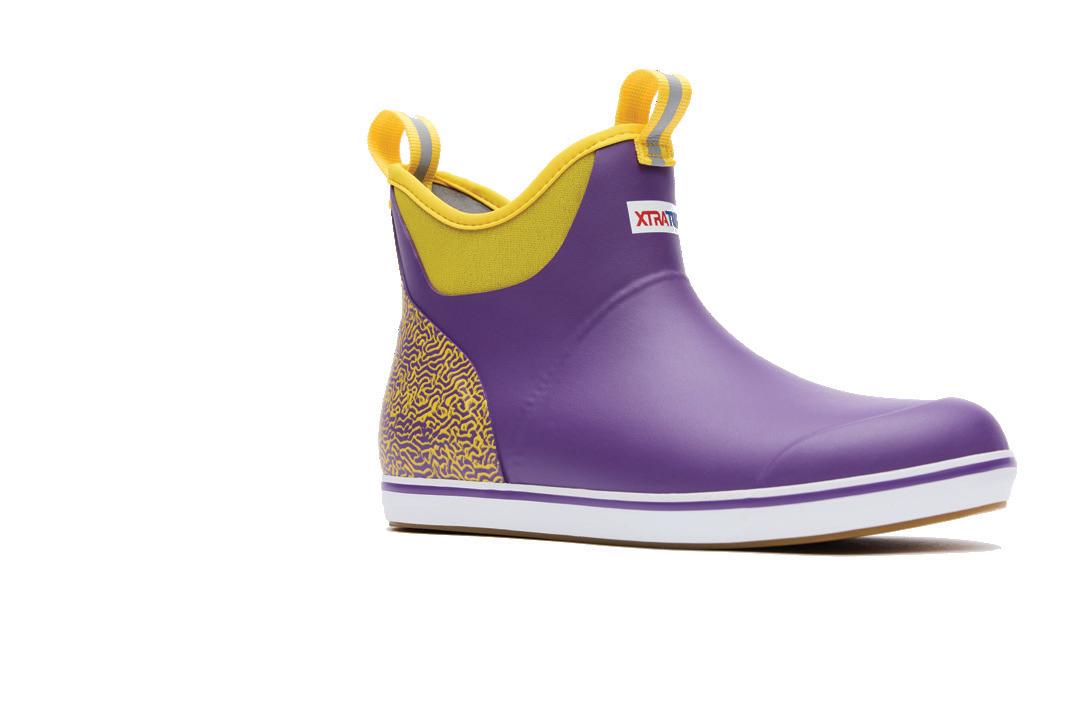
party testing facility, verifying that the material will properly biodegrade in bioreactor landfills. “We’re utilizing this compound in outsoles, midsoles, to fully injected product,” Rokicki says, adding, “It has resonated well with our customers from an environmentally friendly aspect and the comfort and performance it provides.” Other features include a drainable upper, midsole, and outsole and an anti-microbial knit Drift Tech lining.
The current fishermancore trend is also contributing to Xtratuf’s strong growth of late. The brand falls right in line with the fashion aesthetic that emphasizes practicality, durability, versatility, comfort, and a connection with nature. New retailers are requesting meetings, Roundhouse reports. The team is willing to listen, but one aspect will remain constant about Xtratuf: “We don’t design for
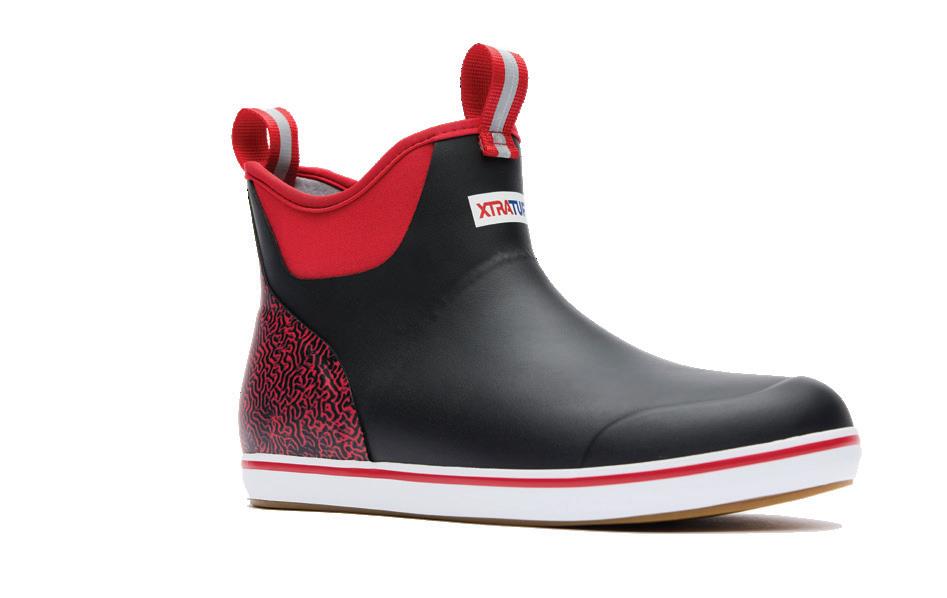

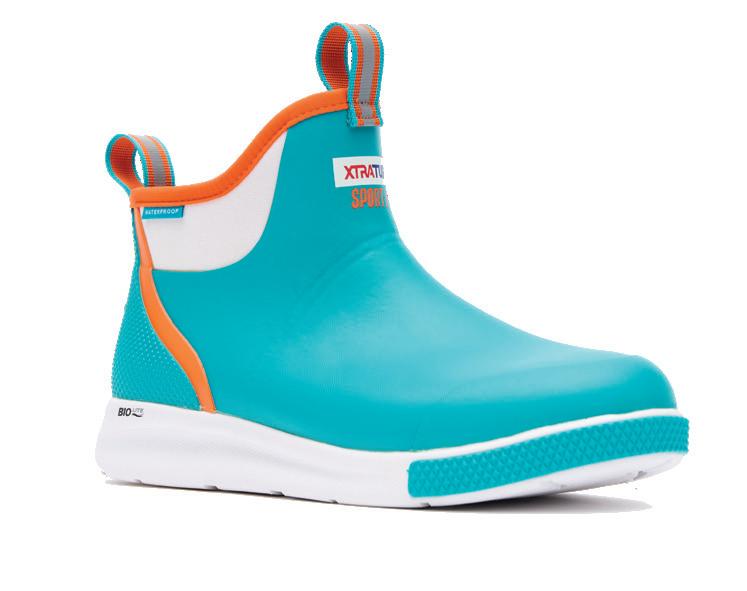
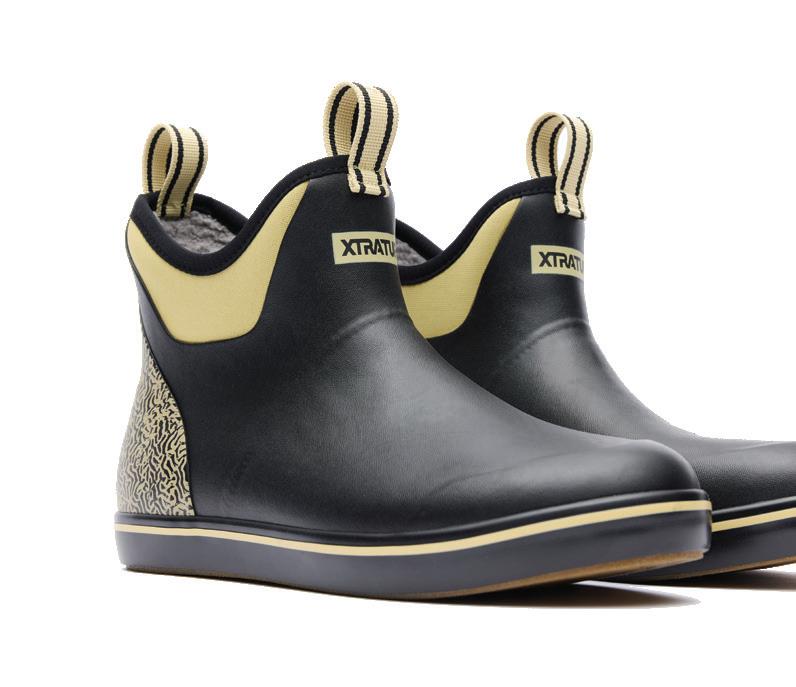
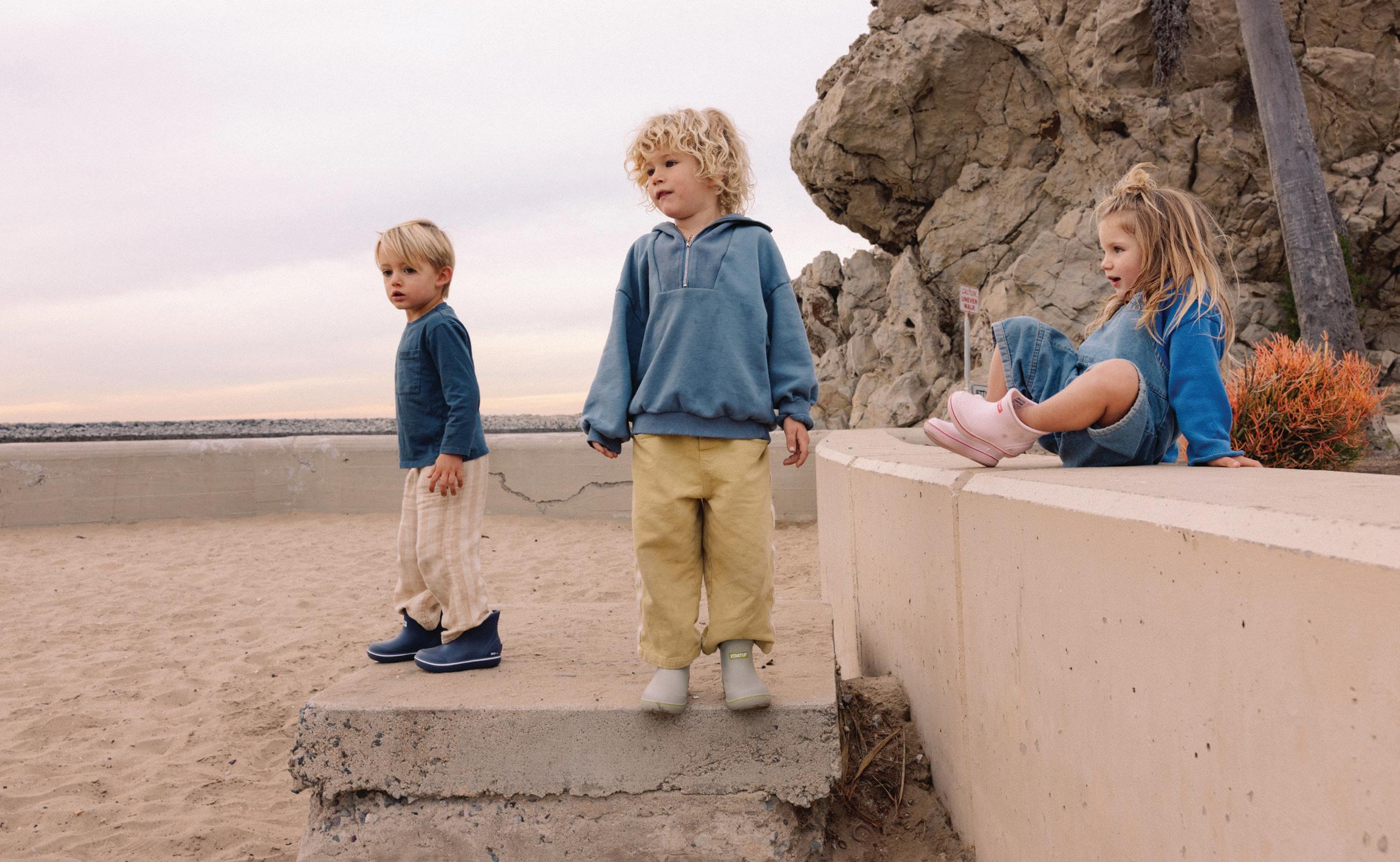
fashion,” he says. “I’ve always said function creates its own fashion. When you’re a trusted brand like Xtratuf and your classic, rugged, authentic silhouettes come into favor with a new segment of consumers, then it’s a fun ride.” The key, Roundhouse adds, is meeting the increasing demand without letting the wheels fall off.
So far so good, reports Kern. “When we place an order with Xtratuf, it comes in almost 100 percent,” he says. “We rarely have even one zero, and that’s hugely important to our business.”
Likewise, Laura Martinez, vice president and director of merchandising at Palmetto Moon in North Charleston, SC, appreciates Xtratuf’s diligence regarding the restocking of popular inventory. “They’re great partners to work with,” she says. “They’re getting their lifestyle and fashion pieces in stock at depth levels that can really benefit the velocity they’re driving right now.”
Xtratuf has expanded well beyond its Alaska base. Roundhouse says the brand now appeals to anyone around water—or a keg—and in need of a comfortable, sure-footed, waterproof boot. “The versatility
of our products has created a fan base built on stylish performance and individual needs,” he says. “Everything we build is based on the idea of nocompromise performance, so even if it’s someone’s favorite dog walking boot on a rainy day, they know it was built to be tough enough to handle the demands of Alaskan fishermen.” Same goes for golf course and turf management professionals who sport the Ankle Deck Boot in wet and muddy conditions. And a growing number of skiers who wear the fleece-lined style to and from the slopes.
Martinez believes Xtratuf’s staying power lies in its utility and performance. Keeping dry, warm, and sure-footed never goes out of fashion. “Xtratuf started as a functional brand, and it has since been translated into an everyday fashion lifestyle product that resonates with all walks of life,” she says.
But the brand will never cut bait on its loyal Alaskan fisherman customers. Roundhouse believes this commitment to product authenticity is what sets Xtratuf apart from many other footwear brands. “Alaskans don’t have time to waste on a boot that doesn’t perform and meet the needs of a day that can change at a moment’s notice, and they need to be ready for anything,” he explains. “And we know
that if we build a product for that customer, it’ll work for just about anyone. So we make no compromises in materials, quality, and features.” Roundhouse adds, “That way we know we’re being true to the customers who’ve trusted us for 75 years.”
Speaking of that milestone, Xtratuf will celebrate the product that started its journey with special collab with the sneaker boutique Hometeam Seattle. It will launch during the Pacific Marine Expo this November. “We’ll be showing off our Legacy collection in a fun, new way that we believe will resonate with all our consumers as well as new ones,” Roundhouse says. Stay tuned for details. For Roundhouse, 75 years is a testament to Xtratuf’s consistent performance, no matter the elements. Those span Bering Strait extremes to kids splashing in puddles in their local park. “Our boots perform for people when it counts and, in turn, they’ve relied on them for 75 years and counting,” he says, noting it isn’t a one-way relationship. “If Xtratuf boots don’t meet the needs and demands of our customers, they’ll find another boot that does. Reaching 75 years means that we’ve stood the test of time and continue to deliver what our customers need.” •
Jennifer Hazard, regional sales manager for OS1st and former long-time independent retailer, reflects on diving into the deep end of life.
DEAR JENNIFER…Happy 18th birthday! This is a pivotal year in how your life unfolds. It’s kicked off by saying yes to swim for Florida State University and moving from crisp Boise, ID, to steamy Tallahassee. Strutting onto the pool deck as a big fish from a small pond, you quickly discover that everyone’s a big fish in Division 1. Life lesson: Train as hard as you can.
I’m happy to report that you excel at swimming—earning All American honors in the 100 meters breaststroke, in fact! Credit goes to your core traits of loyalty, resilience, and determination—attributes that get you through a whole lot of challenges later in life. Your teammates become lifelong friends. Your fellow Fashion Merchandising majors, however, never quite warm up to the gal who filters into class with wet hair and sans makeup. “It smells like bleach in here!” snarks one while wrinkling her nose. For the record, it’s chlorine, and after five hours a day in a pool that’d be her signature scent, too. No worries. You learn to navigate snippy classmates, even if you’re forever a fish out of water. Because you’ll never figure out how Southern women manage to look perfectly put-together in that humidity!
When senior year internships are announced, you receive a coveted placement: Neiman Marcus in Bal Harbour, FL. You suspect family friend Robert Comstock had a hand in this, and that’s OK. Life often runs on who you know and how you show up. So say yes and drive that VW Cabriolet convertible to Miami. You have a wild time and meet eccentric people. Like that trip to Peru, courtesy of two free plane tickets from a customer. You and your roommate have a New Year’s Eve story to remember complete with bulletproof vests, hand grenades, riots, and returning to Miami a week early in unmarked planes. Life lesson: The world does not always go according to plan! The internship goes swimmingly. You learn a lot about retail and how to work. You have strong opinions about the latter. In fact, you let one slip during a glass elevator ride with Neiman Marcus corporate honchos. “How’s the internship going?” one asks. You say, “Fantastic, except for the rule that women must wear skirts and pantyhose.” You inform them that you can’t afford a new pair every few days. You also tell them that you were told pants make women’s butts look big. “Sounds like a lawsuit to me; I’d change that policy,” you say as you exit with a smile and a wave. A few weeks later the “skirts only” policy is gone. Life lesson: Don’t be afraid to speak your mind.

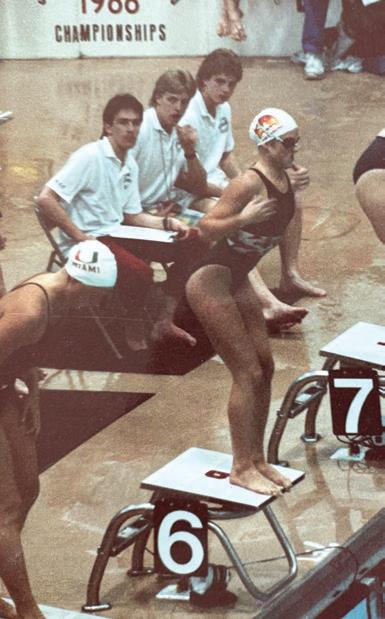
zipper, a bartender next door, and pliers. Cheers all around the bar! Soon after, you receive an offer to move to Hailey, ID, to manage North & Company, a pet project by retail geniuses Roger Fleenor, a family friend, and Karl Dollman. The store is a unique mix of moderate to better apparel, shoes, and bedding. They also run The Merc, a 21-store chain offering clothing, shoes, homegoods, and groceries that serve as the lifeblood of many small towns in Idaho and Oregon. Your first impression of Hailey, however, isn’t good. It’s the dead of winter, frozen dog poop decorates the sidewalk, and sleepy Main Street boasts two bars and a pizza joint. Nonetheless, say yes to this life-changing offer. For starters, Karl puts you through the retail paces and you go on to earn a master’s degree in open-to-buy, management, advertising, community engagement, etc. The building is 100 years old with a tin ceiling. The basement was originally the city jail. There’s history here. You sell Red Wing, Dansko, Birkenstock (before its cool), Ugg (before Oprah), Sorel, Nike, and Teva, among others. Over the next 23 years under your guidance and eventual ownership, North & Company becomes much more than a “store.” It’s a gathering place for the local community. Regulars pop in often just to chat, and the holidays feature long lines of customers waiting for gifts to be hand-wrapped. Your dedicated staff feels like family. You train and watch 15-year-old hires go off to college. You raise your daughter on the salesfloor. There are worse ways to earn a living.
Once an unknown dot on the map, Hailey becomes home to Bruce Willis and other rich-and-famous types. Say yes to opportunities this wonderful resort town offers—like becoming a member of the City Council, joining the Chamber of Commerce, being named Rotary president, and even cohosting a morning radio show! Your only regret during this time is not asking for assistance when the Financial Crisis hits in 2009. The store runs into deep trouble, but pride stops you from asking for help. You close shop in 2015. You miss the selling floor more than you can imagine. Life lesson: Lean into family and friends when needed.
After the internship, you head home to Boise and find work in a dress shop that smells strongly of hair perm from the salon in the back. It’s a far cry from the glitz of Bal Harbour. One solo evening, near closing, you ponder breaking the rule of no try-ons. A sequined pageant dress has been tempting you with its shimmer. Say yes to breaking this rule. It leads to a memorable “trapped in a dress” story involving a broken
Fortunately, those strong business relationships built over 23 years pay dividends for your next chapter in life. You crossover into wholesale as a sales representative. In 2023, you land at OS1st, a performance wellness company known for its compression hosiery. This is where you work with a growing tribe of retailers who, like you, believe that selling shoes and socks is a valuable service. Specifically, helping customers out of pain is a privilege.
You love OS1st’s mission. And while you may be swimming in a new lane now, you’ve still got a lot of kick left in you. So keep saying yes to exciting new opportunities. And those times it feels like you’re going against a strong current, just keep swimming. Such steely determination leads to a life filled with rich rewards. Dive in!


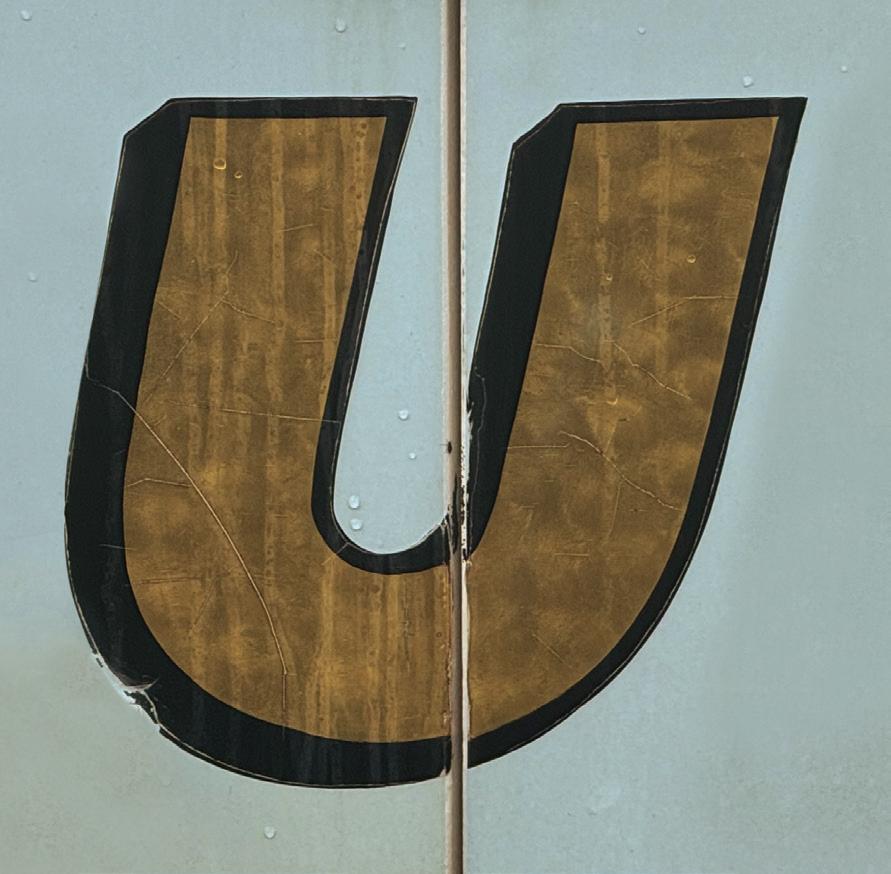
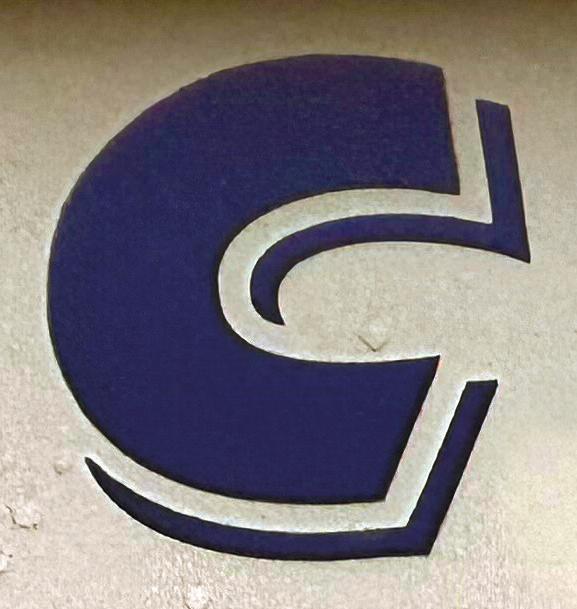
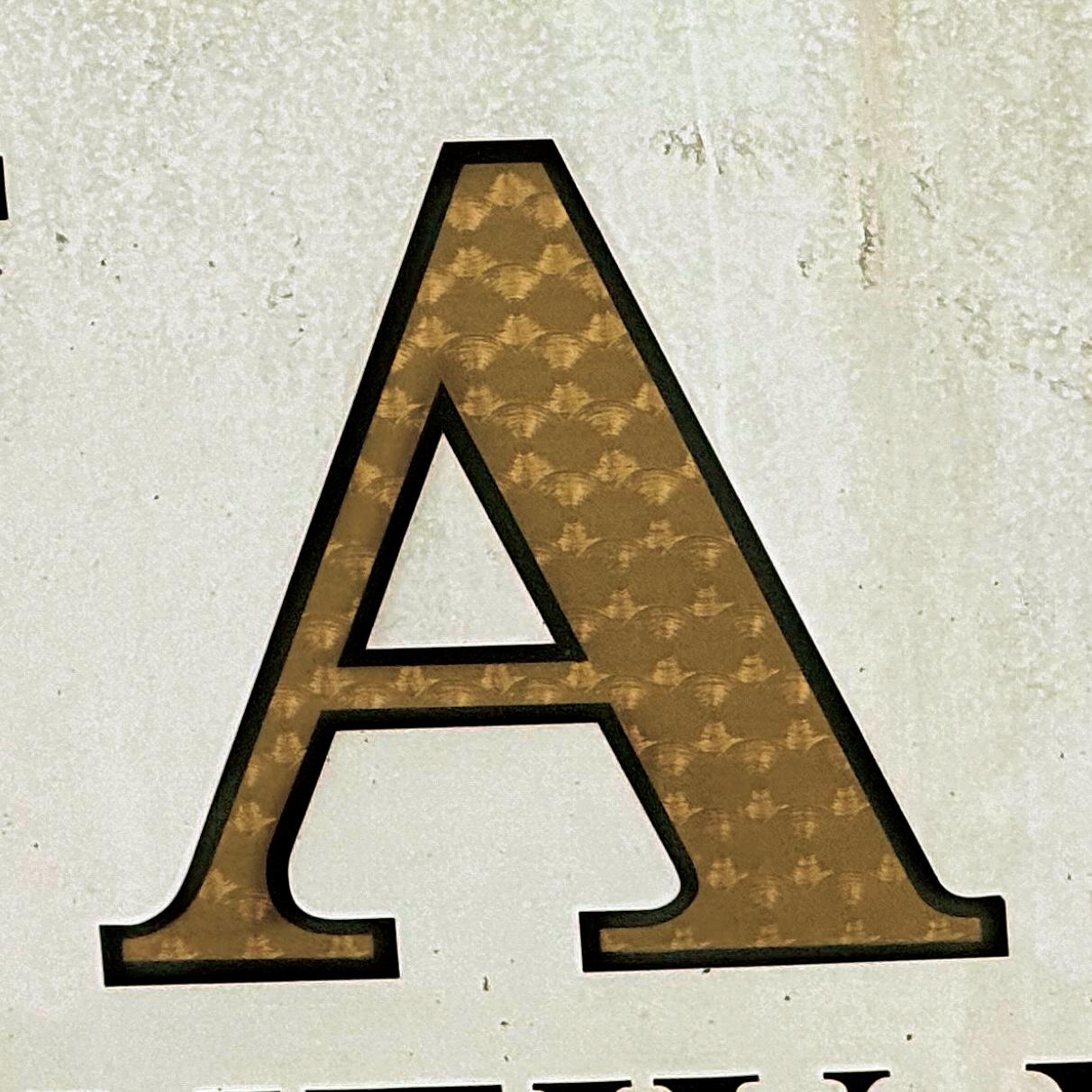

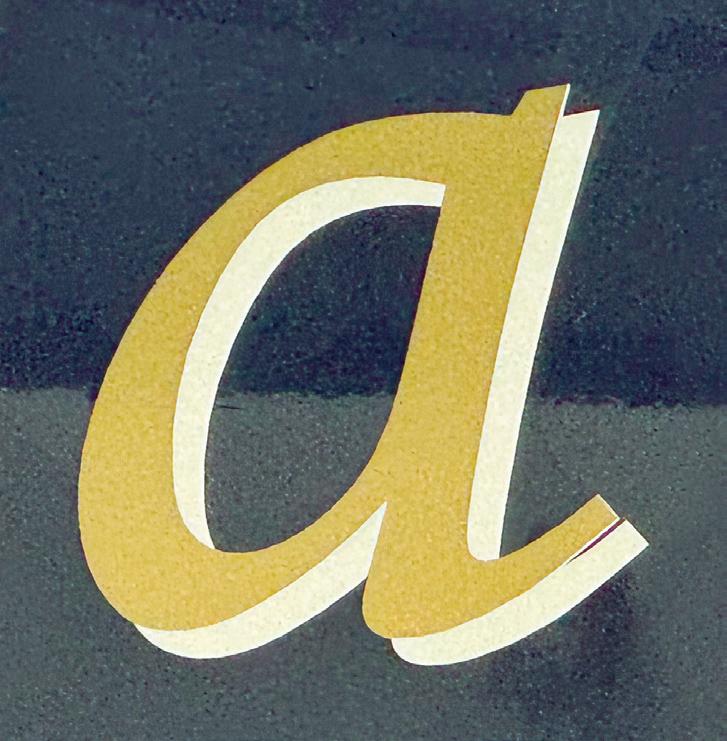



Florsheim elastic lace, slip-on boat shoes with Comfortech footbeds and lightweight EVA outsoles. Opposite page: Boat shoe/moc toe hybrids with molded footbeds, three-quarter length composite insoles, and durable molded rubber outsoles by Twisted X
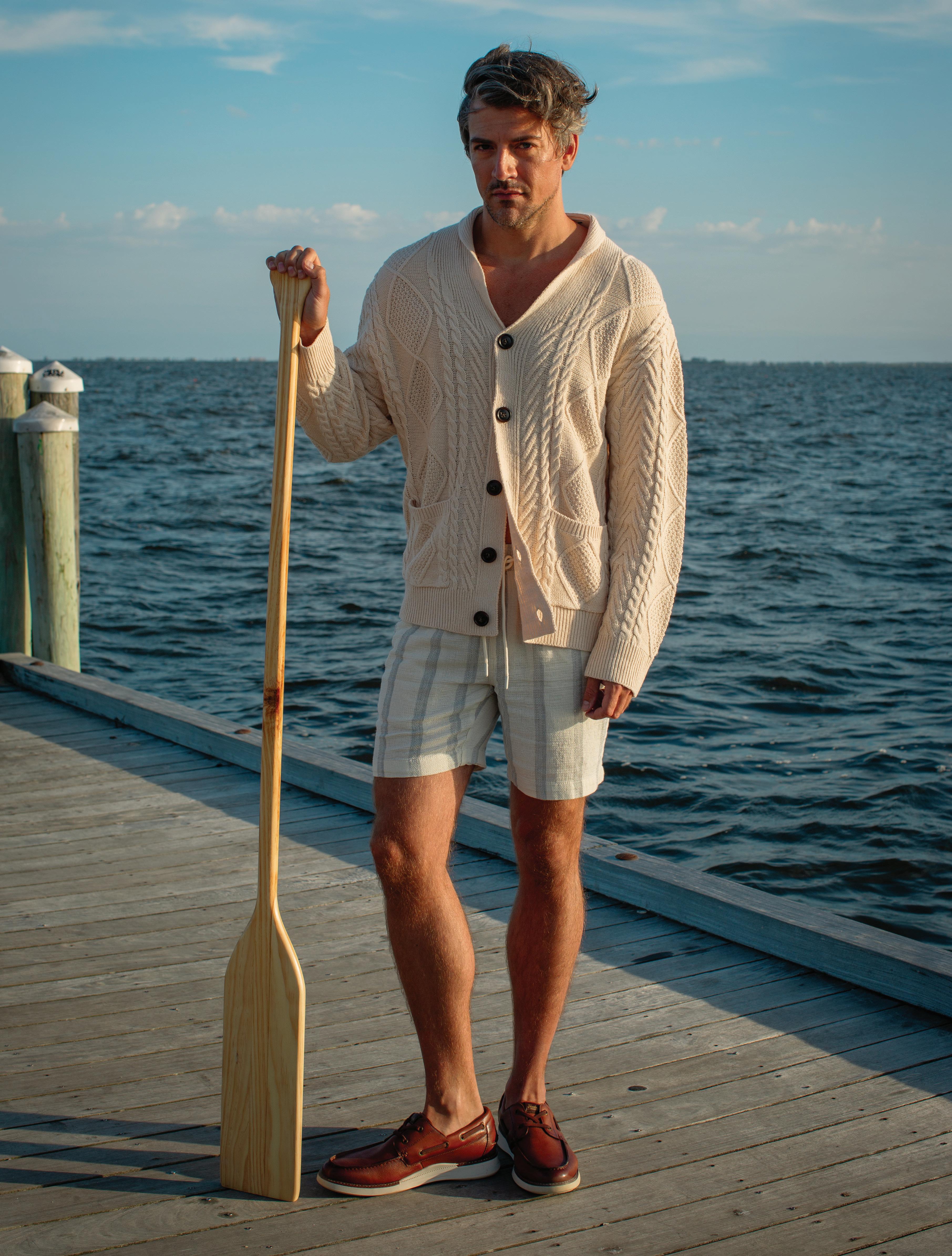
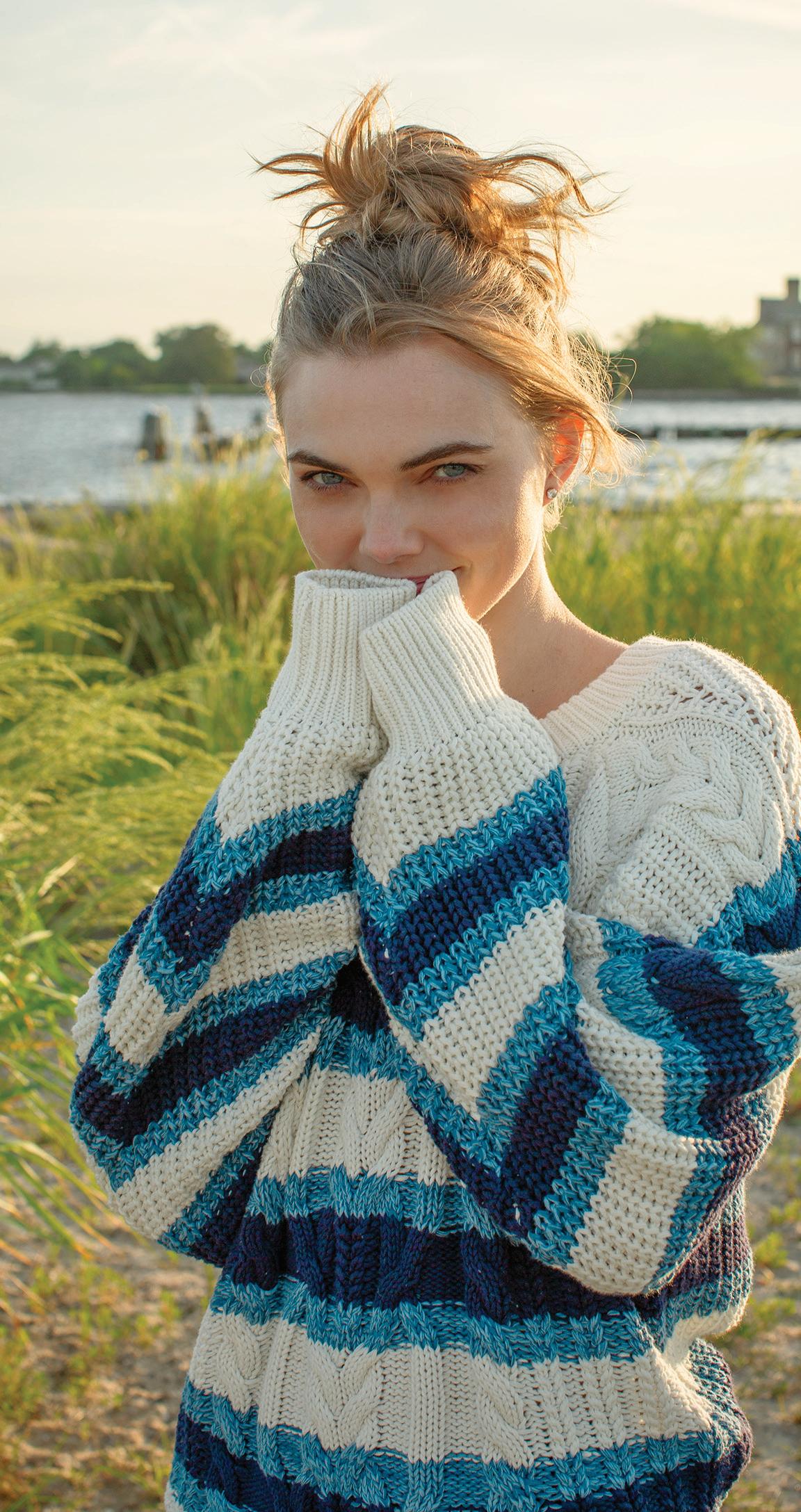
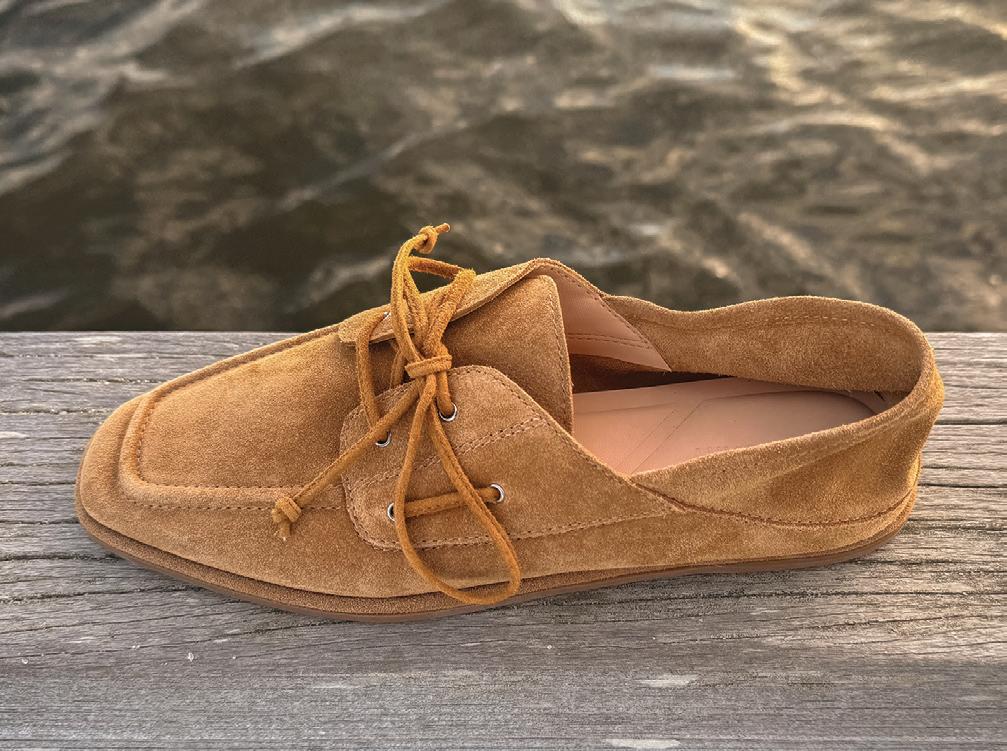

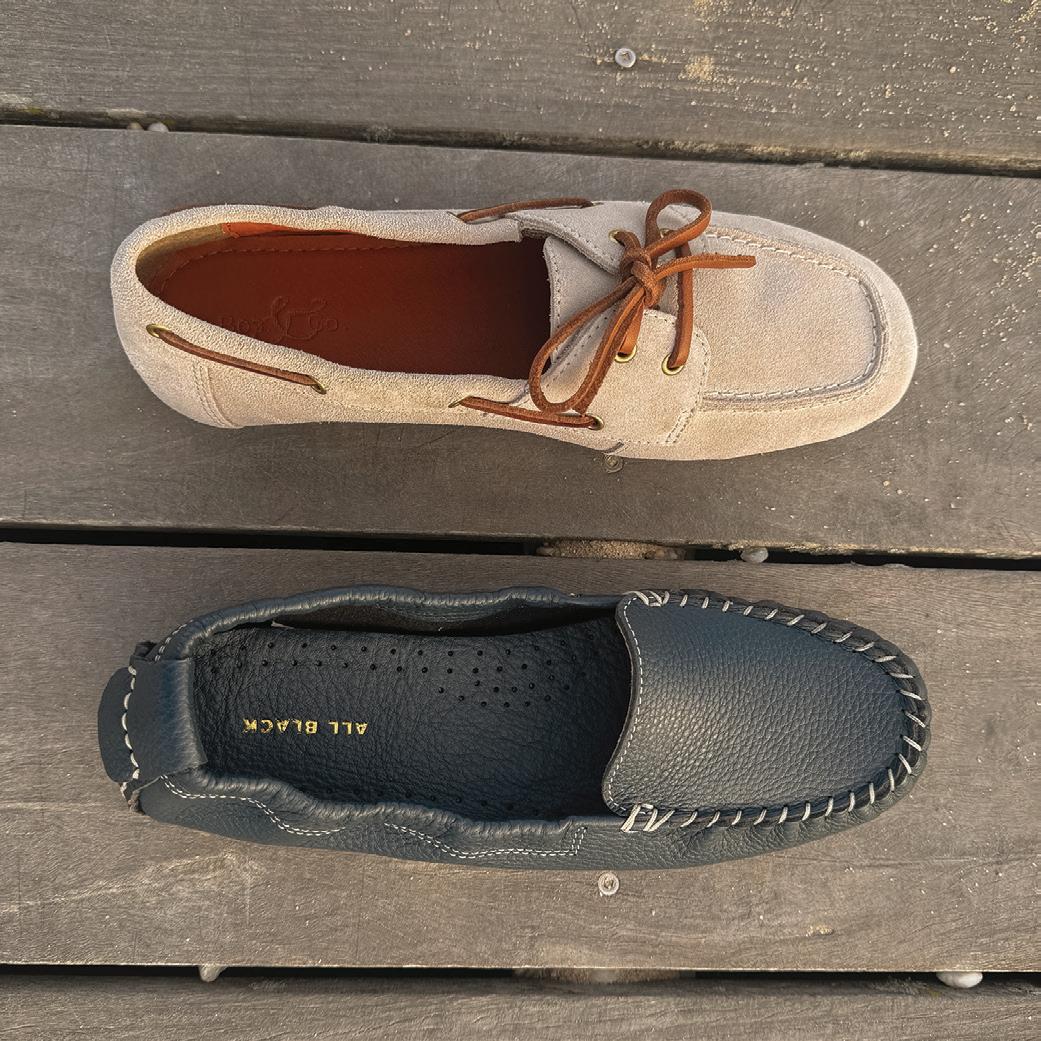

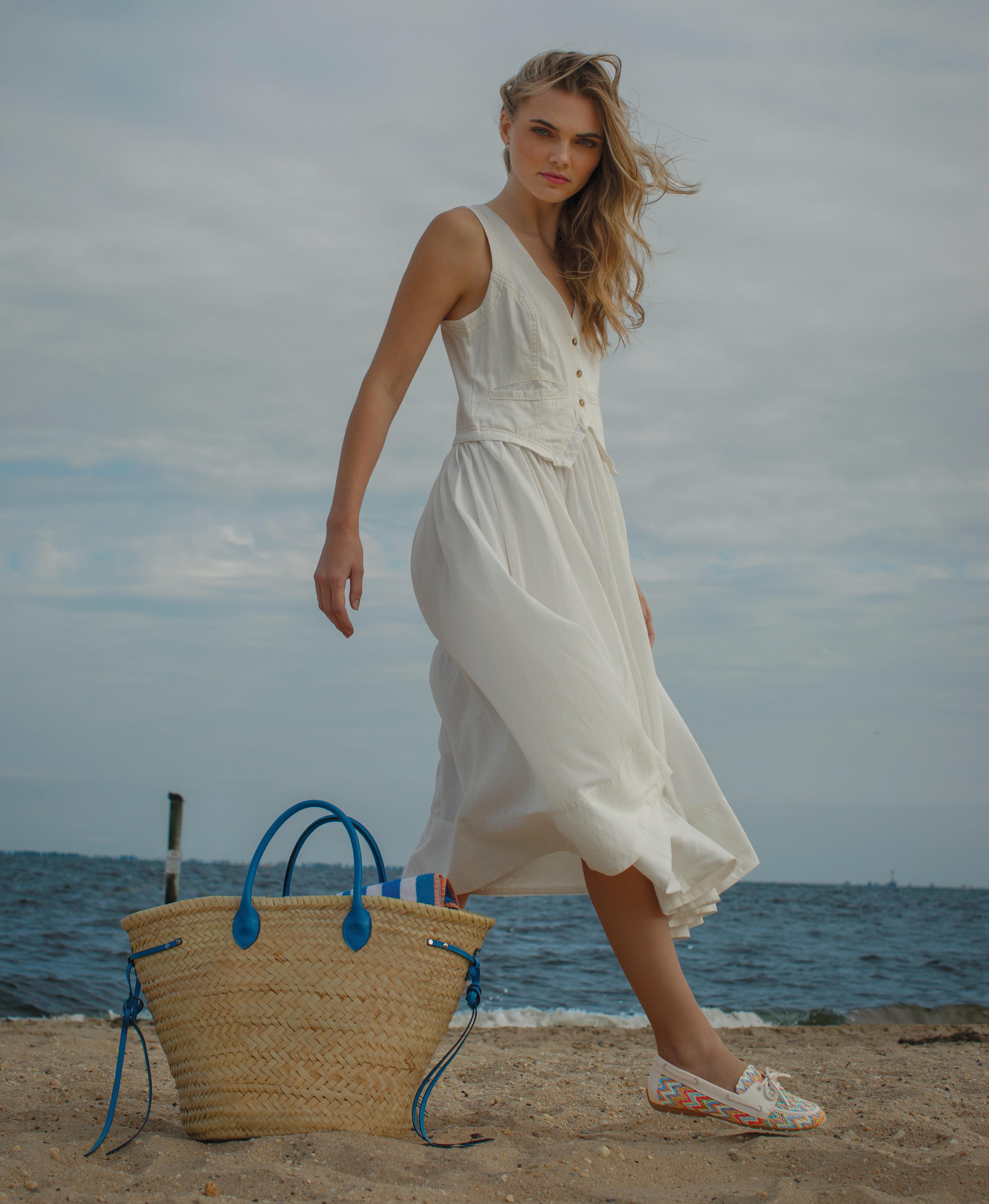

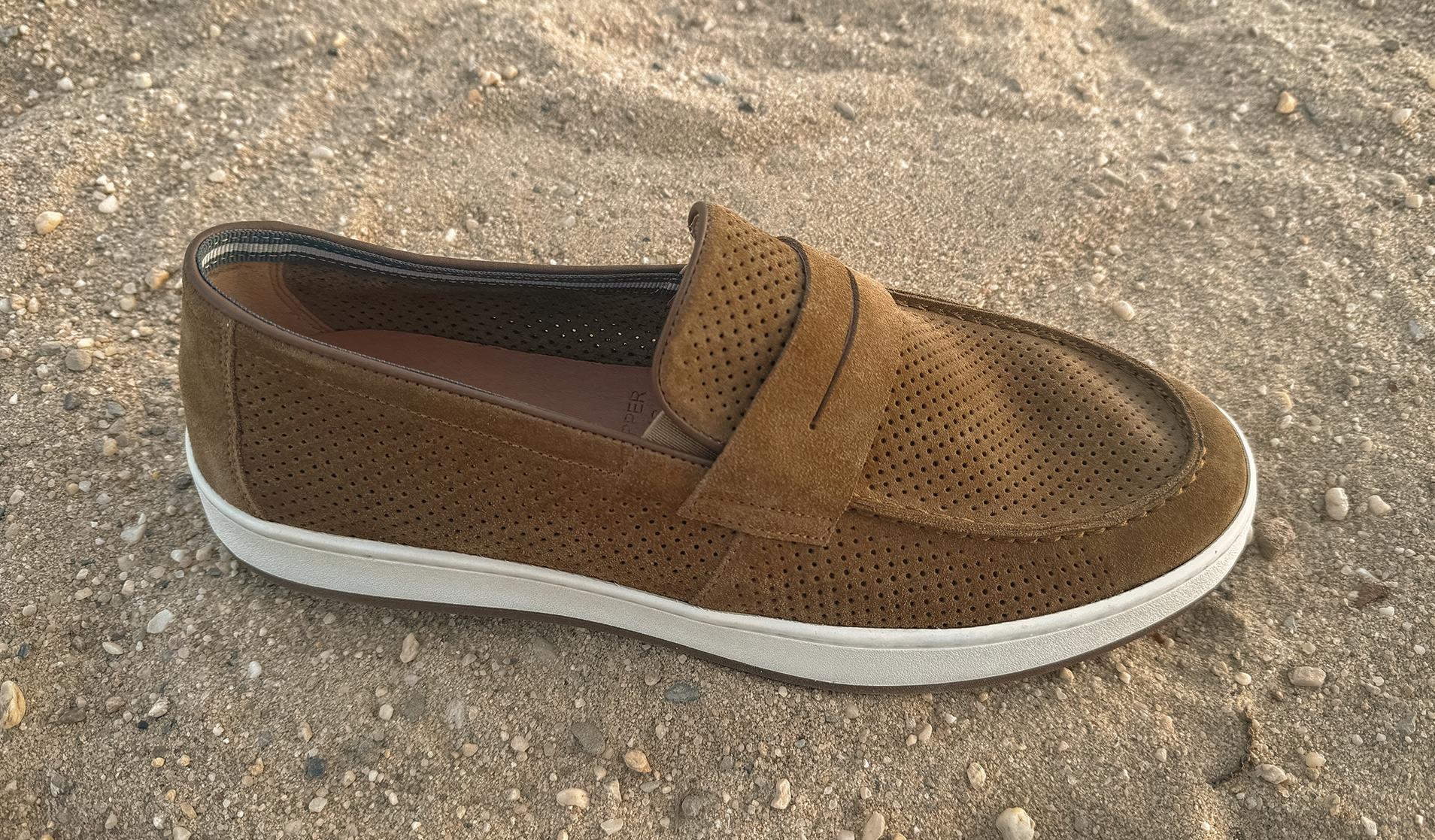




Patrizia faux-leather boat shoes with one-inch heels and flexible soles; Italian leather boat shoe/moc hybrids with natural rubber gommini outsoles by M.Gemi Opposite page: boat shoe-inspired loafers with elasticated sides and removable leather-lined inlay outsoles by Ecco
Photography: Trevett McCandliss; styling: Mariah Walker/Art Department; fashion editor: Kiernan McCormick; models: Ashley Strohlein/Fenton Model Mgmt., Dennis Oehl; hair and makeup: Nevio Ragazzini/ Next Artists; photo and styling assistant: Jamie Wtorkowski.

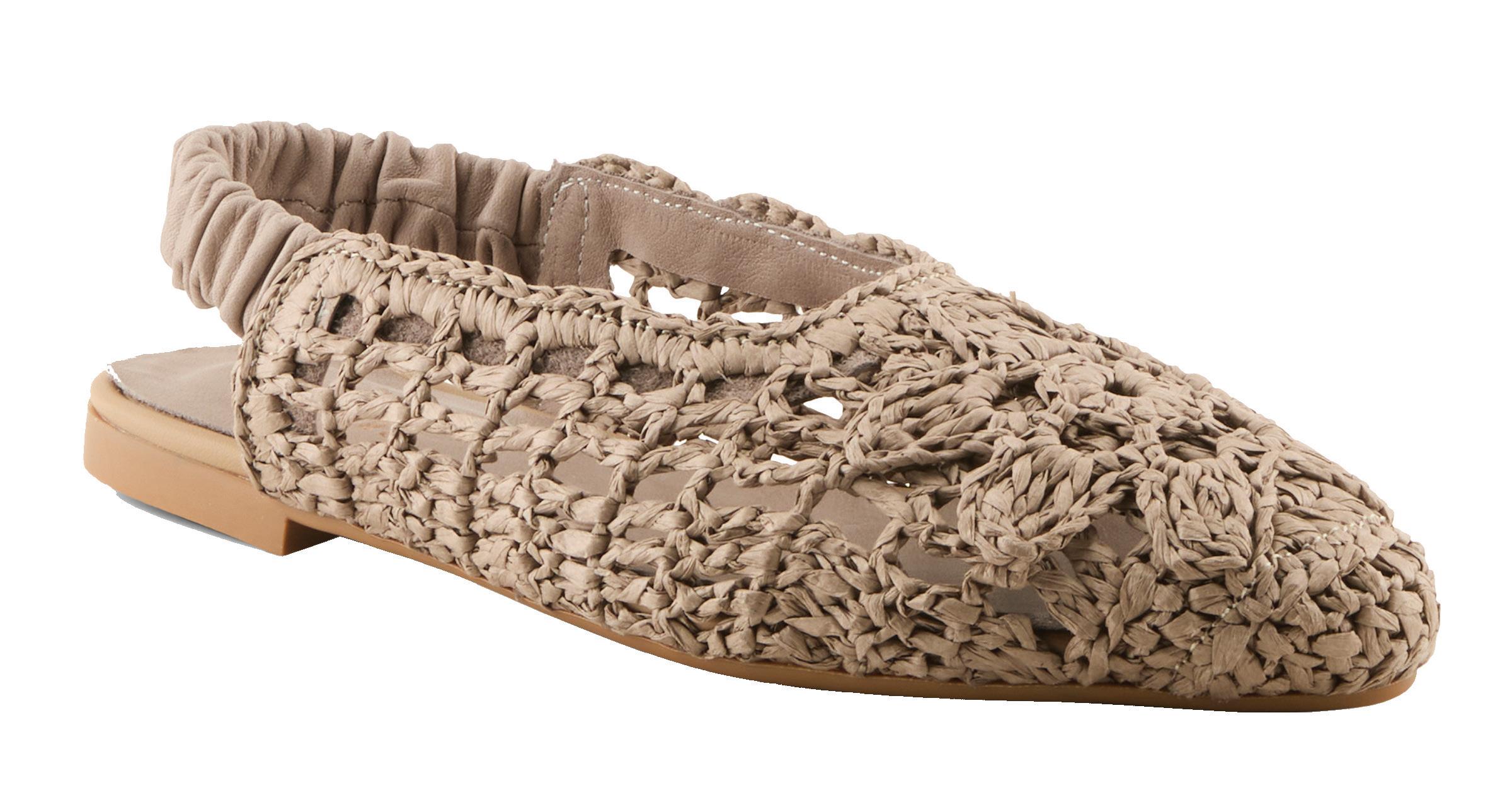
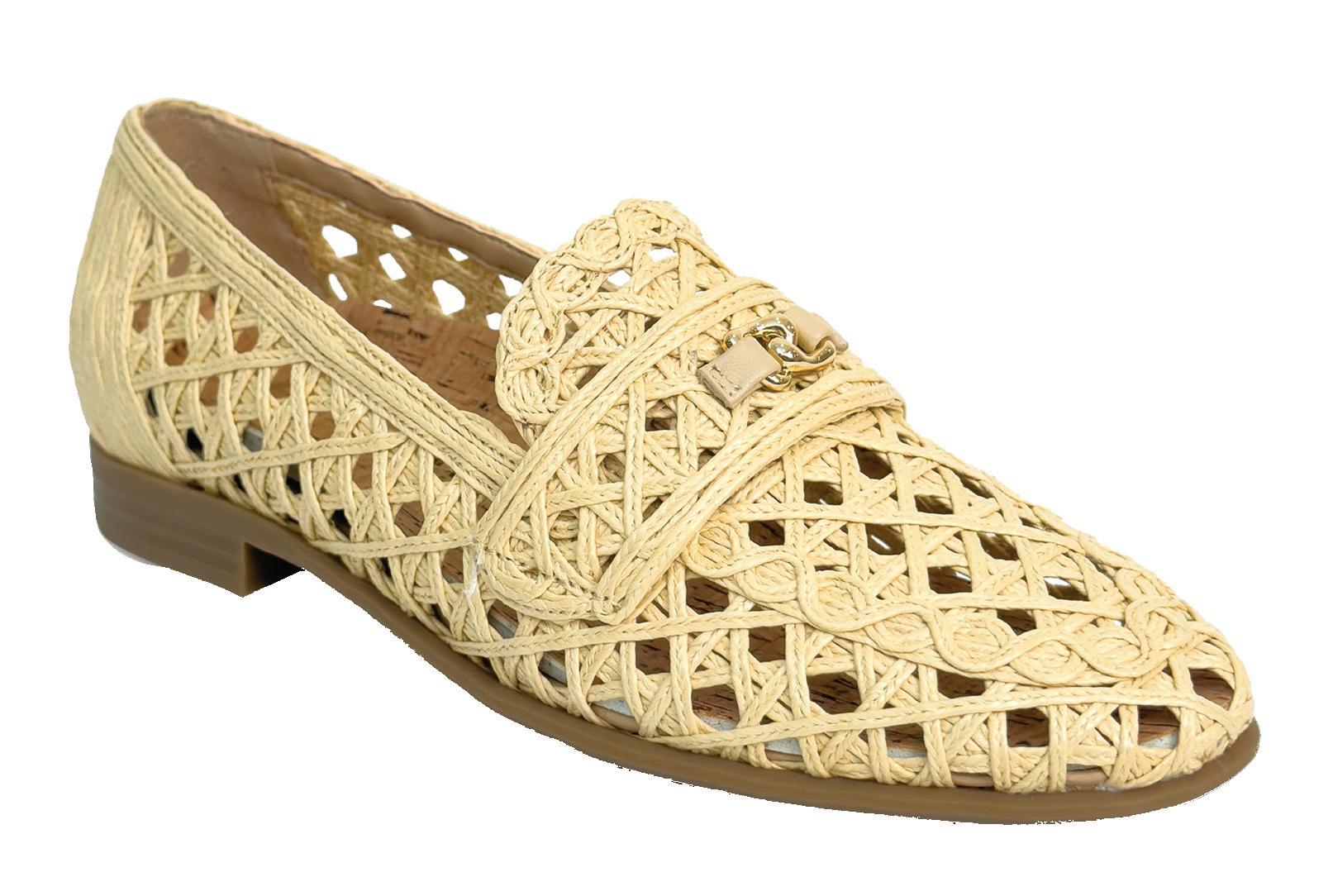
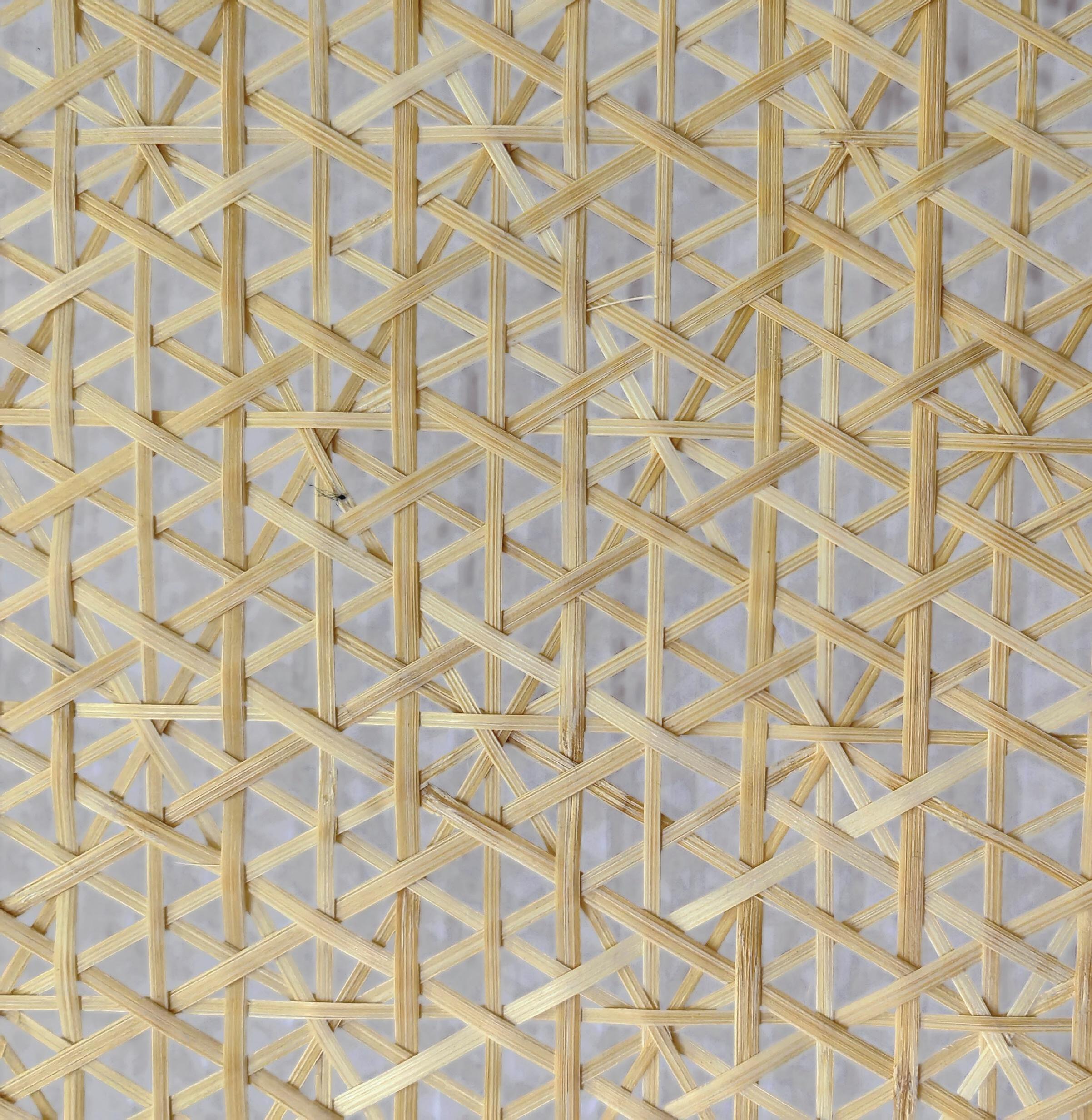


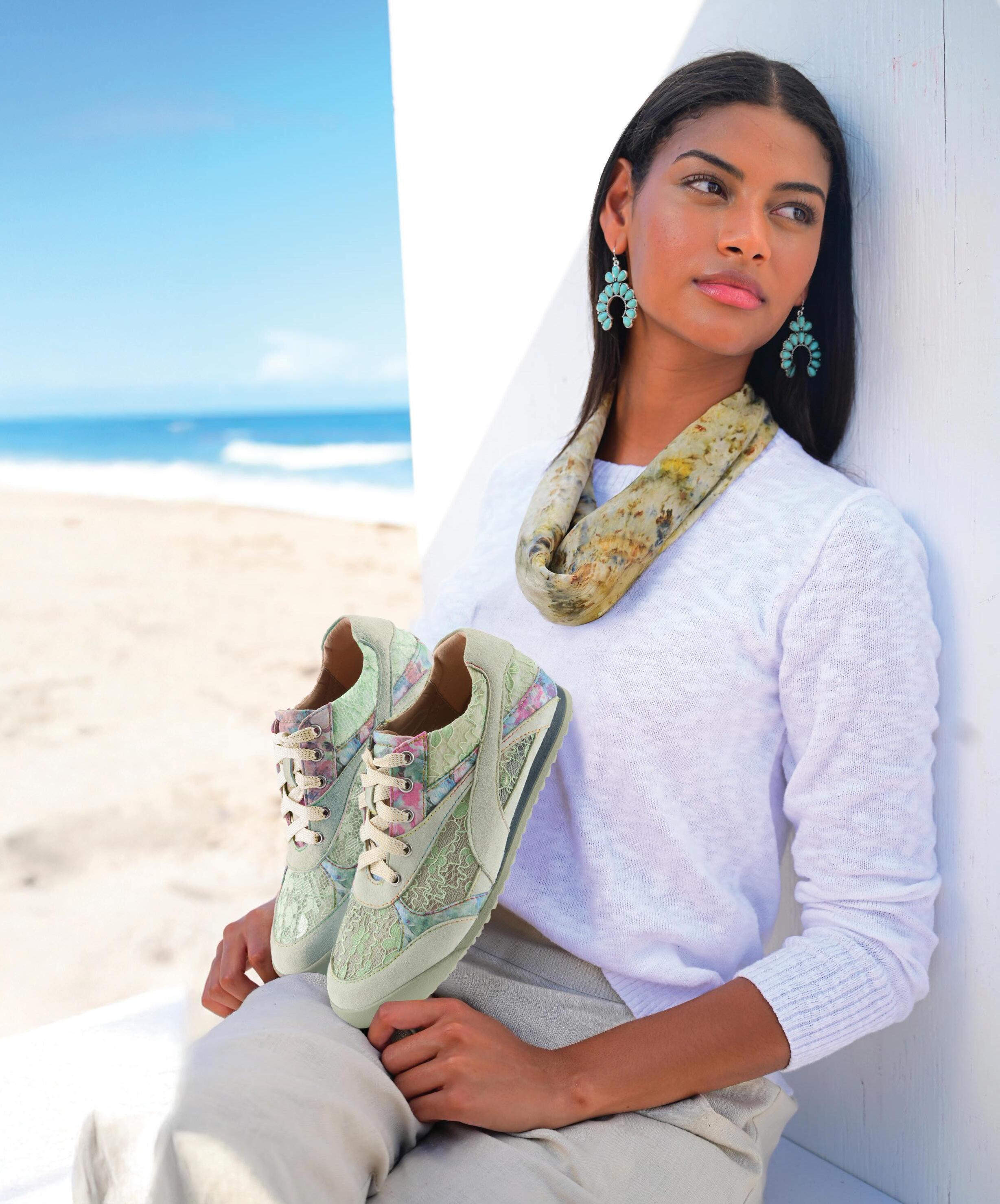
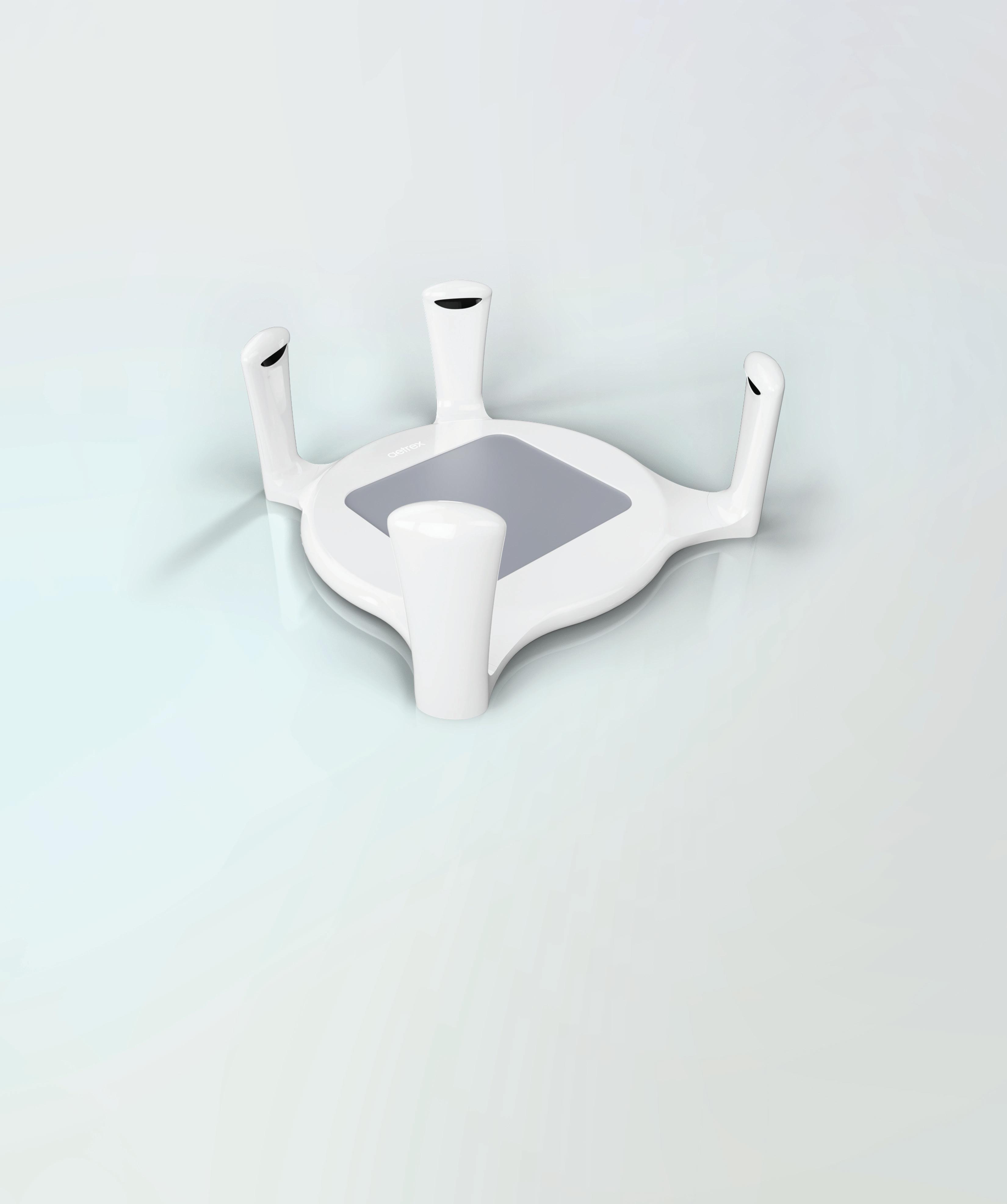
Where Precision Meets Simplicity. Inspired by the way Tesla made game changing technology widely accessible with the launch of Models 3 & Y, we set out to reengineer foot scanning from the inside out. Our mission: eliminate cost and complexity without compromising performance.
In just eighteen months, our engineers successfully removed 260 internal components, fully optimizing
system architecture. Simultaneously, we advanced our sensor and camera technologies to deliver higher precision in a simplifed user presentation.
The final result: the Zoe Pro. A breakthrough in thoughtful engineering, delivering world-class performance at a price that fnally makes advanced 3D scanning widely accessible.
This is the future of shoe ftting. And it fts everyone.
Starting at $1,995 or $55/month

Scan QR code for technical specifcations